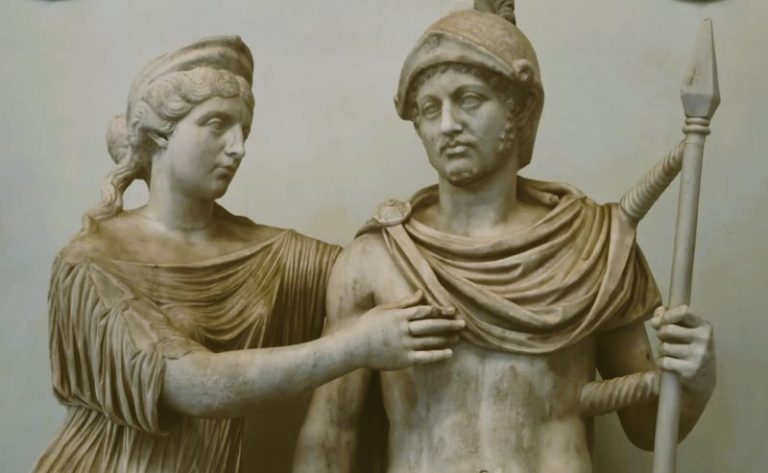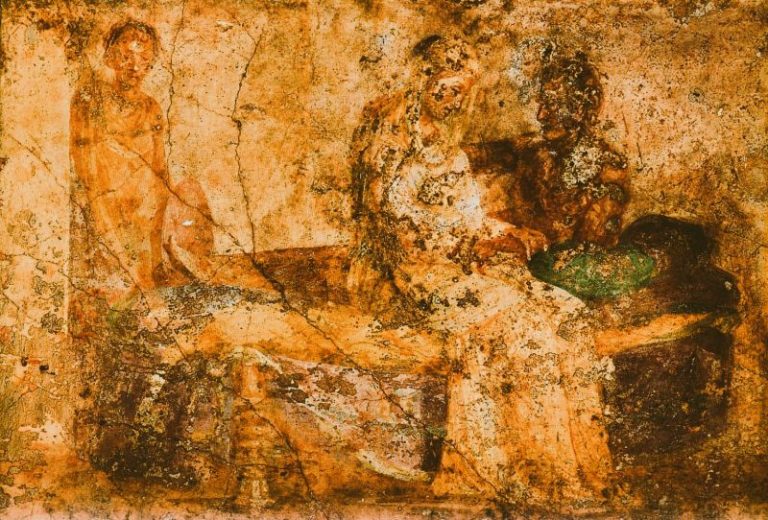
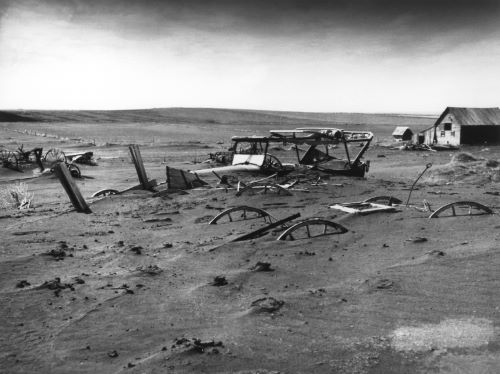
How this turbulent decade ushered in a new era for labor, culture, and government.
Government Response
F.D.R. Didn’t Just Fix the Economy
He saved democracy itself.
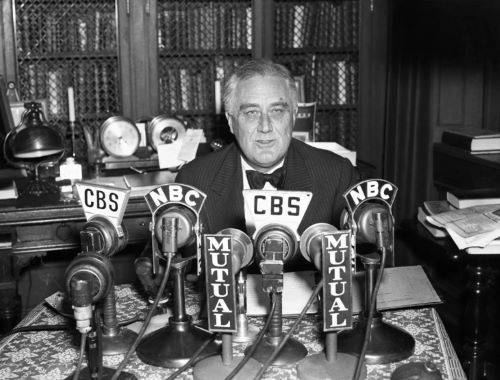
The New Deal was more than a recovery program for the economy. It was, as the historian Eric Rauchway argues in his new book, “Why the New Deal Matters,” a recovery program for American democracy.
“I pledge you, I pledge myself, to a new deal for the American people,” Franklin Roosevelt declared at the 1932 Democratic National Convention in Chicago.
Roosevelt had broken tradition to accept his party’s nomination and deliver a speech in person. And in that speech, he promised a program based on the “simple moral principle” that the “welfare and the soundness of a nation depend first upon what the great mass of the people wish and need” and second on “whether or not they are getting it.”
Aware of the challenge ahead of him should he win the presidency — nearly a quarter of Americans were out of work and the economy was shrinking by double digits — Roosevelt concluded his address with a call to action. “Let us all here assembled constitute ourselves prophets of a new order of competence and of courage,” he said. “This is more than a political campaign; it is a call to arms. Give me your help, not to win votes alone, but to win in this crusade to restore America to its own people.”
READ ENTIRE ARTICLE AT THE NEW YORK TIMES
FDR’s Second 100 Days Were Cooler Than His First 100 Days
Let’s talk about the period when Roosevelt actually created the modern welfare state.
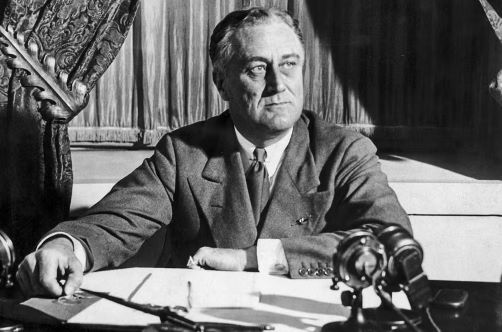
We have now made it past Joe Biden’s first 100 days in office, the traditional point at which political journalists pass sage judgment on the early results of a new presidency (or at least tap out a few saved-up think pieces in need of a hook). The country owes this practice to Franklin Roosevelt, who in July of 1933 sat down for one of his early fireside chats and told radio listeners that he wanted to reflect on “the hundred days which had been devoted to the starting of the wheels of the New Deal.” Reporters have been using it as a benchmark for taking stock ever since.
Does the custom still make any sense today? Maybe. Some research has found that presidents really have had more success passing legislation during their first 100 days than later on, possibly because they have tended to enjoy a moment of bipartisan approval early in their terms. These honeymoon periods might be thing of the past, however, thanks to increasing partisan polarization, which means the first three months might not matter in quite the same way they used to.
But whether or not it makes practical sense, marking the first 100 days bugs me purely from the standpoint of historical appreciation. FDR’s first 100 Days, momentous as they were, are arguably a tiny bit overrated in the popular imagination. And the focus on them obscures the fact that Roosevelt truly cemented his domestic legacy in a period known as the Second 100 Days—which took place two years later, in 1935. That’s when we got little things like Social Security and the foundation of modern labor law. The commentating class basically ignores that stretch, rather than think about what lessons it might hold.
Roosevelt’s first 100 days were really the disaster-response period of his presidency, the moment when the new chief executive grabbed the fire hose and started putting out the flames that had not just engulfed the economy—around a quarter of Americans were unemployed, with the share in some cities vastly higher—but were threatening to destroy the foundations of capitalism. After taking the oath of office in March, he called a special three-month session of Congress, which proceeded to pass some 76 pieces of legislation.
FDR’s achievements in this period were substantial. He successfully halted a spiraling financial crisis by declaring a national bank holiday, and signed reforms to prevent future meltdowns. He freed the U.S. from the shackles of the gold standard, legalized beer (cheers!), stood up public works and relief agencies, rescued rural America with farm subsidies, launched a massive regional development effort by creating the Tennessee Valley Authority, and much more. Though it would ultimately take the industrial frenzy of World War II to restore full prosperity to the United States, the economy did begin to heal and the sense of impending calamity faded.
That Time America Almost Had a 30-Hour Workweek
A six-hour workday could have become the national standard during the Great Depression. Here’s the story of why that didn’t happen.
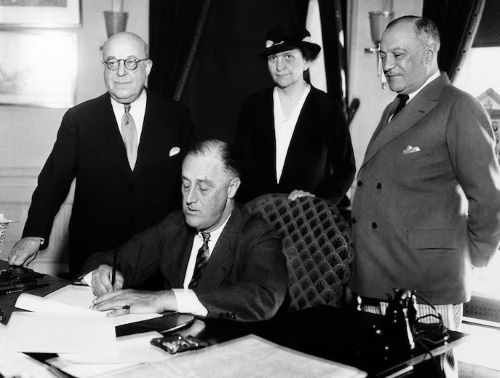
The nature of work has undergone a lot of changes during the coronavirus pandemic. Millions of office workers began working from home; the service industry has struggled to get workers to come back, and some businesses, like Kickstarter, are now experimenting with four-day workweeks — without reducing salaries. In Congress, Rep. Mark Takano (D-Calif.) has introduced legislation to make a 32-hour workweek standard.
This “great reassessment” of labor feels revolutionary. But we have been here before. In 1933, the Senate passed, and President Franklin D. Roosevelt supported, a bill to reduce the standard workweek to only 30 hours.
Americans have worked hard, perhaps too hard, since the Colonial era. English and other European colonists often had to work longer and harder on farms here than in the Old World, and a philosophy of working from sunrise to sunset prevailed, according to the Economic History Association. The Massachusetts colony even passed a law requiring a 10-hour minimum workday.
READ ENTIRE ARTICLE AT THE WASHINGTON POST
Reconstruction Finance
Popular politics and reconstructing the Reconstruction Finance Corporation.
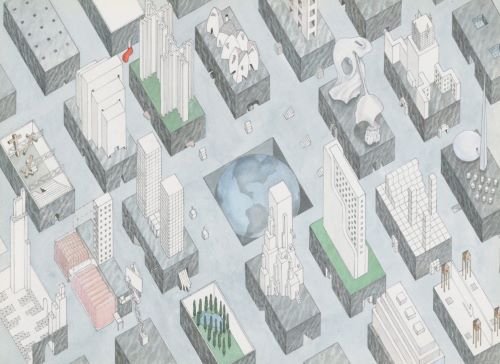
Like the world system as a whole, segregated cities in the United States have their own finance driven core-periphery dynamics. The world economy is structured by countries with competitive export sectors and trade surpluses, like Germany and China, who exhibit underconsumption and excess savings; the US’s debt-fueled economy receives these savings through its domination of global financial markets. The dynamic strengthens the power of global finance at the expense of wages and living standards. And within the US, the allocation of credit and investment has exacerbated racial disparities and altered the municipal geography of debt. At the level of the city and the financial system, these developments warrant a powerful political response. But what form can that response take?
Global underconsumption and a structurally-weakened working class are problems likely to persist as the twenty-first century marches on. Altering the shape of our global economy will require building new institutions capable of funneling excess savings into productive investment. This is not something that can be done with a temporary increase in spending—no matter how large. Moreover, as commentators stressed in the wake of the Black Lives Matter uprisings of 2020, such investment must be democratically managed. Can the tensions and energies created on the local scale be harnessed to address larger macroeconomic imbalances? The history of the New Deal’s Reconstruction Finance Corporation offers a starting point with which to think through these dynamics.
READ ENTIRE ARTICLE AT PHENOMENAL WORLD
The New Deal Program that Sent Women to Summer Camp
About 8,500 women attended the camps inspired by the CCC and organized by Eleanor Roosevelt—but the “She-She-She” program was mocked and eventually abandoned.
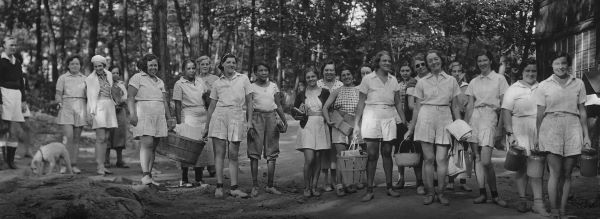
During the Great Depression, thousands of unemployed men picked up saws and axes and headed to the woods to serve in the Civilian Conservation Corps, a New Deal program that employed about 3 million men. But men in the CCC weren’t the only ones to take to the great outdoors on the New Deal’s dime. Between 1934 and 1937, thousands of women attended “She-She-She camps,” a short-lived group of camps designed to support women without jobs.
The program was the brainchild of First Lady Eleanor Roosevelt, who wanted an option for the 2 million women who had lost work after the stock market crash of 1929. Like their male counterparts, they looked for work, but stigma against women who worked and women who took government aid made finding a job even more difficult. Many women were forced to seek dwindling private charity or turned to their families. Others became increasingly desperate, living on the streets.
Their plight deeply concerned Roosevelt, who wondered if they might be served by the CCC. The program, which sent men to camps around the country and put them to work doing forestry and conservation jobs, was considered a rousing success. But Roosevelt encountered resistance from her husband’s cabinet, which questioned the propriety of sending women to the woods to work.
READ ENTIRE ARTICLE AT HISTORY
Carl Reiner’s Life Should Remind Us: If You Like Laughing, Thank FDR and the New Deal
Reiner, Stephen Colbert, Jordan Peele, Steve Carrell, Tina Fey, Julia Louis-Dreyfus: Their comedy descends directly from the Works Progress Administration.
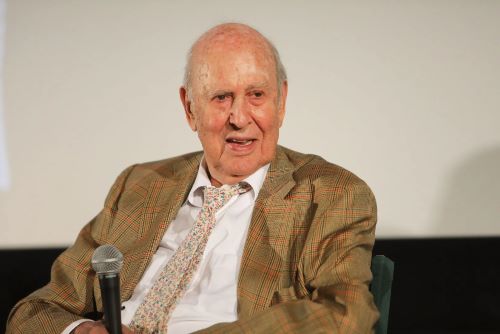
When Carl Reiner was 17 in 1939, he was working as a machinist’s helper, bringing sewing machines to hat factories. Then Reiner’s brother saw a small ad in the New York Daily News about free acting lessons being offered in lower Manhattan by the Works Progress Administration. Reiner had never contemplated acting before in his life, but his brother insisted, so he went.
The WPA had been established several years prior to carry out public works projects during the Great Depression, with workers put directly on the government payroll, keeping the struggling economy afloat while also expanding the infrastructure of the U.S. Its initial outlays were huge — the gross domestic product equivalent of about $1.3 trillion today. The WPA paved roads, built bridges, and constructed Camp David and the Tennessee Valley Authority. But it went beyond these physical public works to enhance America’s human infrastructure via Federal Project Number One, which employed writers, musicians, and actors. The Federal Theatre Project, part of Federal Project Number One, funded live performances and acting classes — including the ones Carl Reiner attended.
“All the good things that have happened to me in my life I can trace to that two-inch newspaper item my brother handed to me,” Reiner explained. “Had Charlie not brought it to my attention, I might very well be writing anecdotes about my life as a machinist or, more likely, not be writing anything about anything.”
But Reiner’s life was just one small aspect of the WPA’s impact. A few years earlier in Chicago, a sociologist named Neva Boyd had begun working with immigrant children by teaching them dance, movement, and improvisational games. She soon brought this work to Hull House, a progressive “settlement house” — a central place where anyone regardless of age, class, or culture could go to learn, share, engage with art, express themselves, and grow.
Boyd viewed creativity and playfulness as essential for a democratic society. “Social living cannot be maintained on the basis of destructive ideologies — domination, hate, prejudice, greed and dishonesty,” she wrote in a famous essay. “Play involves social values, as does no other behavior. The spirit of play develops social adaptability, ethics, mental and emotional control, and imagination.”
READ ENTIRE ARTICLE AT THE INTERCEPT
Cities and States Need Aid — But Also Oversight
Federal funding during and after the New Deal ended up hurting cities because of who spent it and how.
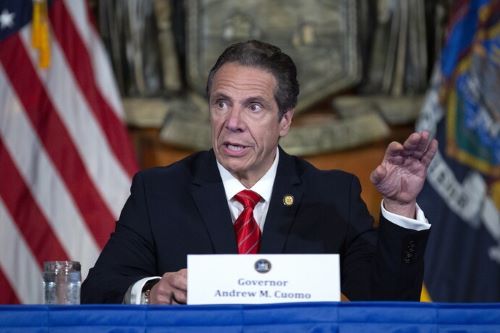
Faced with staggering public health costs and cratering tax revenue as a result of the coronavirus, officials in both parties are demanding federal aid for state and local governments. Even Senate Majority Leader Mitch McConnell (R-Ky.), who called for allowing states to go bankrupt two weeks ago, has moderated his stance, conceding that aid is now “highly likely.”
Some proponents invoke Franklin Roosevelt’s New Deal as a model for this aid, asserting that nationally financed public works programs and relief during the 1930s restored cities to fiscal health after the Great Depression. A new round of federal aid, they argue, might do the same today.
A closer look at the consequences of federal aid to local governments beginning with the New Deal, however, reveals a very different lesson: that without robust democratic oversight and wise management at the local level, federal aid can exacerbate the fiscal problems it was meant to solve.
READ ENTIRE ARTICLE AT THE WASHINGTON POST
The New Deal’s Capitalist Lessons for Joe Biden
The most effective part of F.D.R.’s program wasn’t its direct spending. It was his use of U.S. financial might to reignite business.
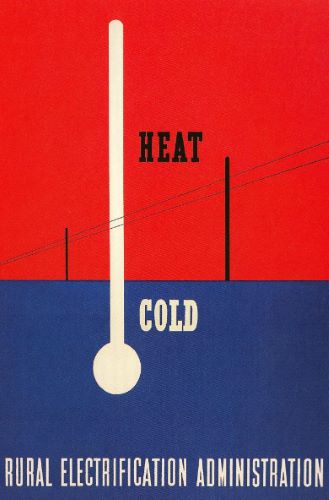
In American politics, we talk a great deal about the New Deal, particularly in times of economic crisis. But our collective memory of its contents typically fails to include its most powerful parts.
The New Deal’s alphabet soup of job programs still loom large, and was doubtlessly a saving grace for millions of working men and their families. However the macroeconomic impact of President Franklin Roosevelt’s direct government employment programs was dwarfed by what I call the “Other New Deal”: low-cost government loans, ambitious housing insurance programs and tax subsidies that spurred major industries. Together, this resurrected private investment and loosened credit markets — the heart of the capitalist system — for businesses and everyday people.
As President Biden begins his presidency with razor-thin Democratic congressional majorities that could stymie future spending plans, these undersold successes of the New Deal provide him with a historical blueprint for how to creatively “Build Back Better.”
Take the Reconstruction Finance Corporation, or R.F.C., which was led by Jesse Jones, the Texan lumberman, developer and banker. Jones held a dim view of Eastern bankers, who believed they had already invested in everything worth doing. This glut of savings — that is, idle capital — could not be profitably invested, or so the bankers thought. (Somewhat similarly, despite the stable economy of the past decade, we’ve witnessed a glut of private savings as financiers focus on speculation in property and stocks .)
READ ENTIRE ARTICLE AT THE NEW YORK TIMES
A Stronger Welfare State Is the Key to Saving Democracy From Extremism
Democrats’ policies aim to address societal problems to make fascism and socialism less attractive.
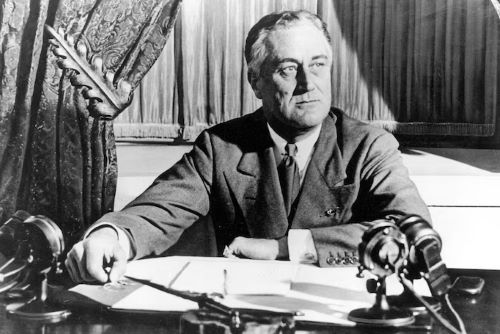
Republicans frequently charge that Democratic ideas are socialist or radical. But there is deep irony in these charges: Democrats are trying to grow and strengthen a social safety net that dates back to President Franklin D. Roosevelt’s New Deal. And far from being radical, the New Deal aimed to save the United States from the growing popular allure of undemocratic extremist philosophies such as Italian fascism. This history offers a blueprint for President Biden at another moment when undemocratic philosophies, specifically those tied to Donald Trump and his proteges, entice Americans.
During the 1920s, government became increasingly disconnected from the American people because of its inability to deal with the transition to an industrial economy. Rural Americans suffered the most, since mechanization on farms led to mounting debts and falling prices. Congress debated farm relief throughout the decade but couldn’t reach an agreement.
According to observers such as New York Times journalist Anne O’Hare McCormick, legislators’ lack of expertise was part of the problem. It left them floundering over complex issues such as subsidies and surpluses. This poor governance, in turn, made for apathetic citizens. Less than 50 percent of eligible voters had gone to the polls in 1920 and 1924 because Americans viewed elections as a spectator activity that lay outside “the class of major sporting events,” McCormick wrote.
READ ENTIRE ARTICLE AT THE WASHINGTON POST
America’s Forgotten History Of Mexican-American ‘Repatriation’
During the Depression, more than a million people of Mexican descent were deported. Author Francisco Balderrama says that most were American citizens.
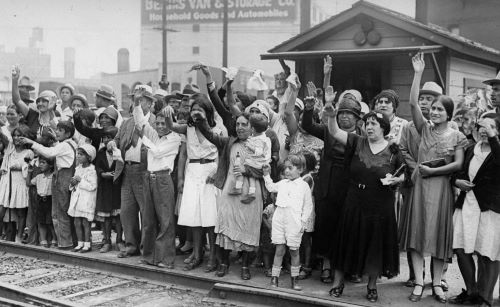
This is FRESH AIR. I’m Terry Gross. Donald Trump has proposed immigration reform that would include building a wall on the Mexican border, paid for by Mexico, and calls for the mass deportation of immigrants who are in the U.S. illegally. The deportation plan has echoes of a largely forgotten chapter of American history when, in the 1930s, during the Depression, about a million people were forced out of the U.S. across the border into Mexico. It wasn’t called deportation. It was euphemistically referred to as repatriation, returning people to their native country. But about 60 percent of the people in the Mexican repatriation drive were actually U.S. citizens of Mexican descent. Perhaps the most widely cited book on the subject was co-written by my guest, Francisco Balderrama. The book is called “Decade Of Betrayal: Mexican Repatriation In The 1930s.” His late co-author, Raymond Rodriguez, had family that was forced out of the U.S. Balderrama is a professor of American history and Chicano studies at California State University, Los Angeles.
Francisco Balderrama, welcome to FRESH AIR. Would you give us an overview of the scope of the mass deportations or the repatriation of the 1930s? Like, how many people were affected? And of those people, how many of them were actually American citizens?
FRANCISCO BALDERRAMA: Well, conservatively, we’re talking about over 1 million Mexican nationals and American citizens of Mexican descent from throughout the United States, from the American Southwest to the Midwest to the Pacific Northwest to the South, even Alaska included. This occurred on a number of different levels through a formal deportation campaign at the federal government, then also efforts by major industries as well as efforts on the local and state level. Conservatively, we are able to estimate that 60 percent of them were U.S. citizens of Mexican descent.
GROSS: So what was behind these deportations? Was it the Depression?
BALDERRAMA: Well, the Depression set the scenario for what happened. I think one needs to keep in mind that in the American public at that time, Mexicans were targeted as a scapegoat partly because they are the most recent immigrant group to come to the United States in the early 20th century.
READ AND LISTEN AT FRESH AIR, NPR
The Dust Bowl
The Kept and the Killed
Of the 270,000 photos commissioned to document the Great Depression, more than a third were “killed.” Explore the hole-punched archive and the void at its center.

The first killed negative I encounter is of a field. It’s a Carl Mydans shot, and a drought has reduced the land to a flat, cracked expanse out of which only a few tenacious scraggles of crabgrass have managed to sprout. Nothing notable here, no action, no grand geometries — except that the center of the negative has been pierced by a perfect circle, as though in counterpoint to the sprocket holes running along the photo’s edge. Briefly I imagine that this circle is what has doomed the land, a well into which all the precious waters must have run. Months after coming across the photograph, it is that void, more than any peripheral scenery, which remains anchored in my memory — that and the caption describing the picture as “killed”.
Begun as part of the alphabet soup of Franklin D. Roosevelt’s New Deal policies, the Farm Security Administration (FSA), under the aegis of which Mydans’ ill-fated photo was taken, had been tasked with resettling struggling farmers onto more fertile ground, providing education about agricultural science, and giving loans for the purchase of land, feed, and livestock. Arguably its most enduring legacy today, however, is the hundreds of thousands of photographs the agency produced to document the plight of destitute farmers, many of whom were trapped in an inescapable pit of debt made deeper still by the environmental devastation of the Dust Bowl. The project’s head, Roy Emerson Stryker (1893–1975), would shop his favorites around, going from newsroom to newsroom “with pictures under his arm”, as Dorothea Lange would later recall, in an attempt to secure placements in major papers. Stryker had encyclopedic ambitions: tasked with the mission of “introducing America to Americans”, the FSA’s photography wing would soon see its remit balloon far past images of rural poverty to encompass everything from aerial shots of utopian building projects to Kodachrome still lifes — all of which could find a home within what Stryker called simply the File.
READ ENTIRE ARTICLE AT THE PUBLIC DOMAIN REVIEW
The Anti-Nostalgia of Walker Evans
A recent biography reveals the many contradictions of the photographer who fastidiously documented postwar American life.
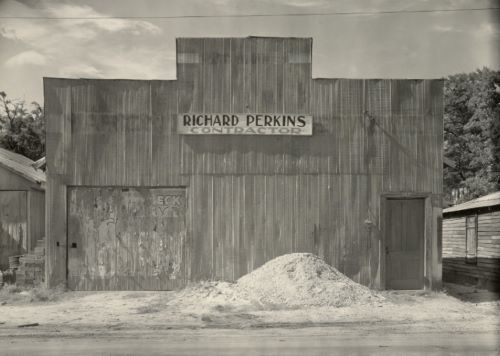
In Starting From Scratch, art historian Svetlana Alpers’s biography of the American photographer Walker Evans, the images come first. All the classics are here: the iconic Great Depression–era portraits of white tenant farmers; the economic immiseration contrasting with natty, white-suited cool in his pictures from Cuba; the subway portraits surreptitiously taken using a hidden camera. They are joined with lesser-known works that index the interior and exterior architecture of an America that was already receding into history in Evans’s time. Dilapidated buildings and the tattered, upholstered violence of once glorious plantation homes are captured alongside so many wagons, statues, and show bills—an Americana that slept in its makeup the night before and looks fragile in the light of day. A corrugated tin facade, its variegated surface palimpsestic with faded ads, a pile of dirt out front. A frowning woman in a cloche hat and furs on a busy shopping street. A spiny succulent bursting out of a bucket marked “TRIPLE WHITE,” floral wallpaper, a tiny American flag.
First we see, then we read, and it feels right. Evans was the rare photographer who preferred publishing in print over being exhibited, and indeed he is best known for books like American Photographs (1938) and Let Us Now Praise Famous Men (1941), with its text by James Agee. “From the start,” Alpers explains, “Evans imagined seeing his photographs not in, but as a book, a book about America.” A 1933 letter by Evans is notable for the way it prefigures both these later volumes and a very contemporary understanding of the photographer as someone who selects images from the multimedia stream that surrounds us today, whether or not they took them themselves:
A wonderful volume is waiting to be done which would describe America, to ourselves as well as to strangers, entirely by means of pictures—photographs of America, machines, factories, and landscapes, portraits of American faces of low and high degree, intelligent selections from news photographs and the contents of the Sunday photo-gravures.
READ ENTIRE ARTICLE AT THE NATION
When Black and White Tenant Farmers Joined Together to Take on the Plantation South
The Southern Tenant Farmers Union was founded on the principle of interracial organizing.
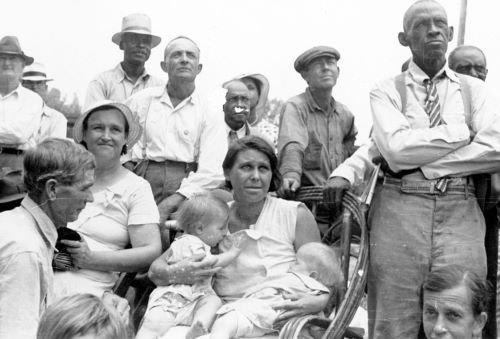
It’s 1935 and class war is brewing in Arkansas. Standing before 1,500 black and white sharecroppers, the radical Methodist minister Ward Rodgers thunders, “I can lead a mob to lynch any planter in Poinsett County.” The crowd erupts with applause.
These white and black sharecroppers who worked, lived, and died amid the vestiges of the Southern plantation system were no strangers to terror. The night before, a group of planters and deputy sheriffs had attacked an adult education class taught by Rodgers. The landowner class, the banks, the police, and an offshoot of the Ku Klux Klan called the Nightriders had been engaged in a brutal crackdown on the workers of the Southern Tenant Farmers Union.
Not to be outdone, the youthful and slender Harry Leland Mitchell rose to the stage. H. L. Mitchell was a union organizer and cofounder of the Southern Tenant Farmers Union (STFU for short), one of the first interracial and most influential unions in the South. In the middle of the town square, Mitchell defended the Methodist minister, saying, “Ward Rodgers is staying at my house. If any bunch of sons of bitches with their heads in pillowcases come to my house, they are going to get the hell shot out of them.”
The STFU would grow to thirty-one thousand members across the South, challenging the Southern landowning class and the Jim Crow white supremacist order, and leaving an undeniable legacy for both the labor movement and the civil rights movement.
Mitchell borrowed the title of his autobiography Mean Things Happening in This Land from a song of the same name written by the poet, singer, and STFU member John Handcox, whose poetry is found throughout the book. Mean Things Happening in This Land is not just a recollection of fights won and lost, but a lively look at what democratic socialist Michael Harrington called the “grandeur of ordinary people.” The cinematic bravery of poor folks, black and white, facing down the planters and Nightriders is right there next to bawdy jokes, stories of bourbon-soaked nights, and common things.
Mean Things Happening in This Land is a book about the grand sweep of history, but it’s often interrupted by everyday life. Its characters are heroic, but not in a storybook way. They were ordinary people, and they wanted only what was necessary to live a happy ordinary life. What distinguished them was their courage in fighting for it.
The STFU is a model of the connection between social and economic justice as well as the crucial role community must play in sustaining workers’ movements taking on the rich and powerful. We’d do well to study the union today, and Mitchell’s autobiography is as good a place as any to start.
READ ENTIRE ARTICLE AT JACOBIN
A Blueprint From History for Tackling Homelessness
During the New Deal, the U.S. knew that economic recovery depended upon housing.
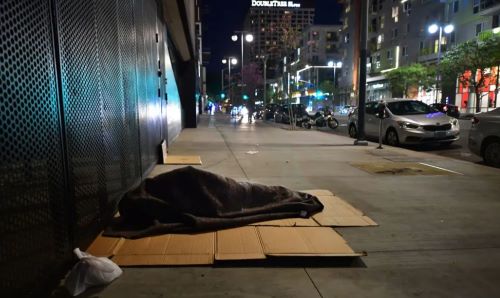
One of the most pressing issues facing the United States during the 2020s is the issue of homelessness. As a result of the COVID-19 pandemic, the instability of the economy, and the changing nature of employment, more Americans now live in precarity than in the previous decade. In California, where an estimated 30% of the nation’s chronically unhoused live, totaling up to 171,500 individuals, a range of nonprofit and civic groups have worked with state officials to address the issue. For example, Urban Alchemy has launched experiments with “safe sleep villages”: tent communities that offer stable housing, food, and bathroom facilities.
Such a program builds on the same ideas launched nearly a century ago during the New Deal when the Farm Security Administration (FSA) sought to tackle acute homelessness during the Great Depression.
Of the New Deal-era initiatives that sought to uplift unemployed Americans from poverty, the Farm Security Administration experimented with several programs to provide migratory families with stable housing and education to help unhoused Americans get back on their feet. As one of the first federal programs to offer affordable housing to unhoused individuals on a national scale, the FSA’s efficient and effective programs provide a blueprint for policymakers today.
Whitewashing the Great Depression
How the preeminent photographic record of the period excluded people of color from the nation’s self-image.

In one sense, the lack of diversity in classic FSA photographs comes as little surprise: The country was roughly 90 percent white during the Depression, and the FSA represented Black people in proportion to their share of the population. Yet overall representation is surely only part of the story, given that the FSA was supposed to be chronicling hardship among farmworkers. During the Depression, Black Americans made up more than half of the country’s tenant farmers, sharecroppers, and farmworkers in the South. In 1932, when a quarter of white Americans were unemployed, half of Black Americans were. “In some Northern cities, whites called for African Americans to be fired from any jobs as long as there were whites out of work,” according to the Library of Congress’s website for teachers. And Black sharecroppers were often forced out of work by white ones. “No group was harder hit than African Americans.”
Yet we’ve come to imagine the Great Depression as largely a white tragedy. That isn’t because the FSA photographers focused only on white subjects. If you look at the roughly 175,000 negatives in the complete FSA/Office of War Information file, now at the Library of Congress, you’ll see that the photographers working for the FSA and for its predecessor, the Resettlement Administration, and its successor, the OWI, documented many people of color. Lee photographed poor Black people in Missouri, and Mexican pecan shellers in Texas. Evans photographed Black Americans out of work in Mississippi and Alabama. And Lange photographed Filipino lettuce pickers and Japanese truck farmers in California.
The most direct responsibility for the whitewashing seems to lie with the photographers’ boss, Roy Stryker, who was the chief of the FSA’s historical section from 1935 to 1941, and then of the OWI’s photography unit. Three new books that pursue three very different subjects in very distinctive ways—Walker Evans: Starting From Scratch, by Svetlana Alpers; Russell Lee: A Photographer’s Life and Legacy, by Mary Jane Appel; and Dorothea Lange: Words & Pictures, a Museum of Modern Art exhibition catalog—all offer evidence that FSA photographers often tangled with Stryker over matters of race.
Stryker openly worried that too much racial honesty might sink his ship at the FSA. Part of his mission at the agency was to compile a complete pictorial record of all kinds of Americans, known as “The File.” The other part was to present to Congress a sympathetic portrayal of American suffering, “to document the problems of the Depression,” as one photographer recalled, “so that we could justify the New Deal legislation that was designed to alleviate them.”
Stryker, in other words, was a realist. And the reality was that Congress, which controlled the FSA’s funds, was dominated by Southern Democrats, who, as Appel writes in her Lee biography, were “interested in preserving the racial status quo.” Knowing this, Stryker and other FSA officials “were reluctant to lead the agency in a crusade against racial disparity.” President Franklin D. Roosevelt himself feared the Southern Democrats. Without their support, his New Deal programs had no hope of surviving. Thus, although FDR signed an order barring discrimination in the projects sponsored by his newly founded Works Progress Administration in 1935, Appel notes that he wouldn’t back “an anti-lynching campaign because he was afraid of losing his Southern Democratic base.” And when the Social Security Act was passed, also in 1935, agricultural and domestic workers (who were disproportionately Black) were excluded from its benefits.
READ ENTIRE ARTICLE AT THE ATLANTIC
How Washington Bargained Away Rural America
Every five years, the farm bill brings together Democrats and Republicans. The result is the continued corporatization of agriculture.
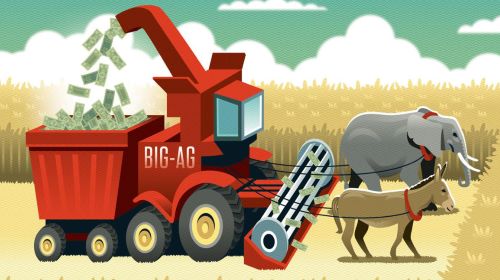
A classic premise in American cinema is the buddy comedy, epitomized by films like Tommy Boy or Midnight Run. Two characters who can’t stand each other are thrown together by circumstance, forced to make a screwball pilgrimage across the country to finish a job. Hilarity ensues.
This same storyline infects our politics every five years when the farm bill comes up for reauthorization. Two parties at the brink of civil war are pressured to cooperate in order to deliver for their respective constituents. Congress’s version of this tumultuous road trip runs through both rural and urban America, uniting liberal Democrats and conservative Republicans. But the ultimate winner of this madcap romp is one of the country’s most infamous heels: Big Agriculture.
Despite its title, the farm bill, which is due for reauthorization this September, impacts more than just farmers. Over 80 percent of the allocated funds supports the Supplemental Nutrition Assistance Program (SNAP), formerly known as food stamps, one of the largest welfare programs and arguably the United States’ closest imitation of a Scandinavian social safety net. The fate of SNAP’s 42 million impoverished recipients is shackled to a baroque patchwork of agriculture subsidies that could rival any late-Soviet central-planning efforts.
READ ENTIRE ARTICLE AT THE AMERICAN PROSPECT
Savoring Pie Town
Sixty-five years after Russell Lee photographed New Mexico homesteaders coping with the Depression, a Lee admirer visits the town for a fresh slice of life.
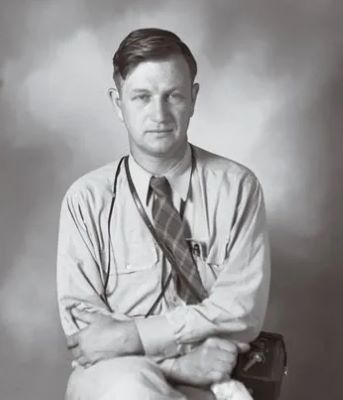
The name alone would make a stomach-growling man wish to get up and go there: PieTown. And then too, there are the old photographs—those moving gelatin-silver prints, and the equally beautiful ones made in Kodachrome color, six and a half decades ago, at the heel of the Depression, on the eve of a global war, by a gifted, itinerant, government, documentary photographer working on behalf of FDR’s New Deal. His name was Russell Lee. His Pie Town images—and there are something like 600 of them preserved in the archives of the Library of Congress—portrayed this little clot of high-mountain-desert New Mexico humanity in all of its redemptive, communal, hard-won glory. Many were published last year in Bound for Glory, Americain Color 1939-43. But let’s get back to pie for a minute.
“Is there a particular kind you like?” Peggy Rawl, coowner of PieTown’s Daily Pie Café, had asked sweetly on the phone, when I was still two-thirds of a continent away. There was clatter and much talk in the background. I’d forgotten about the time difference between the East Coast and the Southwest and had called at an inopportune hour: lunchtime on a Saturday. But the chief confectioner was willing to take time out to ask what my favorite pie was so that she could have one ready when I got there.
Having known about PieTown for many years, I was itching to go. You’ll find it on most maps, in west-central New Mexico, in CatronCounty. The way you get there is via U.S. 60. There’s almost no other way, unless you own a helicopter. Back when Russell Lee of the Farm Security Administration (FSA) went to Pie Town, U.S. 60—nowhere near as celebrated a highway as its more northerly New Mexico neighbor, Route 66, on which you got your kicks—called itself the “ocean to ocean” highway. Big stretches weren’t even paved. Late last summer, when I made the trek, the road was paved just fine, but it was still an extremely lonesome two lane ribbon of asphalt. We’ve long licked the idea of distance and remoteness in America, and yet there remain places and roads like PieTown and U.S. 60. They sit yet back beyond the moon, or at least they feel that way, and this, too, explains part of their beckoning.
When I saw my first road sign for PieTown outside a New Mexico town called Socorro (by New Mexico standards, Socorro would count as a city), I found myself getting cranky and strangely elevated. This was because I knew I still had more than an hour to go. It was the psychic power of pie, apparently. Again, I hadn’t planned things quite right—I’d left civilization, which is to say Albuquerque—without properly filling my stomach for the three-hour haul. I was muttering things like, They better damn well have some pie left when I get there. The billboard at Socorro, in bold letters, proclaimed: HOME COOKING ON THE GREAT DIVIDE. PIE TOWNUSA. I drove on with some real resolve.
Continental Divide: this is another aspect of PieTown’s strange gravitational pull, or so I have become convinced. People want to go see it, taste it, at least in part, because it sits right on the Continental Divide, at just under 8,000 feet. PieTown, on the Great Divide—it sounds like a Woody Guthrie lyric. Something there is in our atavistic frontier self that hankers to stand on a spot in America, an invisible demarcation line, where the waters start to run in different directions toward different oceans. Never mind that you’re never going to see much flowing water in PieTown. Water, or, more accurately, its lack, has much to do with PieTown’s history.
The place was built up, principally, by Dust Bowlers of the mid- and late 1930s. They were refugees from their busted dreams in Oklahoma and West Texas. A little cooperative, Thoreauvian dream of self-reliance flowered 70 and 80 years ago, on this red earth, amid these ponderosa pines and junipers and piñon and rattlesnakes. The town had been around as a settlement since at least the early 1920s, started, or so the legend goes, by a man named Norman who’d filed a mining claim and opened a general store and enjoyed baking pies, rolling his own dough, making them from scratch. He’d serve them to family and travelers. Mr. Norman’s pies were such a hit that everybody began calling the crossroads PieTown. Around 1927, the locals petitioned for a post office. The authorities were said to have wanted a more conventional name. The Pie Towners said it would be PieTown or no town.
READ ENTIRE ARTICLE AT SMITHSONIAN MAGAZINE
Government Song Women
The Resettlement Administration was one of the New Deal’s most radical, far-reaching, and highly criticized programs, and it lasted just two years.
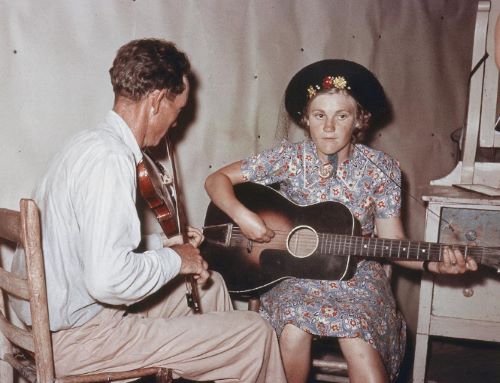
It was October 1935, and the Resettlement Administration was in trouble. The experimental agency—“RA” in the New Deal lexicon—was tasked with moving those hardest hit by the Great Depression onto government-built homesteads, but their early efforts were undermined by discord among the new homesteaders—a mix of farmers whose land had failed, jobless urban workers willing to return to farming, and unemployed miners and other workers whose jobs had disappeared.
The Special Skills Division, which had been created as a service division to make furniture and print materials for the RA, was charged with helping to develop recreation programs and activities to alleviate social tensions on the new settlements. Clubs were set up and programs introduced. But after visiting four RA homesteads in Tennessee, Pennsylvania, and West Virginia, Special Skills staffer Katharine Kellock submitted a report warning that instead of a solution to the homesteads’ social problems, the clubs had become “hotbeds of discontent.” At meetings, unhappy participants steered the agenda toward “a serious contemplation of their economic problems which they had no power to solve.”
Kellock characterized this discontentment as “an emergency situation” that was tearing apart the communities that the RA had worked hard to build. So who did the government call on to rescue their faltering social experiment? “The Special Skills Division,” Kellock announced, “is sending in leaders of music.”
Explaining the rationale, she wrote, “In every one of these colonies project managers and educational supervisors told me of the desperate need for recreation to keep up morale and carry the homesteaders through the present pioneer period. Without exception, they regarded musical leadership for the adult homesteaders as the first important assistance that we could give.”
The RA’s newly formed music unit dispatched field representatives to teach rudimentary music classes, organize musical groups, and lead community singing and other social events. Music unit representatives also visited homesteads and surrounding communities to record folk songs, which were then incorporated into the group singing to help strengthen ties among the homesteaders. This focus on the “social use” of music was intertwined with a larger (and controversial) goal of the RA: to foster an ideological shift on the homesteads, away from rugged individualism to an emphasis on collective responsibility. Homes were built in close enough proximity to encourage cooperation and a move toward cooperative farming, and every homestead included a community hall to allow residents to gather informally.
READ ENTIRE ARTICLE AT HUMANITIES
The Value of Farmland: Rural Gentrification and the Movement to Stop Sprawl
Rapidly rising metropolitan land value can mean “striking gold” for some landowners while threatening the livelihood of others.
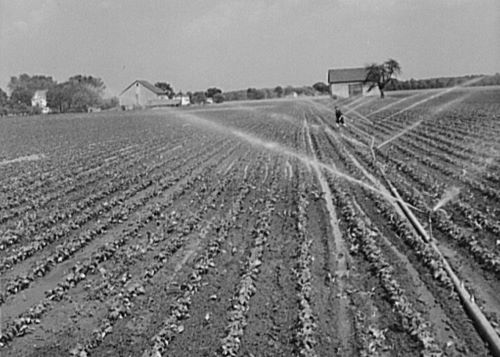
Rents are rapidly rising. Property values are skyrocketing. Real estate taxes are ever-increasing. Long-time owners are selling out and moving away. Newcomers express values and politics at odds with older residents. This sounds like a gentrifying urban neighborhood—but it was the situation in not-long-to-be-rural, mid-twentieth century Bucks County, Pennsylvania.
J. Warren Shelly, whose family began farming in Bucks County in the 1700s, worried that he would have to sell the 65-acre farm where he was born, because its real estate tax assessment was increased 900 percent in 1972. Yet, as he noted, “The land isn’t for sale, so the market value doesn’t mean anything to us.” He went on to observe “It’s a funny thing…A lot of people came here originally because they like the way it is out here, with the open spaces and green fields. Those are the same people who are taxing us out of existence.”
Shelly was one of many Bucks County farmers who found their lives upended as the demand for exurban estates and suburban tract homes transformed their rural townships and caused land prices to sharply appreciate. Some farmers happily sold their land and pocketed the windfall, which allowed them to comfortably retire from the hard work and financial uncertainty of farming. But other farmers found increased property values and the higher real estate taxes they produced problematic if they wanted to continue to farm or to live out their retirement years on land that had been in their family for generations.
While many of the new arrivals were sympathetic to the plight of neighboring farmers, the novelty of the problem and the glacial rate of change in state and local government policy resulted in many long-time residents being uprooted from their land. When programs were finally enacted to preserve prime farmland and agriculture, the new policies were implemented largely because farmers found allies in their exurban neighbors who valued the amenity that a farm landscape provided.
The history of suburbanization has largely been written in order to understand the experience and motivations of the people who moved from city to suburb. I am interested in the perspective of the farmers who were living in the rural areas to which suburbanization came. The legacies of conflicts over land, how it is regulated and taxed, and who can afford to live on it, continue to reverberate not just in cities, but at the rural-urban fringe.
READ ENTIRE ARTICLE AT THE METROPOLE
Postal Banking is Making a Comeback. Here’s How to Ensure it Becomes a Reality.
Grass-roots pressure will be key to turning the idea into reality.
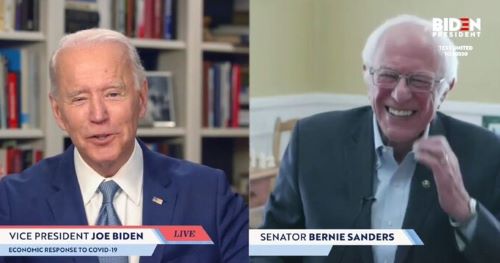
Last week, the joint task forces put together by former vice president Joe Biden and Sen. Bernie Sanders (I-Vt.) to heal the Democratic Party at the end of a bruising primary revealed their policy proposals.
Among the most compelling suggestions was to make bank accounts and payment services more accessible to middle- and low-income Americans by creating new consumer banking roles for the Federal Reserve System and Postal Service.
The task force’s endorsement of this change represents a homecoming for Democrats, pushing the party to the left and turning toward the economic ideas that Sanders has advocated throughout his career. But the history of this kind of banking policy reveals that only a concerted push from the grass roots will make it reality.
Although government banking represents a major departure from recent policy, the idea has ample precedent in American history. It rose to prominence during the Populist movement of the 1890s. As a counterweight to the inequality of the Gilded Age, Populists advocated offering bank accounts at local post offices, making direct federal loans to farmers and placing the supply of money and credit under the control of government officials.
READ ENTIRE ARTICLE AT THE WASHINGTON POST
Down in Dyess
Johnny Cash’s life in a collectivist colony during the Great Depression.
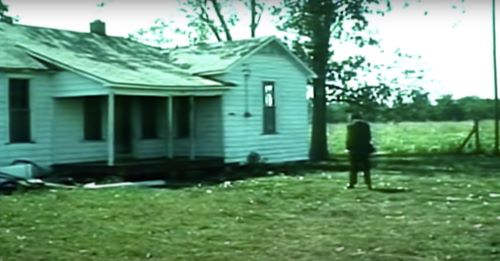
My grandfather met Johnny Cash at the Illinois State Fair. After serving in the U.S. Army Air Forces in World War II and then mining coal for a while, Grandpa Elmer became an Illinois conservation officer. In August 1965, four years before he died, Elmer was assigned to work the state fair. Johnny Cash played on the grandstand.
After the show, Cash got intoxicated and volatile. The state troopers wanted to make sure the beloved performer didn’t get into any trouble. My grandfather had a reputation as a calm man who could talk anyone down, so his law enforcement buddies asked him to help handle Cash. Elmer spent the night hanging out with Cash in the hotel. Whenever Cash tried to go out and raise hell in the streets of Springfield, Elmer told him firmly: “Now Johnny, you don’t want to be doing that.”
In the spring of 2000, Elmer’s widow—my Grandma Frances—lay dying in a state hospital. While my mother was at Frances’s bedside, I spent the afternoons walking around their hometown of Stonington, Illinois. Surrounded by corn fields, the town was a change of pace for a fifteen-year-old Philadelphia kid, but I felt a connection to the place where generations of my family had lived, back when it was a booming coal town. It was at a Stonington yard sale that I bought my first Cash record, the famous live album Johnny Cash at Folsom Prison. Fittingly, the album included a cover of Merle Travis’s “Dark as a Dungeon,” which describes coal mines where “the sun never shines.” The song provided a glimpse into the life of my grandfather and other men in my family.
Johnny Cash’s own hometown is mentioned at the end of Folsom Prison, as an announcer introduces his father: “He used to be, many years ago, a badland farmer down in Dyess, Arkansas, but he’s Johnny Cash’s daddy, Mr. Ray Cash.” Johnny’s childhood in Dyess has long been central to his mythos. Cash detailed in his 1997 autobiography how he worked in the family’s fields from the age of five; at eight, he graduated from carrying water to picking cotton.1 This experience is dramatized in the 2005 biopic Walk the Line. Cash also writes about family cotton farming in songs like “Picking Time” and “Cotton Pickin’ Hands.”
READ ENTIRE ARTICLE AT CONTINGENT MAGAZINE
Documenting the Depression
The Enduring Lessons of a New Deal Writers Project
The case for a Federal Writers’ Project 2.0.

In 1937, Sterling A. Brown, a poet and literature professor at Howard University, published a forthright essay charting the history of Black life in his hometown of Washington, DC—from the district’s early status as the “very seat and center” of the domestic slave trade through the present-day effects of disenfranchisement and segregation. “In this border city, southern in so many respects, there is a denial of democracy, at times hypocritical and at times flagrant,” Brown wrote. “Social compulsion forces many who would naturally be on the side of civic fairness into hopelessness and indifference.”
The essay was not the sort of thing you might have expected to find in a guidebook—let alone one paid for and published by the federal government—yet that’s exactly where it appeared: as a chapter in Washington, City and Capital, an early publication of a New Deal program known as the Federal Writers’ Project. President Franklin D. Roosevelt’s administration founded the project two years earlier under the aegis of its Works Progress Administration, a relief program now best known for putting unemployed Americans to work building roads and bridges, but which also hired writers, actors, artists, and musicians—supporting creative labor while also launching programs in arts education, documentation, and performance. The guidebook—which was compiled as a template, of sorts, for similar works across the country—was hardly practical. It ran to more than a thousand pages; upon receiving a copy, Roosevelt reportedly quipped, “And where is the steamer trunk that goes with it?” But the reviews were positive.
At its peak, the Writers’ Project employed more than six thousand people. Some of its hires—Zora Neale Hurston, John Cheever, Richard Wright, Saul Bellow, and Studs Terkel, among others—were celebrated, or would become so, but most qualified by dint of their economic circumstances. The result was an eclectic staff—“a mazy mass,” as Time magazine put it, of “unemployed newspapermen, poets, graduates of schools of journalism who had never had jobs, authors of unpublished novels, high-school teachers, people who had always wanted to write,” and so on. Putting writers on the public payroll was controversial, but as Harry Hopkins, the administrator of the Works Progress Administration, said at the time, “Hell, they’ve got to eat just like other people.”
READ ENTIRE ARTICLE AT COLUMBIA JOURNALISM REVIEW
Photogrammar
A web-based visualization platform for exploring the 170,000 photos taken by U.S. government agencies during the Great Depression.
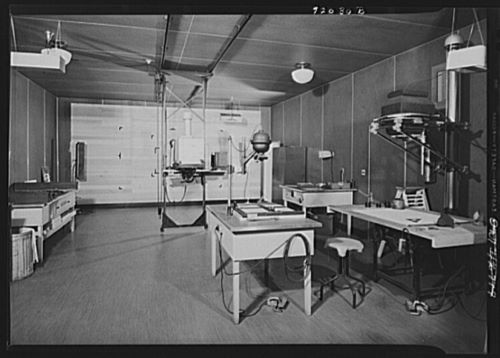
The 170,000 photographs taken between 1935 and 1944 under the direction of the Farm Security Administration (FSA) and the Office of War Information (OWI) constitutes one of the richest photographic archives in the United States, arguably the world. One of the most famous documentary photography collections of the twentieth century, the “Historic Section” created visual evidence of government initiatives alongside scenes of everyday life during the Great Depression and World War II across the United States. Photogrammar provides tools to explore this abundant archive: maps to see photos taken in thousands of locations across the United States, a “treemap” to explore them categorically and thematically, a timeline to concentrate on a given moment in time or a specific photographer, and individual photographer pages with oral histories.
October 29, 1929, more infamously known as Black Tuesday, exacerbated a crisis that would become one of the most dramatic economic downturns in American history: the Great Depression. Millions of Americans were unemployed or underemployed as banks failed and market demand for products plummeted. Confidence in the very foundations of capitalism and government also quickly evaporated. By 1933, over 15 million Americans were unemployed. With the election of Franklin Roosevelt came a shift in policy from the Hoover years. The government focused first on relief followed by recovery and then reform. The set of programs that became known as the first New Deal created over thirty agencies and an extraordinary expansion of the federal government. Among the agencies was the Resettlement Administration (RA), which was established in May 1935 to relocate struggling families to planned communities. The RA came under immediate scrutiny. Looking to persuade the public about the value of their work, agency chief Rexford Tugwell created the Historic Section of the Resettlement Administration and hired Roy Stryker to lead the unit. The section would quickly become one of the most important documentary projects of the twentieth century.
READ ENTIRE ARTICLE AT AMERICAN PANORAMA
Things as They Are
Dorothea Lange created a vast archive of the twentieth century’s crises in America. For years her work was censored, misused, impounded, or simply rejected.
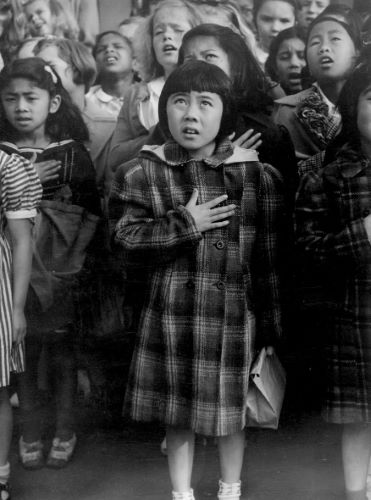
In 1966 the Museum of Modern Art held a retrospective devoted to Dorothea Lange—its first-ever solo exhibition of work by a female photographer. Lange’s photographs have now become part of our collective memory of the Great Depression. Migrant Mother (1936)—a portrait taken in a pea pickers’ camp in California of a woman holding her baby and surrounded by her children—is perhaps one of the most reprinted images in history. But beyond her better-known photographs of the Depression and the Dust Bowl migrations, Lange produced a vast archive of events and crises in the American twentieth century, from the Japanese internment camps to the arrival of the first Mexican braceros and the racial and economic inequality in the judicial system. Many of those photographs were censored by the US government for decades, or simply not published by the magazines that had originally commissioned them.
When John Szarkowski, head of MoMA’s Department of Photography, initially approached her in the early 1960s, Lange was almost seventy years old and suffering from cancer of the esophagus. She had already decided to devote the time she had left to making a series of intimate family portraits, and she agreed to the retrospective with some reluctance. There is film footage of Lange talking to one of her sons in 1963, as she’s looking over a lifetime of work for the exhibition and finding herself at an impasse. Her son tells her she just needs to get the job done, to stop doubting herself and hurry up. After a short pause, she responds: “It is not really modesty on my part. Don’t mistake it. It’s not modesty. It’s that I’m afraid.”
READ ENTIRE ARTICLE AT THE NEW YORK REVIEW
Layered Lives
Rhetoric and representation in the Southern Life History Project.
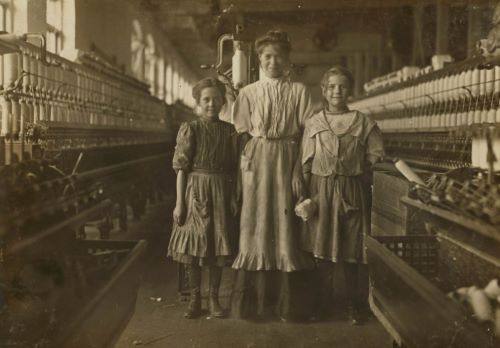
The Southern Life History Project, a Federal Writers’ Project initiative, put unemployed writers to work during the Great Depression by capturing the stories of everyday people across the Southeast through a new form of social documentation called “life histories.”
Layered Lives recovers the history of the Southern Life History Project (SLHP) through an interdisciplinary approach that combines close readings of archival material with computational methods that analyze the collection at scale. The authors grapple with the challenges of what counts as social knowledge, how to accurately represent social conditions, who could produce such knowledge, and who is and is not represented. Embedded within such debates are also struggles over what counts as data, evidence, and ways of knowing. As we look to our current moment, where debates about the opportunities and limits of quantification and the nature of data continue, the problems and promises that shaped the SLHP still shape how we capture and share stories today.
READ ENTIRE ARTICLE AT LAYERED LIVES, STANFORD UNIVERSITY PRESS
How Did Artists Survive the First Great Depression?
What is the role of artists in a crisis?
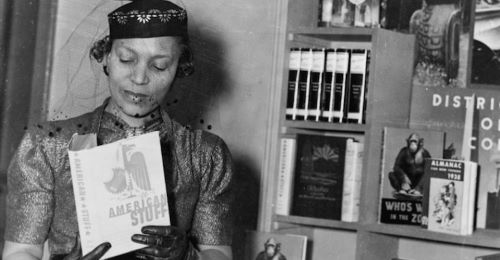
This year the questions come up again with a vengeance: What is the role of artists in a crisis? Writers ask, what does my work mean in this larger emergency? Does my personal creativity matter in the vast public sphere? And most immediately, how do I navigate this meltdown?
When the economy collapsed in 1929, American jobs disappeared at the rate of 20,000 a day. That used to impress people before this pandemic. In the Great Depression, the publishing and arts sectors shrank by about a third, like they have again recently. Creatives were desperate. Then, as now, there was private desperation and there was public desperation.
Harry Hopkins, the New Deal’s jobs program coordinator, focused on the public aspect and short-term solutions. When Congress questioned the idea of supporting artists and writers with jobs in the Works Progress Administration, Hopkins replied that artists had to eat like everyone else. In response to protests in New York by unemployed publishing workers who felt abandoned, the WPA began a small Federal Writers’ Project and others for art, music, and theater. The notion behind “work relief” was that paying work could sustain morale better than direct unemployment payments.
Researching a handful of WPA writers and artists for a book and documentary, I was struck by the variety of their personalities and responses. I found myself examining their choices for clues to getting through our own time. Some were already mature artists, like Zora Neale Hurston, Anzia Yezierska, and Dorothea Lange (who ran a portrait studio in San Francisco for over a decade). Others were fresh out of college like May Swenson, Saul Bellow, and Margaret Walker. Some we may not associate with the 1930s, like Ralph Ellison and Kenneth Rexroth, who for most people remains tied to the Beat poets, though he resented the comparison.
Back then there was even less agreement on a public role for creatives. The Writers’ Project assigned them a public role in producing travel guidebooks, histories, and life stories of everyday Americans, including thousands of narratives of formerly enslaved people. New Deal artists created landscapes, murals, street scenes, portraits, sculptures, and abstracts inspired by American life.
READ ENTIRE ARTICLE AT LITERARY HUB
One of the Most Iconic Photos of American Workers is Not What it Seems
But “Lunch atop a Skyscraper,” which was taken during the Great Depression, has come to represent the country’s resilience, especially on Labor Day.
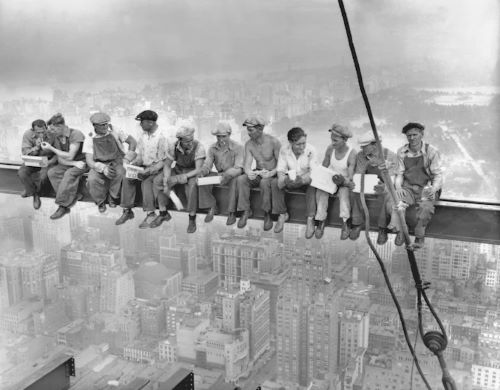
Eleven pairs of shoes were dangling over the New York City skyline. It was September of 1932, as the Great Depression was reaching its height. Unemployment and uncertainty could be felt throughout the city and the entire country. But on West 49th Street, a pillar of hope was under construction: the art deco skyscraper that would come to be known as 30 Rockefeller Plaza.
The ironworkers constructing its 70 floors were taking a break, sharing boxed lunches and cigarettes. They appeared to be completely unfazed by the location of this break: a narrow steel beam jutting out into the sky, hundreds of feet above the pavement.
As one coveralled man helped another light his smoke, someone snapped a picture. The resulting photograph became one of the most iconic images in the world, an embodiment of the spirit of the American worker. It still hangs in pubs, classrooms and union offices across the nation. Construction workers frequently re-create the 87-year-old photo. And every Labor Day, it is shared across social media, in tribute to those whose perspiration and determination built this country.
READ ENTIRE ARTICLE AT THE WASHINGTON POST
The Making of an Iconic Photograph: Dorothea Lange’s Migrant Mother
The complex backstory of one of the most famous images of the Great Depression.
At the end of a long day in March 1936, Dorothea Lange stopped in a migrant workers camp in California for just 10 minutes and took six photos of a woman and her children. The final photo, known as Migrant Mother, became one of the most iconic photographs of the Great Depression.
In this video, Evan Puschak details not only the context the photo was created under (FDR’s administration wanted photos that would shift public support towards providing government aid) but also how Lange stage-managed the scene to get the shot she wanted.
As Puschak notes, the photo we are all familiar with was retouched three years after its initial publication to remove what Lange saw as a detriment to the balance of the scene: the thumb of the woman’s hand holding the tent post in the lower right-hand corner.
The Haunting of Drums and Shadows
On the stories and landscapes the Federal Writers’ Project left unexplored.
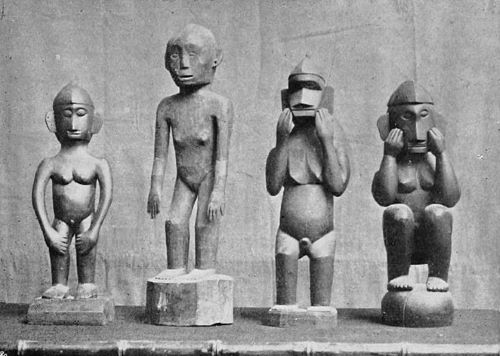
Savannah is haunted. That’s the first thing tourists learn about this city at the northern end of Georgia’s hundred-mile coast—a notion solidified in the popular imagination by the success of Midnight in the Garden of Good and Evil, both the 1994 book by John Berendt and the subsequent film directed by Clint Eastwood. Midnight revolves around a nouveau riche antiques dealer named Jim Williams. Berendt, formerly the editor of New York magazine, happened to be in Savannah in the early 1980s when Williams killed a roughneck rent boy; he chronicled the event’s reverberations through Savannah society, which he depicts as eccentric and decadent. “The whole of Savannah is an oasis,” an informant tells him. “We are isolated. Gloriously isolated!”
“I suspected that in Savannah I had stumbled on a rare vestige of the Old South,” Berendt concludes. This vestige isn’t exactly the plantation fantasy—for Berendt, the Old South seems to have something to do with an enduring, atavistic faith in certain habits and creeds. The white elite believe in social custom; they have their teas and luncheons. Williams, bred in small-town Georgia, is able to insinuate himself into this echelon, but he maintains connections to other worlds, too. Williams buttresses his defense with an extralegal approach: he engages the services of a black root worker named Minerva. (Related to hoodoo, root work is a West African–derived form of folk medicine or magic practiced in the South.) Williams explains to Berendt that Minerva had been the “common-law wife of Dr. Buzzard,” a famous voodoo practitioner. One of Dr. Buzzard’s specialties was in the legal realm, where he “was especially effective ‘defending’ clients in criminal cases. He’d sit in the courtroom and glare at hostile witnesses as he chewed the root.” After Dr. Buzzard died, Minerva continued his work both in and out of the courtroom. A central scene in the book is set in a cemetery: the midnight garden of the book’s title, where Minerva has Williams drop “nine shiny dimes” into the dirt while she communicates with his victim, whom she tries to persuade to “ease off a little.”
In some ways it was a familiar scene, and the notion of the southeast coast’s being “gloriously isolated” was not a novel proposition. Earlier in the century, a similar spirit undergirded another spooky book, Drums and Shadows: Survival Studies Among the Georgia Coastal Negroes, a peculiar volume compiled in the 1930s by workers affiliated with the Federal Writers’ Project’s Savannah Unit. Other FWP workers in the South gathered oral histories of slavery; the Savannah Unit, under the leadership of a white woman named Mary Granger, embarked on a stranger and far more fraught mission. Inspired by the anthropologist Melville Herskovits, Granger believed the lack of outside influence had led black people to retain certain “African” cultural traits or “survivals.” Her idea of what these attributes were is expressed in the book’s title and in her introduction, which mentions “sorcery,” “root doctors,” “miracles and cures,” and “mystic rites.” One such rite would be familiar to Berendt’s readers: “Not very long ago when a man was arrested for murder,” Granger wrote, “his friends, wishing to save him, went to the grave of the murdered man, secured some dirt, and left three pennies on the grave.”
Who’s to say what did the trick, but Jim Williams was eventually acquitted, following his fourth trial. Midnight became a juggernaut, credited with boosting Savannah’s tourism industry while earning it a reputation as uniquely spooky—the U.S.’s “most haunted” city, according to a 2002 designation by the American Institute of Parapsychology (an honor conceded to be “more honorary than scientific”). The Minerva scenes were more or less tangential to the book’s action. Combined with the fact of the murder itself, the strange social scene surrounding it, and the city’s gruesome preexisting history (slavery, several nineteenth-century yellow fever epidemics), they nonetheless seemed to suggest a place imbued to its bones with the macabre—a place where the dead were unusually close at hand. In 2007 the scholar Glenn W. Gentry credited the book with sparking a “boom in Savannah’s ghost tourism trade,” which hasn’t really flagged. Visitors still tour the city in repurposed hearses, walk through colonial and antebellum cemeteries, and pay for admission into purportedly haunted mansions lining Savannah’s famous squares.
Published in 1940, Drums and Shadows was nowhere near as successful as Midnight, but its impact was at least as profound: if Berendt’s book helped shape Savannah’s reputation in the 1990s and beyond, Drums and Shadows did similar work for the whole of the Georgia coast a half century before.1
It continues to be a valuable source for historians, folklorists, the descendants of enslaved people, novelists, artists, and many others, though it was always a plainly fraught endeavor. If white writers traveling the American South in the 1930s in pursuit of what they perceived to be the most “exotic” aspects of people then living under the violent terror of Jim Crow sounds like an ethical and methodological train wreck—well, it is.
READ ENTIRE ARTICLE AT LAPHAM’S QUARTERLY
Solidarity Now
An experiment in oral history of the present.
There are times when, as if by some mysterious alchemical process, mere ink and printed typeface can bring an actual human existence to life, and a person’s voice seems to rise, almost audibly, from the page. In this case, the voice belongs to a Black woman named Emma Tiller who lived in West Texas in the 1930s and worked as a cook for some of the better-off white folks. She and her husband had previously been sharecroppers, and she is speaking of her solidarity with other poor people.
“When tramps and hoboes would come to their door for food, the southern white people would drive them away,” she recalls. Many of these homeless men were white, yet Tiller remembers that when a Black person came to the door, her white employers would offer food and sometimes money. “They was always nice in a nasty way to Negroes,” Tiller observes. And so she and other domestics went out of their way to help the white men who were driven off.
When the Negro woman would say, “Miz So-and-So, we got some cold food in the kitchen left from lunch. Why don’t you give it to ’im?” she’ll say, “Oh, no, don’t give ’im nothin’. He’ll be back tomorrow with a gang of ’em. He ought to get a job and work.” . . . Sometimes we would hurry down the alley and holler at ’im: “Hey, mister, come here!” And we’d say, “Come back by after a while and I’ll put some food in a bag.” . . . Regardless of whether it was Negro or white, we would give to ’em.
Tiller’s words were recorded and quoted, along with those of more than 150 others who lived through those years, by Studs Terkel in his 1970 oral history of the Great Depression, Hard Times. It’s a period that’s been much on my mind this past year, as Americans have suffered mass unemployment and social upheaval on a scale not experienced since the thirties—a time when the American system appeared on the brink, and a wave of radicalism, of desperate people and emboldened social movements, rose to meet the moment.
There are plenty of political and economic histories of the period, but they tend to lose sight of the daily realities of lived experience. Which may be why, last spring, when life as we knew it fell off a cliff—when our converging catastrophes, political and planetary, were overtaken by the coronavirus pandemic—I became preoccupied with what it was really like to survive through that earlier decade of crisis, how it was that people and communities and movements held together or came apart under extreme conditions. And so I reached for Terkel’s book and other such documents, and I was reminded of the great value, especially in a theory-heavy time, of oral history as a form: its testimony to the unavoidable and not always convenient fact that history and politics, economic forces and mass movements, are driven not simply by ideological and demographic abstractions but by individual, living-breathing human beings.
READ ENTIRE ARTICLE AT THE BAFFLER
Lewis Hine, Photographer of the American Working Class
Lewis Hine captured the misery, dignity, and occasional bursts of solidarity within US working-class life in the early twentieth century.
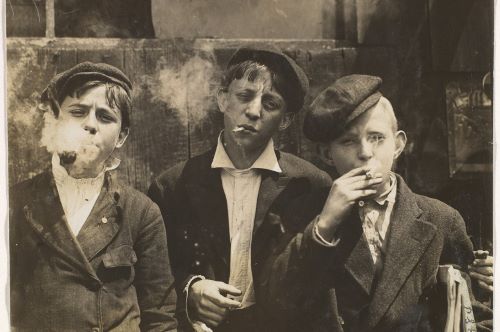
Late in his career, labor photographer Lewis Wickes Hine used his camera to capture the best of working life in the United States. As the New Deal ushered in job opportunities and social welfare programs for a large swath of the American population, he documented the country’s gradual recovery from the Depression. Photographs of a Works Progress Administration (WPA) childcare center mark a progression from his famous child labor photographs three decades earlier.
While he lived long enough to see robust federal aid that empowered laborers, Hine is best known for work that challenged capitalist exploitation in the workplace. Driven by his belief that labor was the soul of America, he attributed the nation’s achievements to the individual men, women, and children who made them possible.
Hine’s lifetime roughly paralleled the Second Industrial Revolution, from 1874 to 1940. The era’s increasing speeds of manufacturing stretched the physical limits of manual labor, while photography as a medium evolved from a surveillance tool to a method of exposure. As an investigative photographer, Hine chronicled the normalized labor abuses in US factories leading up to the Great Depression. Not only did he help introduce some of the country’s first child labor laws, he also revolutionized photography’s artistic use value.
Hine once argued that a good picture is “a reproduction of impressions made upon the photographer which he desires to repeat to others.” For him, an organized workforce was the epitome of empathy and mutual benefit, which he hoped to convey to the greater American public.
READ ENTIRE ARTICLE AT JACOBIN
Chester Higgins’s Life in Pictures
All along the way, his eye is trained on moments of calm, locating an inherent grace, style, and sublime beauty in the Black everyday.
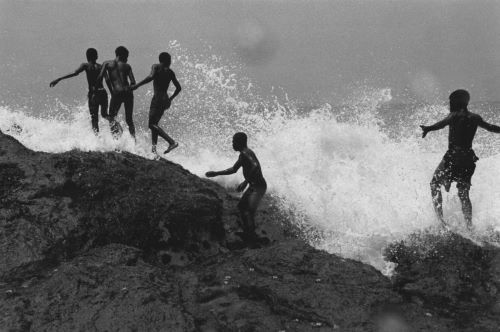
When Higgins began making photographs for magazines and newspapers, in the late nineteen-sixties, he was one of a handful of Black photographers working in mainstream media. Much of the work produced in his thirty-nine years as a staff photographer at the Times was a concerted attempt to incorporate Black America into the world’s consciousness. “When I arrived at The New York Times in 1975, I felt the media was immune to any real comprehension of the world I knew well,” he wrote at the time of his retirement from the paper, in 2014. “I wanted to share the history and traditions of the people I grew up with.”
Higgins grew up in New Brockton, Alabama, where, as a nine-year-old, he first encountered the spirit in his bedroom. He recalls waking in the middle of the night to a vision of a Black man in ancient clothing; the figure meditated, and then began to move toward him. “It said, ‘I come for you,’ ” Higgins told me, “and I screamed.” His elders understood the sighting as a call to faith, and he spent the following years preaching to congregations around his county as a youth minister.
It wasn’t until Higgins matriculated at the Tuskegee Institute, however, that he found his true vocation. He was studying business management and handling the budget for the campus newspaper. One semester, the paper was over budget, so Higgins had the idea of selling large photographic advertisements to local businesses to fill the gap. He commissioned P. H. Polk, Tuskegee’s official university photographer—and the only person Higgins knew with a camera—to take them.
Come press time, the pictures had yet to materialize, so Higgins went to Polk’s studio to track them down. He noticed old photographs that Polk had made during the Depression, portraits of Black farmers. Polk had lived on a busy road, a route where country folk would walk or drive mule-drawn wagons to sell their harvest at the weekend market. Every time a character caught Polk’s eye, he would hop off his porch and offer them five dollars to come pose for portraits inside his home studio. These images were revelatory for Higgins. In them, not only did he recognize people that could have easily been his “great aunts and uncles” but he also was struck by a certain stately quality in the treatment of the photo’s subjects.
“Nowhere were the elements of decency, dignity and virtuous character recorded in photographs of African Americans,” Higgins wrote in his 2004 photo-memoir, “Echo of the Spirit.” While he was growing up in southeast Alabama, in the fifties and sixties, the images of Black people in popular media that Higgins encountered were often of a particular bend; he disliked that “we were always seen as potential thugs or rapists.” And, back then, Higgins conceived of photography as a procedural craft rather than an artistic one. “It wasn’t tracing your emotions,” he told me. “It was objectifying something that had happened, some event, some cause.” It was only through his visit to Polk’s studio, and the marvel of those dignified portraits, that he began to realize the expressive—and corrective—potential of photography. The camera, he found, could be a vehicle for conveying the poise and esteem that emanated from the people around him and animated much of his early life.
READ ENTIRE ARTICLE AT THE NEW YORKER
How Eudora Welty’s Photography Captured My Grandmother’s History
Natasha Trethewey on experiencing a past not our own.
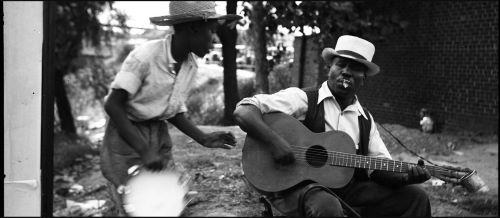
I was given my first copy of Eudora Welty’s Photographs in 1990, not long after the book’s initial publication. Back then I was in my first year of graduate school, having committed myself to becoming a writer. Of course, I had found my way to Welty before that—through her stories and her illuminating meditation on the origins of her work in One Writer’s Beginnings. As a native Mississippian, I was drawn to this remarkable woman as much for the clarity and vision and truth of her fiction as for the history we shared—rooted in place—the fate of our geography.
“Place,” she wrote, “geography and climate shapes characters. . . . It furnishes the economic background [a writer] grows up in, and the folkways and the stories that come down to him in his family. It is the fountainhead of [her] knowledge and experience.” Looking at her photographs, I found the documentary evidence: the truth not only of her imagination but also of her experience, her deep observation, a record of what she had seen.
This was transformative for me. Already, I had begun writing notes in my journal for poems about my maternal grandmother, a black woman born in Gulfport, Mississippi, in 1916, who’d come of age in the 1930s. As long as I can remember I had been listening to the stories about her life, her journeys, the work she’d done to survive, the work she loved, her faith and endless striving. I listened trying to see the palimpsest of her world overlaid on my own, the Mississippi I’d entered in 1966, 50 years after her, on the heels of major advancements in the civil rights movement—the Civil Rights and Voting Rights Acts of 1964 and ’65.
READ ENTIR ARTICLE AT LITERARY HUB
Shelter in Place
How the misery of homelessness continues to be compounded in America’s cities.
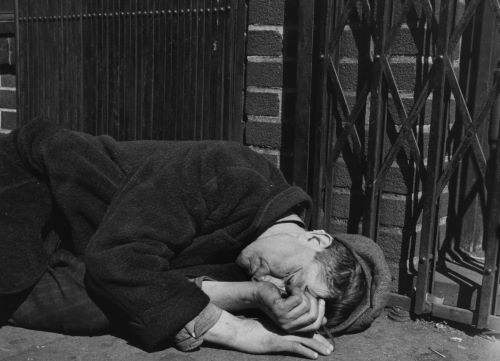
A Dust Bowl migrant may be the figure who most Americans would imagine when they think of Depression-era homelessness, and Dorothea Lange’s 1936 portrait of Florence Owens Thompson, sometimes called Migrant Mother, is easily the most famous depiction. Lange, a photographer for the Farm Security Administration, came across Thompson in Nipomo, California, where the latter was a 32-year-old migrant farmworker, traveling with her seven children to wherever she could find work. The images Lange shot were used to illustrate a wire-service story about hungry workers in the frost-ravaged pea fields. Roy Stryker, head of the FSA photo unit, declared the photograph to be the “ultimate” image produced by his organization.
But Migrant Mother’s iconic status could overshadow the fact that homelessness was also a major problem in American cities during the Depression, both for locals and for the unemployed people from out of town who had hoped to find relief in industrial centers. It’s difficult to determine exactly how many city-dwellers were homeless, but a national survey from 1933 estimated the number at 1.5 million people, half of whom were transients without a permanent address in any state.
Most homeless people were unskilled laborers, but factory workers and domestic employees were also vulnerable to losing their jobs, and their homes. Perhaps most alarming to the American imagination was the plight of the white-collar workers—those who had seemingly achieved a level of security that should have kept them from the bread lines, but found themselves on the streets. Housing relief favored families, so many of the homeless were singles, or “unattached.”
Cities were overwhelmed by the newly homeless masses. In 1933, Franklin D. Roosevelt became president, and the federal government stepped in to help with the Federal Emergency Relief Administration (FERA), which devoted an initial fund of $500 million to relief efforts. This included the Federal Transient Program, which helped create a network of shelters around the United States for the homeless, many of whom were barred from receiving assistance from municipalities because they could not prove they once had a local address. Warehouses, offices, stores, garages, schoolhouses, and hotels were converted to homeless lodgings. Separate from these efforts, some people congregated in shanty towns that came to be called “Hoovervilles,” after the president on whom many blamed for their misfortune. One of the largest, in Seattle, sprawled over nine acres of public land and housed up to 1,200 people. Hoovervilles clustered around every major city in New York during the Great Depression; from 1931 to 1933, a Hooverville occupied what is now Central Park’s Great Lawn.
March of the Bonus Army
In 1932, twenty-thousand unemployed WWI veterans descended on Washington, DC to demand better treatment from the federal government.
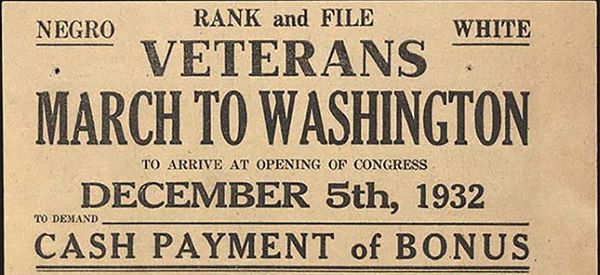
In the summer of 1932, a group of World War I veterans in Portland, Oregon hopped a freight train and started riding the rails to Washington DC. They were demanding immediate payment of a cash bonus the government had promised them after the war – but delayed until 1945. Desperate for relief in the worst year of the Depression, the vets wanted their bonuses now. They called themselves the Bonus Army.
As they traveled east, veterans from all over the country joined up. By July, more than 20,000 veterans and their families had arrived in the nation’s capital. They established a tent city and vowed to stay until their demands were met. But finally, in a historic confrontation, General Douglas MacArthur’s Army troops routed the Bonus Army and burned their camp to the ground.
The Rise and Fall of New York Public Housing: An Oral History
New York City public housing has become synonymous with dilapidated living conditions. But it wasn’t always like this.
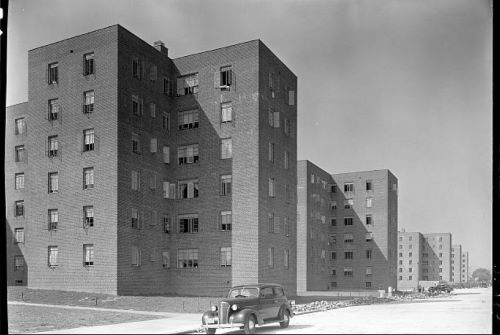
No heat. Leaking roofs. Mold and pests. Interminable waits for basic repairs.
Public housing in New York City has become synonymous with the dilapidated living conditions many of its more than 400,000 residents have endured in recent years.
But it wasn’t always like this in the 325 housing projects owned and managed by the New York City Housing Authority, also known as Nycha. The country’s largest public housing system was once a seemingly reliable option for the working poor . Nycha successfully endured some of New York City’s most turbulent eras while other public housing buildings across the country came tumbling down.
Now, Nycha is at a crossroads. As part of a settlement in June in which Nycha admitted to covering up its actions and lying to the federal government, a court-appointed monitor will soon oversee the beleaguered agency as it tries to come up with billions of dollars to keep thousands of its aging buildings habitable for decades to come.
To understand how Nycha arrived at this point, we combed through our photo archives for forgotten images and spoke to longtime residents, former housing officials, historians and others about the housing authority’s often overlooked and surprising eight-decade history. That story, in their words, is below.
READ ENTIRE ARTICLE AT THE NEW YORK TIMES
Politics
When FDR Took On the Supreme Court
The standard narrative of Roosevelt’s court-packing efforts casts them as a failure. But what if they were a success?
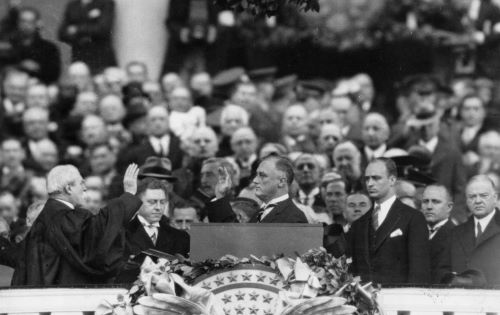
In her new book, FDR’s Gambit: The Court Packing Fight and the Rise of Legal Liberalism, the distinguished historian Laura Kalman has written the best account of the one time in the past century and a half that the number of justices seemed likely to change: when Franklin Delano Roosevelt, in the midst of his epic clash with the federal judiciary over the fate of the New Deal, tried and failed to radically increase the number of seats on the court. Kalman offers a blow-by-blow account of the law and politics behind what Roosevelt’s political adversaries successfully branded as his attempt to “pack the court.” She captures what was at stake in the fight, lays out FDR’s options, and rehearses the political tactics of the contending sides—the thrusts and parries, the missteps and the ingenious maneuvers. We may never have a better recounting of the law and politics of this particular moment of history.
Kalman’s engaging book is timely, too. In the years since a Republican Senate prevented Barack Obama from filling the seat vacated by the death of Justice Antonin Scalia in 2016, some Democrats have revived talk of altering the court’s size. Such proposals grew louder when Donald Trump’s one-term presidency produced three new justices, including one (Amy Coney Barrett) who took the seat vacated by the death of Ruth Bader Ginsburg weeks before the 2020 elections. But critics from across the political spectrum deride the idea and point to Roosevelt’s thwarted effort. For generations, they note, observers have condemned the maneuver as an unprincipled and politically ham-fisted mistake, in which FDR gambled away a good deal of his considerable political capital on a futile and foolish attempt to influence the court.
Kalman disagrees. Roosevelt’s attempted court packing, she contends, was a savvy, high-stakes move by perhaps the most politically astute president in US history. Yes, Roosevelt made mistakes. But in her meticulous account, Kalman shows that he won his struggle to transform the American constitutional order because of, and not merely in spite of, his attack on the court. The court-packing initiative shielded Roosevelt’s great legislative triumphs from judicial interference in a way that no other available strategy could have accomplished.
READ ENTIRE ARTICLE AT THE NATION
On Economics and Democracy
High unemployment is extremely dangerous.
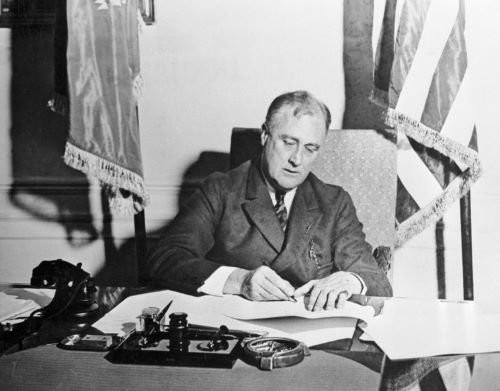
spoke at a gathering in Washington organized by Leah Hunt-Hendrix and Adam Jentleson on what they are calling “Inclusive Populism” — an economic agenda that defends the rights of all working people, whatever they may look like. I encourage everyone to read Blake Hounshell’s New York Times piece on the event, and I’ve included the full text of my talk below.
As you can see, the talk took a much wider orbit than the current macro landscape. But I want to emphasize the point I made about the recent infatuation with unemployment that has taken root in economic discourse. It is extremely dangerous for folks like Larry Summers and Sheila Bair to be invoking Paul Volcker and the spectre of double-digit unemployment as a solution to current price pressures. Deliberately engineering a wave of layoffs would not address the primary drivers of inflation, and high unemployment would damage the American social contract at a time when our democracy is obviously fragile, and authoritarianism is on the march around the globe. For democracy to survive, it has to work for working people.
Here’s the talk:
There are not many positive things that a 21st century Democrat can say about the Democratic Party of 1931. In the South, the party served as the administrative and enforcement mechanism for Jim Crow. Two sitting Democratic Senators were members of the Ku Klux Klan, and five other Democratic Senators had been hand-picked by the Klan over the course of the 1920s, when the Klan also successfully installed five Democratic Governors in states as far-flung as Georgia and Oregon.
Though Democratic Party machines in some Northern cities often did respond to the needs of immigrant communities, at the federal level, the party was ferociously anti-immigrant. In 1924, 158 House Democrats voted to radically curtail immigration, with only 37 rising in opposition. Senate Democrats voted 33 to 3 in favor of the crackdown.
Although women were allowed to vote in 1931, they did so over the objections of Southern Democrats, who torpedoed the vote for women’s suffrage four times in 1918 and 1919, weaponizing the filibuster to block the vote when they couldn’t marshal a majority.
Democratic Party economics were officially laissez-faire, but at both the state and federal level Democrats shoveled subsidies to bankers and railroad barons as they decried labor unions, labor laws and minimum wage regulations. The typical Southern Democrat was not economically liberal and socially conservative – he was economically conservative and socially violent.
It would be interesting if all these horrors added up to some kind of unstoppable electoral powerhouse, but in fact the Democratic party of 1931 was terrible at winning elections. It had enjoyed a Senate Majority in just 10 of the 66 years following the Civil War, and only two Democrats had served as president over that period – both leaving office amid near-comprehensive political washouts.
In short, in 1931, the Democratic Party was racist, incompetent and controlled by the wealthy – and had been for as long as anyone could remember.
READ ENTIRE ARTICLE AT IN THE LONG RUN
Woody Guthrie: Folk Hero
Guthrie challenged the commercial aesthetic of the pre-rock era through a performance style that was almost combatively anti-musical.
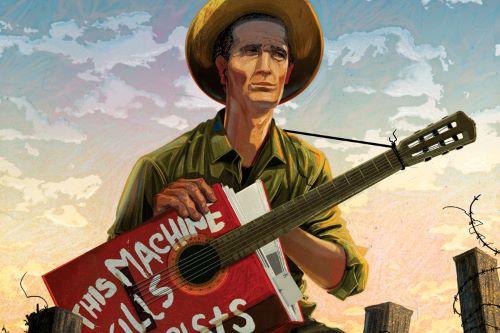
For all his advocacy of the common man, Guthrie sought to be recognized as someone exceptional. Agnes (Sis) Cunningham, his sometime bandmate (along with Seeger, Bess Hawes, Millard Lampell, Lee Hays, and others) in the Almanac Singers, the leftist vocal group of the forties, told me a few years ago that Guthrie was “determined to become a legend in his own time.” (Cray quotes Hawes as saying that Guthrie was “desperate” to become “a big, important person.”) After all, he did not call his autobiography “Bound for Obscurity,” and the book is dense with folksy anecdotes that dramatize his innate superiority to government officials, businesspeople, other authority figures, and most of his friends. “Bound for Glory” captures Guthrie vividly; he was fearsomely gifted and ambitious, and also egalitarian—a most uncommon man.
Woody Guthrie succeeded in becoming a legend in the last years of his life, as young people of the postwar era, seeking their own cultural identity, veered away from the coolly sophisticated, urbane pop on their parents’ hi-fis in favor of more idiomatic music grounded in rural America—folk, country, the blues, and their hybrid, rock and roll. Students by the thousands massed in Washington Square Park each week to strum along to “This Land Is Your Land,” and to look for Woody Guthrie, the exemplar of the folkie ideal. He was unable to take active part in his newfound idolhood, however. Debilitated by Huntington’s disease, a degenerative disorder of the nervous system, Guthrie became a tragic figure to his young acolytes: an American original cut down before his time, seemingly gone mad (wildly erratic behavior being a symptom of the disease)—a living amalgam of Hank Williams and Friedrich Nietzsche. When the nineteen-year-old Bob Dylan arrived in New York from Minnesota in January of 1961, he told his friends that he was going to meet his god, Woody. “He’s the greatest holiest godliest one in the world,” Dylan said of Guthrie around that time—a “genius genius genius genius.”
Reflecting on the period later, Dylan explained, “Woody turned me on romantically. . . . What drew me to [him] was that, hearing his voice, I could tell he was very lonesome, very alone, and very lost out in his time. That’s why I dug him. Like a suicidal case or something. It was like an adolescent thing—when you need somebody to latch onto, you reach out and latch onto them.”
With today’s rock and pop feeling homogeneous, and with hip-hop now twenty years old, popular music is ripe for something new. Whatever comes will surely be something that challenges the complacency of the mainstream; something from disreputable sources; something critical of the status quo, harsh, simple, seemingly anti-musical, and doable without formal training—that is to say, something much in the vein of what Woody Guthrie did. If few nineteen-year-olds today think of latching onto Guthrie, his spirit may be closer than they know.
READ ENTIRE ARTICLE AT THE NEW YORKER
Herbert Hoover Did Something Donald Trump Was Unwilling to Do
While Herbert Hoover was deeply critical of his successor, he put aside his differences to ensure the peaceful and democratic transition of power.
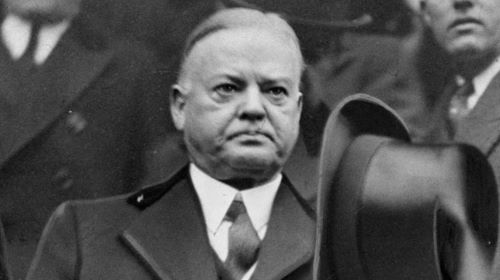
For most of the country’s history, a peaceful transition of power has defined American democracy. That does not mean we have always been a nation united. What marks Joe Biden’s inauguration as different is not the disagreement among parties and peoples, but rather how the opposition expresses those differences.
On March 4, 1933, President Herbert Hoover and President-elect Franklin Roosevelt sat next to each other in an open car in stony silence for the short ride from the White House to the Capitol for Roosevelt’s inauguration. By this time, the two men despised each other. For the rest of his life, Hoover accused Roosevelt of driving the country deeper into the Great Depression and causing the banking panic that awaited the incoming executive. After the swearing-in, Hoover shook the new President’s hand, boarded a train for New York – and the two leaders never saw each other again.
In the months between the election and the inauguration, a lame duck period of four months before the passage of the 20th Amendment that shortened the interregnum, Hoover warned that Roosevelt would be the death of the democracy. On the campaign trail, he predicted that if the Democrats won, “the grass will grow in streets of a hundred cities, a thousand towns.”
“When the American people realize some 10 years hence it was on November 8, 1932, that they surrendered the freedom of mind and spirit for which their ancestors had fought and agonized for over 300 years, they will, I hope, recollect, that at least I tried to save them,” Hoover wrote privately to a friend after the election.
On March 3, the day before the inauguration, instead of inviting the Roosevelts for the customary dinner, Hoover had them to the White House for tea. It did not go well. Roosevelt recalled, “I hustled my family out of the room. I was sure Jimmy (his eldest son) wanted to punch him (Hoover) in the eye.”
A Summer of Protest, Unemployment and Presidential Politics – Welcome to 1932
The parallels between the summer of ’32 and what is happening now are striking.
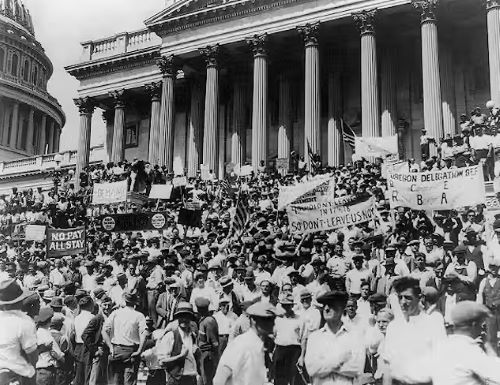
An election looms. An unpopular president wrestles with historic unemployment rates. Demonstrations erupt in hundreds of locations. The president deploys Army units to suppress peaceful protests in the nation’s capital. And most of all he worries about an affable Democratic candidate who is running against him without saying much about a platform or plans.
Welcome to 1932.
I am a historian and director of the Mapping American Social Movements Project, which explores the history of social movements and their interaction with American electoral politics.
The parallels between the summer of 1932 and what is happening in the U.S. currently are striking. While the pandemic and much else is different, the political dynamics are similar enough that they are useful for anyone trying to understand where the U.S. is and where it is going.
READ ENTIRE ARTICLE AT THE CONVERSATION
The Bitter Origins of the Fight over Big Government
What the battle between Herbert Hoover and FDR can teach us.
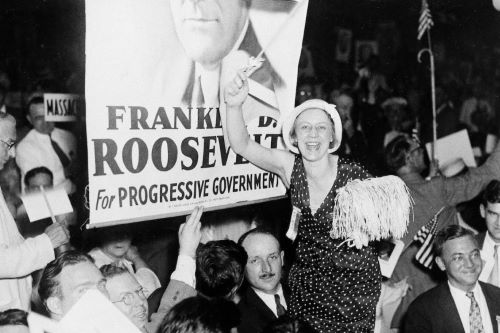
In January 1933, President Herbert Hoover found himself in a position familiar at that point to millions of Americans: He was about to lose his job. Unsure of what the future might hold, he considered whether to accept an offer of a regular appearance on a weekly radio program sponsored by the Old Gold tobacco company. Hoover found the idea distasteful—becoming a speaker on a show whose ultimate purpose was to advertise cigarettes seemed to him a debasement of the presidency—but it was a desperate time. As he wrote to his press secretary, Theodore Joslin, “It is probably something I cannot do, but, well, I hate to say it, but I need that $150,000, Ted.”
Meanwhile, the financial structure of the United States was approaching collapse. At the start of Hoover’s presidency, 24,000 banks had been open for business throughout the country. By 1933, 10,000 of these had shut their doors. One state after another—Nevada, Iowa, California—was suspending normal bank operations in order to keep frightened depositors from withdrawing their cash. Publicly, Hoover insisted that the solution to the panic was a recommitment to the gold standard by nations that had recently abandoned it, such as Great Britain; he blamed the impending Roosevelt administration for sowing fear and discord. But privately, only a day before Michigan declared a bank holiday to protect its faltering financial system, he told Edgar Rickard, an old friend from Hoover’s days as a mining engineer and executive, to withdraw “$10,000 in bills” for emergencies.
The story of an angst-filled Hoover quietly squirreling away funds while lecturing the country about the moral necessity of keeping the banks open is one of the pleasures of Eric Rauchway’s Winter War, a crisp narrative of the four-month interregnum between Franklin D. Roosevelt’s victory in November 1932 and his assumption of the presidency in March 1933. To write a whole history of what is essentially a prelude may seem odd. But Rauchway, who teaches at UC Davis, argues that in the conflict between the lame-duck Hoover and the incoming Roosevelt, we can already see the tension between the New Deal and the opposition to it that would structure American politics for much of the rest of the 20th century.
The New Deal, he maintains, was not a matter of invention and experimentation, as it has sometimes been interpreted to be. On the contrary, it reflected a clear ideological direction—one that American voters had consciously chosen in the fall of 1932. What is more, he suggests that these four months marked a distinctive moment of uncertainty and crisis in American history—a time of panic, anxiety, and political violence, when the basic economic and political structures of the United States were challenged in ways that they had not been since the Civil War. Rauchway presents a Roosevelt for our own polarized age, an act of historical imagination that delivers real insights yet also simplifies a complex period.
READ ENTIRE ARTICLE AT THE ATLANTIC
Mankind, Unite!
How Upton Sinclair’s 1934 run for governor of California inspired a cult.
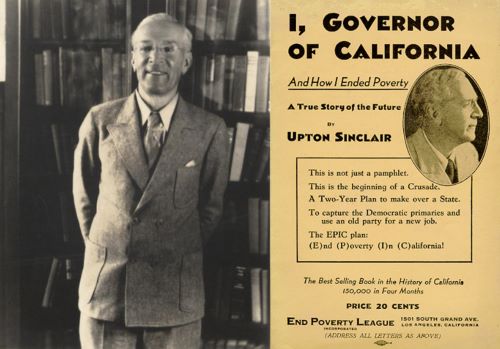
When muckraker and novelist Upton Sinclair decided to make a third run for the California governor’s mansion in the election of 1934, he released an innovative piece of campaign literature to launch his bid. Titled I, Governor of California—And How I Ended Poverty, the novella-length tract contained an imaginative text titled “The People’s History of California.” Written in 1933 at the nadir of the Great Depression and narrated from an imagined 1938, this “history” described the momentous events that transpired in the years between, a period that coincided with a Sinclair administration in California.
By today’s standards, publishing fictive future history might be deemed a catastrophically self-indulgent way to begin a campaign. But readers in the 1930s recognized that Sinclair was resuming the reasonably esteemed late Victorian practice of using utopian and dystopian fiction to animate a political movement. Following in the footsteps of Edward Bellamy, William Morris, William Dean Howells, and Jack London, among others, Sinclair believed that what contemporary politics lacked was imagination. Another way of doing things was possible.
Sinclair couldn’t have known that although his visions of California’s future would not materialize, the movement he inspired—and the literary catalyst he used to build it—would nevertheless leave a deep impression on the state. His campaign helped give shape to two California cults: one an ingenious fraud, the other a deadly dream.
READ ENTIRE ARTICLE AT LAPHAM’S QUARTERLY
A Love Letter to an Extinct Creature: The Liberal Republican
“The Improbable Wendell Willkie” offers a look at how American politics might have been.
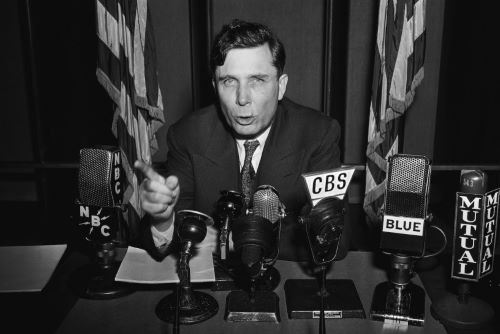
For Americans who even know the name, Wendell Willkie is the answer to a trivia question — the third of four Republicans who lost presidential elections to Franklin D. Roosevelt. The election of 1940, when recalled at all, invokes the norm-shattering third term Roosevelt won. Willkie hardly merits a mention.
Yet to ignore that election and the man who lost it is to miss a vision of American politics that might have been. So argues David Levering Lewis, a history professor emeritus at New York University and two-time Pulitzer Prize winner, in “The Improbable Wendell Willkie.” With meticulous attention to detail, Lewis recounts the life story of an intriguing character: a longtime Democrat who retained his Midwestern affect as he scaled the heights of corporate and political power — thus mocked by Interior Secretary Harold Ickes as a “simple, barefoot Wall Street lawyer.”
This biography is one part political yarn, one part love letter to an extinct creature: the liberal Republican. Willkie himself lost the White House in a blowout and died, unexpectedly at age 52, shortly before Roosevelt’s final reelection in 1944. Nonetheless, the author argues, Willkie’s embrace of internationalism and acceptance of the New Deal recalibrated the Republican Party and reshaped postwar American politics.
READ ENTIRE ARTICLE AT THE WASHINGTON POST
The Art of the New Deal
Despite a fractured party and health concerns, FDR capitalized on name recognition to win the 1932 presidential election.
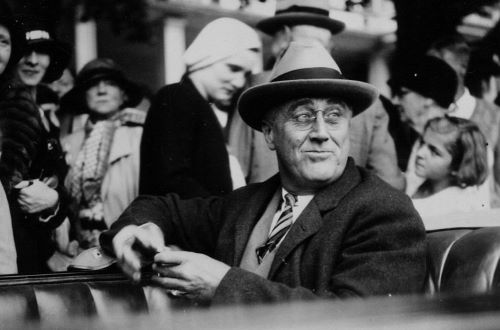
Membership in a political party that had prevailed in only two presidential races out of the last nine and was divided on matters both trivial and ideologically significant. Party rules that required a large majority of delegates to gain nomination. A reputation as a lightweight flip-flopper who went back on his word. Despite all of these obstacles, in 1932, Franklin Delano Roosevelt became the last candidate to emerge from a brokered convention and win the presidency. How did he do it?
Roosevelt’s involvement in presidential politics began in 1920. The Democrats named the 38-year-old, whose most high-profile previous appointment was as Woodrow Wilson’s assistant secretary of the Navy, as their vice presidential nominee on the 1920 ticket alongside Ohio Gov. James M. Cox. Warren Harding and Calvin Coolidge won decisively that year. The Republicans also carried both houses of Congress. This was a political catastrophe for Cox but gave Roosevelt—a handsome, charismatic, wealthy New Yorker with an easy charm and a beloved last name—a chance to introduce himself to a wider audience
But then FDR, vacationing in New Brunswick, Canada, at his family’s cottage in the summer of 1921, came down with polio. As the months after the initial illness passed, it became clear that the next few years would have to be devoted to physical rehabilitation. The setback turned into an opportunity for Roosevelt to retreat at a time when his party was adrift. “If a Democrat with presidential ambitions had to come down with the disease, he couldn’t have chosen a better time than the early 1920s,” writes historian H.W. Brands. “The decade after the World War was a wilderness period for the Democrats,” pulled between the Tammany bosses of New York City, who were “wet” (i.e., for the repeal of Prohibition), pro-immigration, and economically conservative, and Southern racists, who were dry, anti-immigrant and anti-Catholic, “with western mavericks shouting from the sideline.”
Environment and Infrastructure
Where Would We Be without the New Deal?
A new history charts the forgotten ways the social politics of the Roosevelt years transformed the United States.
Find out what a historian thinks about the New Deal, and you will quickly find out what they think about the virtues and failures of the liberal state writ large. For Arthur Schlesinger Jr., how Franklin D. Roosevelt responded to the worst downturn in US history “was a matter of seeing whether a representative democracy could conquer economic collapse,” and the aggressive actions he took restored Americans’ faith in that system. For Howard Zinn, on the other hand, the gush of new federal programs merely ended up reinforcing the shaky grip of the reigning capitalist order. When the New Deal ended, he argued, “the rich still controlled the nation’s wealth” and “the same system that had brought depression and crisis…remained.” Recently, the conservative writer Amity Shlaes dismissed the very notion that FDR and his allies were either liberal heroes or repairers of a damaged status quo. Instead, she blasted the longest-serving president in US history for caring “little for constitutional niceties” and ramming through policies that were “often inspired by socialist or fascist models abroad.”
In Why the New Deal Matters, the historian Eric Rauchway gives us his own interpretation and suggests how liberalism might rebound in the present. For Rauchway, the New Deal altered US society in ways that many Americans neither realize nor appreciate but that often endure. One of the most learned and nimble analysts of the New Deal, Rauchway acknowledges that what Roosevelt and his liberal successors managed to achieve fell quite short of the bold appeal that FDR had made to Congress in his 1944 State of Union address: to “explore the means for implementing [an] economic bill of rights” that would establish “a new basis of security and prosperity…for all regardless of station, race, or creed.” But Rauchway illustrates what the New Dealers did accomplish by examining four areas of the country—two on the coasts and two in the agricultural midland—where they initiated ambitious programs that changed the daily lives of millions. His final chapter details how many of the sidewalks, schools, and post offices that still exist on “the street where you live” were results of the New Deal’s efforts to build a lasting infrastructure to serve ordinary people.
READ ENTIRE ARTICLE AT THE NATION
The New Deal Wasn’t What You Think
If we are going to fund a Green New Deal, we need to acknowledge how the original actually worked.
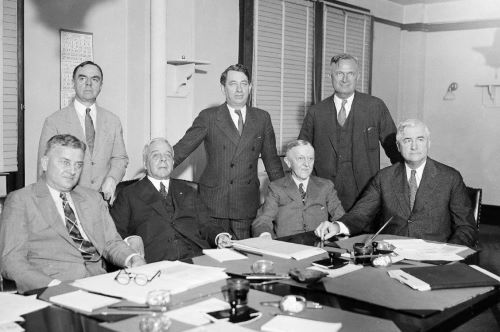
The term Green New Deal might remind Americans of high-school history class. What was the original New Deal about, again? Most kids are taught that it was a decidedly left-wing project to end the Great Depression, a series of big-spending government programs such as the Public Works Administration, with its schools and stadiums. That impression colors the debate over the Democrats’ important new proposal: Conservatives warn of catastrophic federal debts while liberals insist that top-down investment was and is crucial to managing disaster.
But the high-school narrative is not quite right. It leaves out the parts of the New Deal that encouraged private investment.
At the center of this other New Deal was the Reconstruction Finance Corporation (RFC), an independent agency within the federal government that set up lending systems to channel private capital into publicly desirable investments. It innovated new systems of insurance to guarantee those loans, and delivered profits to businesses in peril during the Depression. Unionists, farmers, and consumers benefited as well, all without the government needing to spend a dime of taxpayer money.
The story about the New Deal we have in our heads—that it was tax-and-spend liberalism at its worst (if you are conservative) or best (if you are liberal)—may obscure policy opportunities today. We can spend taxpayer money to address climate change, and we probably should, but that is not the only option. If we are going to fund a Green New Deal, we need to acknowledge how the original New Deal actually worked.
After the stock-market crash of 1929 and the mortgage crisis of 1932, bankers’ capital sat idle. “Our excess reserves are very big,” James Perkins, the head of National City Bank wrote to his colleague Amadeo Giannini, the head of Bank of America in 1934, and “it is almost impossible to find any use for money in credits that we are willing to take, and the rates are terribly low.” Perkins’s situation was not unusual. According to Perkins, excess reserves across the country totaled more than $1 billion (in 1934 dollars). The country’s banks and corporate coffers overflowed with capital that financiers felt unable to invest profitably. Without an outlet for those funds, even the still solvent banks would fall apart eventually—and so would the country. Capitalism depends on the investment and reinvestment of capital.
President Franklin D. Roosevelt’s genius was that he knew he had to get capitalism moving again. But the man who actually figured out how to do that was, ironically, inherited from the Hoover administration: Jesse Jones.
READ ENTIRE ARTICLE AT THE ATLANTIC
Infrastructure is Good for Business
During the Depression, business leaders knew that public works funding was key to economic growth. Why have we forgotten that lesson?
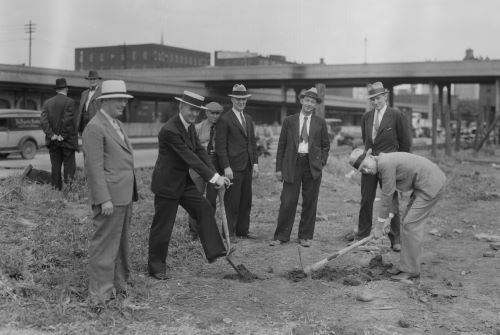
Democrats last week announced a counterproposal to President Trump’s blueprint for new investments in infrastructure. In contrast to Trump’s plan, which relies primarily on private financing, the Democrats are proposing a whopping $1 trillion of direct federal spending to upgrade the nation’s bridges, roads, transportation systems, and public buildings. The Democrats’ proposal is doomed to remain just that – a proposal – given GOP control of Congress. But it may signal the kinds of contrasts Democrats will try to draw with Republicans in midterm contests this fall.
These sharply opposed approaches call to mind debates over the last great flurry of American investments in infrastructure. Between 1933 and 1939, in the depths of the Great Depression, Franklin Roosevelt’s New Deal put unemployed Americans to work building infrastructure and civic assets through a range of programs that ultimately totaled about two thirds of all federal emergency expenditures. In 1933, the Public Works Administration received an initial appropriation of $3.3 billion (roughly $64 billion today), and, in 1935, the Works Progress Administration (WPA) came online with a $4.88 billion budget (roughly $89 billion today). In terms of expenditures, then (as opposed to, say, regulations), the New Deal was primarily a massive public works program.
In both popular and scholarly memory, the primary beneficiaries of the New Deal were the men who gained public employment, and the broader civic sector, which gained an unprecedented bequest of facilities and improvements. More than eight million Americans were directly employed through the WPA, resulting in some 78,000 bridges and nearly 40,000 public buildings, including libraries, post offices, and swimming pools. The Public Works Administration (PWA), meanwhile, contracted with private firms to construct massive projects like dams and major airports.
Yet our recollection of New Deal works programs neglects another critical set of beneficiaries – local businesses and businesspeople.
This amnesia is in part the result of modern American politics. A privileged cadre of national business elites – from the U.S. Chamber of Commerce to the Koch Brothers – has managed to convince the broader public that businesspeople truly want limited government, calling for private-sector alternatives to just about everything government does. This assumption has, in turn, fueled political polarization, with Republicans widely seen as aligned with the interests of the business class, and Democrats branded as the champions of government spending — however much they too have embraced market-based solutions.
But the amnesia also results from scholars’ tendency to focus on an earlier generation of New Deal critics. As the New Deal expanded, elite national business associations like the U.S. Chamber of Commerce and the National Association of Manufacturers argued that expansive public initiatives, public works, public employment, and the tax dollars required to sustain them would ultimately stymie private initiative, and perhaps even snuff out the free market entirely.
READ ENTIRE ARTICLE AT BUNK HISTORY
The Unusual Group Trying to Turn Biden into FDR
In a city of ambitious influencers, a shadow cabinet hopes it can summon a new New Deal.
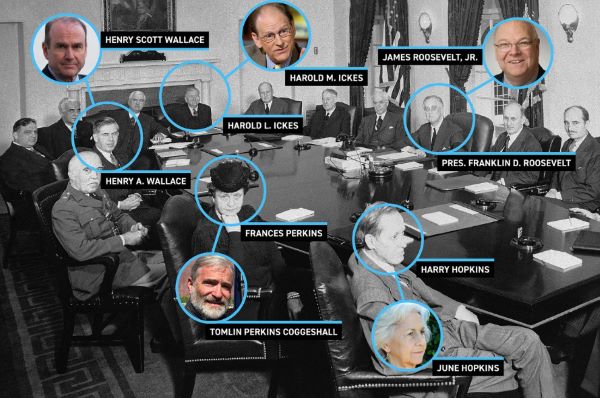
One recent Wednesday evening, a small of group of concerned citizens gathered on a Zoom call to talk about how to get the attention of the president.
At 6 p.m., two rows of elderly faces appeared on screen, staring into the camera: June Hopkins, Henry Scott Wallace, Tomlin Perkins Coggeshall and James Roosevelt Jr. If their names sound vaguely familiar it’s because their relatives—Harry Hopkins, Henry Wallace, Frances Perkins and Franklin Delano Roosevelt—formed the nucleus of one of the most famous and influential Oval Office rosters in American history. Ninety years later, these descendants of the FDR administration have reconstituted his Cabinet. And they have played their roles with a conscientious sense of purpose. This is a meeting, not happy hour. No one drinks, and they begin on time.
“It looks like Harold is having connection issues,” said Stephen Seufert, a volunteer staffer for the group. When he finally turned up, Ickes was in the woods, on vacation someplace remote. The internet was giving him trouble, and he couldn’t get into the Zoom. Seufert tried to troubleshoot the problem from afar, but after a few minutes, they let him be. Ickes is 81 and, as the son of Roosevelt’s interior secretary, is the closest to the actual FDR Cabinet.
“He’s not the most frequent attendant,” said Wallace.
Seufert, one of several self-identified “non-descendants” assisting the group, chimed in helpfully: “If we had better infrastructure, maybe Harold would be here right now.”
In a city of interest groups, “the descendants,” as they refer to themselves in frequent press releases and op-eds, are among the more unusual. They are determined to polish the legacy of America’s 32nd president by pushing the 46th to embrace a legislative agenda as transformational as the New Deal. They want Joe Biden to embrace the idea of an “activist” government. They want him to eliminate the filibuster. They spend hours parsing his words for echoes of the stirring language that helped defeat the Great Depression. And they devote their Wednesday night Zoom meetings, where they have met nearly every week since last June, to plotting ways to keep the comparisons to FDR alive, as if repetition might somehow will Biden’s latent progressivism to life.
READ ENTIRE ARTICLE AT POLITICO
‘Proud Raven, Panting Wolf’ — A History of Totem Poles in Alaska
A New Deal program to restore Totem Poles in Alaska provided jobs and boosted tourism, but it ignored their history and significance within Native culture.
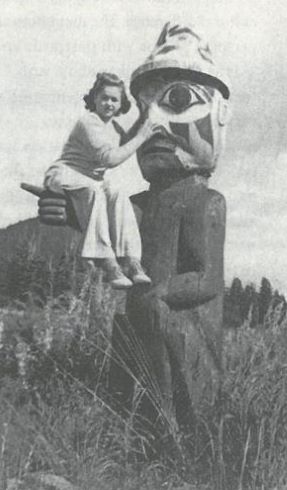
Have you ever gone past a Totem Pole and thought: silly, weird, even Disneyland-esque? True, the black, red, and blue-green coloration against the tall brown cedar post is iconic, along with creatures popping eyes, bird-like figures staring, and stacked out-of-proportion humans, all puzzling viewers.
Emily Moore’s book ‘Proud Raven, Panting Wolf’ explains why Totems are still up and thriving as tourist attractions, and how Tlingit/Haida historical/cultural heritage works that might have been overlooked if they had not been rounded up and placed into parks.
In Southeast Alaska, between 1938-1942, the Forest Service and the Civilian Conservation Corp (CCC) under Roosevelt’s New Deal restored and replicated Totems which were then planted in European style parks, as a way to employ those in the Pacific Northwest in need of jobs, boost tourism, all with little regard for any cultural significance. And like many government programs, what was cooked up in Washington was idealistic, but would evolve quite differently when put into actual operation in situ. Ironically, the project propelled Totems into the 21st Century as an art form.
Totem Poles are oral histories, sign posts of individual clans (Tlingit and Haida) found in Alaska’s panhandle (and in Canada). Moore explains these structures as, “mortuary and memorial poles for the dead, heraldic poles that recall stories of clan history or the origins of world phenomena, house frontal and interior posts that identify the house’s resident clan, and ridicule poles to shame another clan or person for an unresolved offense.
READ ENTIRE ARTICLE AT ANCHORAGE PRESS
How Puerto Rico Recovered Before
The island’s New Deal history offers an alternative to disaster capitalism.

In the aftermath of the Great Depression, Puerto Rico was rebuilding in more ways than one. Aside from dealing with the impacts of a global financial crisis, the island had recently been battered by two massive storms: San Felipe II in 1928 and San Ciprian in 1932. The latter killed at least 257 people and destroyed more than 40,000 buildings. The former killed more people than Hurricane Katrina, and is still considered the second deadliest natural disaster in U.S. history, claiming the lives of up to 3,000 people in Florida and an estimated 300 people in Puerto Rico — and leaving as many as 500,000 Puerto Rican residents homeless. Puerto Rico’s agricultural economy — one of the island’s major sources of income — was decimated. In between the two storms was another: Black Tuesday.
As the continental United States would find when the depression set in, relief programs then consisted of a loose patchwork of private charities, faith-based aid and philanthropy. That patchwork was looser still in Puerto Rico. The corrective to that lack of infrastructure — the New Deal — was created by the Roosevelt Administration amid massive popular pressure, and the very real threat of a revolution. Lesser known is the fact that the program extended to Puerto Rico, also in response to pressure from the Left, and revolutionized everything from highways to education to public health.
As Puerto Ricans begin to rebuild in the wreckage of Hurricane Maria, the commonwealth’s experience with the New Deal offers an alternative path to the one likely to be put forward by the private interests currently swarming the island to build nests in the debris.
First, some background. Puerto Rico has been a territory of the United States since 1898 and a commonwealth since 1952, although many argue the relationship is more colonial than cooperative. Responding to the island’s persistent financial troubles, the United States placed Puerto Rico under the stewardship of a fiscal oversight board via the Puerto Rico Oversight, Management, and Economic Stability Act (PROMESA), passed into law by Congress last summer. Only one of the board’s seven members is required to maintain permanent residence in Puerto Rico, and its authority trumps that of both the island’s legislature and governor. The board has broad authority to break union contracts and sell off public assets, all in the name of getting Puerto Rico’s fiscal house in order. That body serves, too, as a kind of mediator between the people, the government of Puerto Rico and the largely U.S. investors — hedge and mutual funds and individuals — who hold the majority of Puerto Rico’s debt, thanks to a series of anachronistic tax cuts which incentivized bond buying even after those bonds’ ratings had been degraded to junk status. Essentially, the fiscal oversight board is pushing a slightly less drastic form of austerity than what bondholders are calling for: repayment as soon as possible, no matter the cost.
READ ENTIRE ARTICLE AT IN THESE TIMES
Race and Inequality
Jitterbugging with Jim Crow
Ninety years ago, young African Americans in the South took up the Lindy Hop. It was an act of resistance and an assertion of freedom.
In Atlanta’s historic Vine City neighborhood, hidden among the trees overgrowing the lot at the corner of Sunset and Magnolia, is a barren concrete slab. On this spot, in the heart of an early-1930s African American community, Atlanta was first introduced to what would become “America’s National Dance”: the Lindy Hop.
Teenagers from all over the Westside would flock to the Sunset Casino and Amusement Park. The cavernous pavilion, which had been converted to a dance hall, featured a rotating cast of local talent along with the best swing bands in the world — Duke Ellington, Count Basie, Ella Fitzgerald. The Sunset also held Saturday afternoon dances and weekly Jitterbug contests. At the Sunset, for just 25 cents, the city’s black youth could briefly escape the ravages of the Depression and Jim Crow and dance their cares away.
I had hesitated to visit the site where the Sunset Casino once stood. I had learned about the Sunset from books. I had dug up, in the archives of the Atlanta Daily World, colorful descriptions of the dances there. I had found old advertisements for performances featuring long-dead artists I have come to love.
But I don’t have any kind of connection to the people in these stories — or really to this place at all. I’m a recent transplant to Atlanta and to the South. I am white. My entry point was through the dance itself, an art form that I, like many others, had come to love — but only later sought to understand.
As I stood there, I tried to picture the old streetcar stop, where trolleys full of students would step off and line up at the entrance to the dance hall. I imagined the sound of boys playing basketball, the smell of popcorn in the air, and the delighted laughter of children riding a carousel. I tried to conjure the feeling of a crisp fall night in 1937, carnival lights twinkling all around, walking into the Sunset. I imagined that moment when the scorching sounds of a blaring trumpet filled the packed dance hall, when the drummer broke loose in a percussive flurry, and when the Duke himself started pounding the ivories.
The crowd must have gone wild.
And I imagined the Lindy Hoppers. I saw them in my mind, showing off the acrobatic moves they had been practicing on the street or to records in their living room. I imagined them complaining about the heat inside the hall, using handkerchiefs to wipe away sweat. I imagined them swinging out hard, experiencing the same exhilarating feeling of pure joy and connection that I feel on the dance floor today. And I pictured the smiles on their faces, every one of them black.
READ ENTIRE ARTICLE AT THE BITTER SOUTHERNER
Not White But Not (Entirely) Black
On the complex history of “passing” in America.
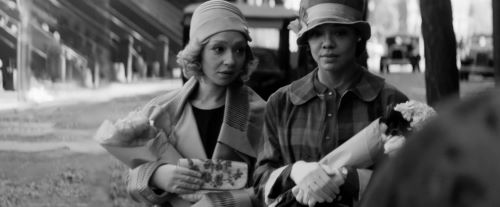
“It’s funny about ‘passing.’ We disapprove of it and at the same time condone it. It excites our contempt and yet we rather admire it. We shy away from it with an odd kind of revulsion, but we protect it.”
Nella Larsen, Passing
I started with a group of boxes that looked like the oldest ones in the attic. The packing tape easily lifted away, no longer sticking to the cardboard, and wine glasses and dishes emerged from pages of the Washington Post from the 1970s. Several heavy boxes contained papers and photographs belonging to my grandparents, but there was one surprisingly light box. I opened it to find a collection of hand-sewn dolls and animal puppets, just a dozen or so of the thousands I knew my grandmother had made when she was a volunteer at Children’s Hospital over the years.
Among the clowns, frogs, and bunnies was one doll that had clearly been sewn with greater care and detail than the others. I recognized it as Grandma’s work, but it had a design I’d never seen before. It was a girl with light pink skin, blue eyes, and blond hair, wearing a long floral dress with a lace collar and a pink bow. I flipped it over to reveal another girl, this one with very dark brown skin, black hair, and brown eyes.
The two figures were joined at the torso, and the exaggerated contrast between their features gave the second doll a blackface quality. I remembered that toys like these were called Topsy-Turvy dolls and vaguely associated them with offensive Jim Crow cartoons and minstrel shows. Why would my grandmother, a Black woman, make such a thing? Grandma had died more than twenty years before, and, holding this strange doll in my hands, I had the sense that this was her last word on race.
A little research reveals that Topsy-Turvy dolls originated during the time of slavery. No one can ascribe a single meaning or purpose to them, but their dual identity suggests a connection to the mixed-race children who were a part of the plantation world. These children were enslaved people who could be bought or sold by law. They were also relatives of their owners: cousins, half-siblings, sons, and daughters. These relationships were usually denied, but they were often open secrets.
READ ENTIRE ARTICLE AT LITERARY HUB
How Academia Laid the Groundwork for Redlining
The connections between private industry and government were much more fluid than was previously imagined.
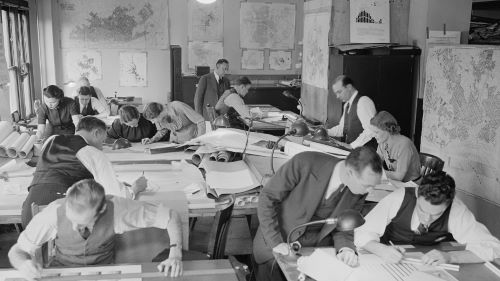
Changing the field of economics once was not enough for Richard T. Ely. Early in his career, in 1885, Ely had transformed his discipline by helping to found the American Economic Association. In 1920, at the age of 66, Ely still had ambition. That year, he established a research institute on land economics at the University of Wisconsin, aspiring not only to create a new disciplinary subfield, but also to transform the practice of real estate development and brokerage nationwide. Five years later, with financial backing from electricity magnates Samuel Insull and Martin Insull, Ely moved his Institute for Research in Land Economics and Public Utilities to Northwestern University, determined to enact his ambitious vision.
Ely was uniquely positioned to do this work. He had trained dozens of leading economists and social scientists at Johns Hopkins and Wisconsin, among them historian Frederick Jackson Turner and future president Woodrow Wilson. Confident of his intellectual impact, Ely boasted to a friend in 1923 that his theorizations regarding land values “would be felt a hundred years from now.” Nearly a century later, as Ely predicted, we can clearly see in his work the theoretical and organizational roots of redlining: the hugely destructive practice of denying home mortgages on the basis of race (among other presumed risk factors).
Decades before the Great Migration of African Americans from the rural South would transform American cities—with accompanying conflagrations like the 1919 Chicago Race Riot—Ely and likeminded Progressives had helped cement the intellectual tyranny of eugenics and scientific racism. Now, amid shifting demographics and a frenzy of metropolitan development in the 1920s, Ely and his colleagues sought to enforce an urban racial order. In a new research article that we discuss here, we show how they strategically positioned themselves to make policy proposals that would dramatically restructure real estate and home finance in the Great Depression decade that followed, and beyond.
READ ENTIRE ARTICLE AT PLATFORM
How Air Pollution Across America Reflects Racist Policy From the 1930s
A new study shows how redlining, a Depression-era housing policy, contributed to inequalities that persist decades later in U.S. cities.

Urban neighborhoods that were redlined by federal officials in the 1930s tended to have higher levels of harmful air pollution eight decades later, a new study has found, adding to a body of evidence that reveals how racist policies in the past have contributed to inequalities across the United States today.
In the wake of the Great Depression, when the federal government graded neighborhoods in hundreds of cities for real estate investment, Black and immigrant areas were typically outlined in red on maps to denote risky places to lend. Racial discrimination in housing was outlawed in 1968. But the redlining maps entrenched discriminatory practices whose effects reverberate nearly a century later.
To this day, historically redlined neighborhoods are more likely to have high populations of Black, Latino and Asian residents than areas that were favorably assessed at the time.
READ ENTIRE ARTICLE AT THE NEW YORK TIMES
The Shame of the Suburbs
How America gave up on housing equality.
The growth of the suburbs, too, is often seen as natural. In the American catechism, it’s a result of the desire to escape the teeming city, to own your own property, to express your individual style in the design of your house and the upkeep of your yard. The wealthy classes were drawn throughout the 1800s to bucolic settings outside the city, in places like New York’s Westchester, and to “streetcar suburbs” like Brookline, near Boston. The ideal was, as the historian and urban planner Lewis Mumford acidly described it, “to be your own unique self; to build your unique house . . . in short, to withdraw like a monk and live like a prince—this was the purpose of the original creators of the suburb.”
The first half of Crabgrass Frontier tells this story. Jackson expands on the idea that “housing is an outward expression of the inner human nature.” He traces the effects of writers and moralists in the mid-1800s who created a “cult of domesticity” as they touted the virtuous benefits of family life in a detached home, with more privacy and isolation than city life allowed. As one preacher told an audience of young women in 1853, “The foundation of our free institutions is our love, as a people, for our homes.”
But more than culture, it was new technologies and municipal initiatives that made suburbanization happen. After the Civil War, the streetcar trolley and commuter rail lines extended the distances workers could reside away from city centers. As cities took control of street development, the city’s residents were subsidizing those who moved to the edges. Municipal governments would then annex the growing areas—as New York did with Brooklyn and the other boroughs. After that came the automobile, and the expansion of highways. By 1950, General Motors had helped eliminate a hundred streetcar operations around the country, replacing them with GM buses. (A federal grand jury found GM had participated in a criminal conspiracy. The fine was $5,000.) Everywhere, there were more and more cars—and roads that were called freeways. “The city is doomed,” Henry Ford had said. “We shall solve the city problem by leaving the city.”
The fact that the United States had become the world’s first predominantly suburban nation would hardly have been shocking to readers of the 1980s—by which time more people lived in suburbs than in cities or on farms. Still, Jackson’s book was important for providing a meticulous history of how it happened. Academic reviewers praised Crabgrass Frontier as “the work of a great mind and a great scholar” and “the definitive work” on the suburb’s long evolution. It was hailed as “essential reading for urban geographers.” But it is of lasting importance for another reason. As Ta-Nehisi Coates wrote in 2014, “about halfway through the book, the bombshells start dropping.” Jackson works his way to the moment the federal government became a driving influence on where people settled—on who would be able to buy that new house with a yard and a garage, and who would be trapped in an urban ghetto. It wasn’t just that people went to the suburbs to find a better life, it was that white people did, enabled by an array of helpful government policies. African Americans and other minorities were not uninterested in obtaining homes and mortgages; the government actively blocked them from doing so.
READ ENTIRE ARTICLE AT THE BAFFLER
Mapping Inequality: Redlining in New Deal America
In the 1930s, the federal government created redlining maps for almost every major U.S. city. Explore those maps and their contexts in a brand new version of this project.

Redlining was the practice of categorically denying access to mortgages not just to individuals but to whole neighborhoods.
Between 1935 and 1940, an agency of the federal government, the Home Owners’ Loan Corporation, graded the “residential security” of thousands of American neighborhoods. By “security,” they meant the relative security or riskiness of those areas for banks, saving and loans, and other lenders who made mortgages.
For each of these cities, they produced maps showing those grades. Neighborhoods they deemed “best” and safe investments were given a grade of A and colored green. Those that were deemed “hazardous” were given a grade of “D” and colored red.
In most cases they also generated an “area description” for each of these neighborhoods providing descriptions of the houses, the sales and rental history, and of the residents.
If those residents were African Americans or, to a lesser extent, immigrants or Jews, HOLC deemed them a threat to the stability of home values and described their presence as an “infiltration.”
Redlining was legal and practiced for decades. It dramatically affected the relative wealth—as well as the health—of different racial groups in America. Its impact is still with us today.
READ ENTIRE ARTICLE AT AMERICAN PANORAMA
Ada Wright, The Scottsboro Defense Campaign, and the Popular Front
The Scottsboro Case quickly became one of the most infamous international spectacles that would eventually define the interwar period.
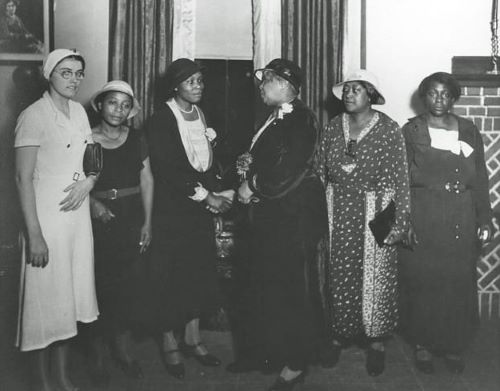
In the midst of the Great Depression in 1931, nine Black teenage boys were falsely convicted of allegedly raping two white women on a train in Scottsboro, Alabama. The Scottsboro Case quickly became one of the most infamous international spectacles that would eventually define the interwar period. The Scottsboro defense campaign, led by the Communist Party of the United States (CPUSA) and the International Labor Defense (ILD), emphasized that the defendants’ case should be understood in the larger context of international workers’ struggles occurring throughout the imperial world. The Party’s campaign relied on several strategies to gain international significance, however, its decision to recruit Ada Wright—the mother of Scottsboro defendants, Andy and Roy Wright— to embark on a European speaking tour, was perhaps one of the most significant strategies it utilized.
Wright’s experiences on this tour point to the evolving international landscape that characterize the interwar period. Wright’s lived experience as a Black Southern domestic worker and mother informed her unique perspective of the international labor struggle that persisted during the Great Depression. Her analyses of Black workers’ and mothers’ struggles throughout the Jim Crow South made a considerable impression on British anti-imperial activists and workers alike. Her speeches not only galvanized European workers, but also empowered Black working class women and mothers in the United States to join the communist struggle for workers’ rights, women’s rights, and Black liberation. Her tour ultimately contributed to the formation of an interracial anti-imperialist Popular Front that circulated throughout Britain. When Wright initially embarked upon her European tour in 1933, scholar Susan Pennybacker explains that “London sat uncomfortably poised between Jim Crow and the Third Reich.” The Scottsboro case seemed to be the bridge between the condemnation of the growing fascist movement in Germany and the racialized organization of labor throughout the British Empire.
Ada Wright was in her mid-30s when the ILD asked her to participate in the European speaking tour. In March 1932, the courts confirmed the guilty verdicts and set the defendants’ execution date for May 13th. In response, the ILD commissioned Wright’s European speaking tour, hoping that she could help galvanize more international support for the case. London based West Indian communist Arnold Ward, a colleague and friend of George Padmore wrote to Padmore upon Wright’s arrival in Britain, stating that “Since Mrs. Wright has been here the International Solidarity has taken on a deeper and greater hold on the workers. Here more than I have ever seen before and I think it is for the best.” In sharing her lived realities under Jim Crow, she gave many working class women language with which to protest their own oppression.
At the time, Wright had never traveled outside of the South. She was a mother of three, a widow, and a domestic worker from rural Chattanooga, Tennessee. When the CPUSA initially gained control of the case, Wright was not familiar with the COMINTERN agenda. As a Black domestic worker living under Jim Crow segregation, however, Wright was all too familiar with the exploitation that Black workers faced regularly. She spoke on the evils of racism in the United States and the necessity of mobilizing “the masses against the imperialist war.” She understood the Scottsboro case as a “struggle against the imperialist war, because the Scottsboro persecution grows out of the war preparations of the American boss class.” This profound analysis of racial capitalism inspired audiences of European workers to connect their exploitation to that of colonized workers revolting against their working conditions throughout the British empire.
READ ENTIRE ARTICLE AT BLACK PERSPECTIVES
The Racial Segregation of American Cities Was Anything but Accidental
A housing policy expert explains how federal government policies created the suburbs and the inner city.

It’s not surprising to anyone who has lived in or visited a major American metropolitan region that the nation’s cities tend to be organized in their own particular racial pattern. In Chicago, it’s a north/south divide. In Austin, it’s west/east. In some cities, it’s a division based around infrastructure, as with Detroit’s 8 Mile Road. In other cities, nature—such as Washington, D.C.’s Anacostia River—is the barrier. Sometimes these divisions are man-made, sometimes natural, but none are coincidental.
A narrative of racially discriminatory landlords and bankers—all independent actors—has long served as an explanation for the isolation of African-Americans in certain neighborhoods in large cities. But this pervasive assumption rationalizing residential segregation in the United States ignores the long history of federal, state and local policies that generated the residential segregation found across the country today.
In The Color of Law: A Forgotten History of How Our Government Segregated America, Richard Rothstein, a research associate at the Economic Policy Institute, aims to flip the assumption that the state of racial organization in American cities is simply a result of individual prejudices. He untangles a century’s worth of policies that built the segregated American city of today. From the first segregated public housing projects of President Franklin Roosevelt’s New Deal, to the 1949 Housing Act that encouraged white movement to the suburbs, to unconstitutional racial zoning ordinances enacted by city governments, Rothstein substantiates the argument that the current state of the American city is the direct result of unconstitutional, state-sanctioned racial discrimination.
Smithsonian.com spoke with Rothstein about his findings and his suggestions for change.
READ ENTIRE ARTICLE AT SMITHSONIAN MAGAZINE
2021 Could Finally Be the Moment for the Equal Rights Amendment
The turmoil of the coronavirus pandemic could push the amendment across the finish line after a century of work.
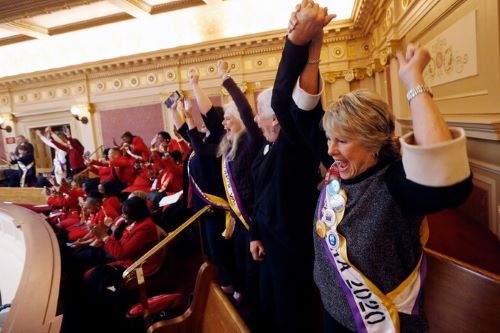
The Biden administration’s proclamation for Women’s History Month underscored the undue social and economic struggles that still disadvantage women in the United States. Women continue to suffer from significant gender disparities in wages and carry the burdens caused by unequal caregiving duties and family responsibilities. The coronavirus pandemic has only exacerbated these inequities, especially for Black and Hispanic women. Food insecurity and domestic violence reports have increased considerably during the pandemic, primarily in households with children where women are the primary earners.
These hardships have left supporters of the Equal Rights Amendment (ERA) wondering whether the turbulence of the pandemic has primed the political and social climate in a way that will allow them to finally push the amendment forward and ensure that it is fully incorporated into the U.S. Constitution. And they may be right.
The long history of the ERA, which dates to the 1920s, shows us that when events disrupt the traditional societal order, they produce a cultural opening for newfound appreciation for the gender equality that undergirds the ERA. Almost a century ago, the economic turmoil of the Great Depression and the political upheaval of World War II helped ERA activists create considerable momentum behind the amendment. By the end of World War II, the ranks of amendment backers had grown to include Democrats and Republicans, working-class and upper-class Americans, as well as White and Black Americans. And this is the history that should make the amendment’s supporters hopeful today.
READ ENTIRE ARTICLE AT THE WASHINGTON POST
How ‘Communism’ Brought Racial Equality to the South
The Communist Party fought for racial equality in the South, specifically Alabama, where segregation was most oppressive.
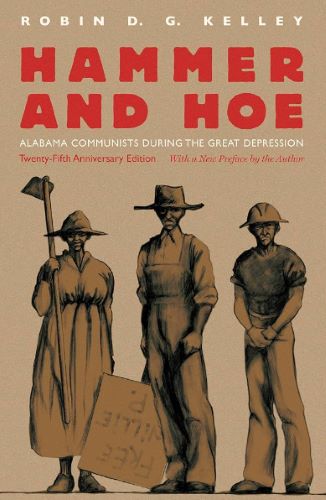
MICHEL MARTIN, host:
Im Michel Martin, and this is TELL ME MORE from NPR News.
Coming up, whats going on in your house? But it doesnt look like the set of Leave It to Beaver. Writer Rebecca Walker wanted to capture the many new faces of the American family. Well talk about her provocative collection of essays in a few minutes.
But first, we continue our Black History Month series of conversations. Throughout this Black History Month, we have been focusing on new news about black history, new scholarship that has emerged in recent decades that sheds new light on the story of black people in America.
Today, we want to hear about communists in the civil rights movement. Now, thats a sensitive subject since those working for equality have often been accused of being communist in this country, but some were.
And were joined now by Robin Kelley, author of Hammer and Hoe: Alabama Communists During the Great Depression. It documents how the Communist Party worked to secure racial, economic and political justice. Hes a professor of American studies and history at the University of Southern California. And this semester, hes the Harmsworth Professor of American History at the University of Oxford. And we welcome you to the program. Thank you for joining us.
Professor ROBIN KELLEY (American History, University of Oxford; Author, Hammer and Hoe: Alabama Communists During the Great Depression): Thanks, Michel. Its great to be here.
MARTIN: How did you get interested in this topic? And as I mentioned, it is a sensitive topic because there are those, for decades, whove worked to tamp down the suggestion that anybody in the civil rights movement was attracted to the Communist Party at all.
Prof. KELLEY: Exactly. And this is a story that actually predates the civil rights movement as we know it, going back to the 1930s. I became interested in this as a doctorate dissertation back in the mid-80s when I was very active in other social movements in actually in the L.A. area. And I wanted to know how the Communist Party organized African-Americans, particularly in places where black people were the majority.
And so, at first, my study took me to South Africa. And I was planning to do a comparative study looking at South Africa and the West South. I couldnt get into South Africa in 1986 because of the state of emergency. And so, I discovered the second blackest place in the world and that is Alabama. And there, I discovered a very vibrant movement that very few people wrote about, there basically are two stories. One memoir by a man named Hosea Hudson and then another story in a book called All Gods Dangers which is about an African-American sharecropper.
MARTIN: All Gods Dangers: The Life of Nate Shaw, I remember that.
Prof. KELLEY: Exactly. But his real name was Ned Cobb. Nate Shaw was a pseudonym. And its a beautiful book that tells his life story and only a portion of it deals with his membership in the communist-led sharecroppers union, which at one point had about 12,000 members in the black belt counties of Alabama.
MARTIN: And were all the members black?
Prof. KELLEY: Well, in Alabama, there was a point when basically all the members, except one, were all African-American sharecroppers and tenant farmers.
MARTIN: How did the Communist Party gets started in Alabama?
Prof. KELLEY: In 1928, the communist position internationally was that African-Americans in the South have the right to self-determination. Meaning: they have the right to create their own nation in the South. In this position that came out of Moscow, it came from other black communists around the globe.
And with that idea in mind, they sent two organizers to Alabama and they went to Birmingham. And they chose Birmingham because it was probably the most industrialized city in the South. And they went there thinking they would organize white workers. And from white workers, black workers would follow. But no white workers had come forward.
And so, the first two organizers was a guy named James Julio(ph), who was a Sicilian worker who had migrated to Alabama, and another guy named Tom Johnson(ph), and together they went out looking for white workers and black workers came.
And black workers came in fairly large numbers right away because to them, they had a memory of reconstruction, the memory of the Civil War. And in that kind of collective memory, they were told that one day the Yankees will come back and finish the fight. Well, when they saw these white communists, they said, oh, good, the Yankees are here. We cant wait to join.
The Painful History of a Confederate Monument Tells Itself
Haunting archival footage of Stone Mountain’s creation.
The stated goal of the white nationalist rally in Charlottesville this year was to oppose the removal of a statue of Robert E. Lee. In the wake of the events that erupted, filmmaker Sierra Pettengill closely followed the debate surrounding the legacy of Confederate monuments. “I was struck by the way the word ‘history’ was blankly lobbed as a defense of the monuments,” Pettengill told The Atlantic. “Take Trump’s reaction, for one: ‘They’re trying to take away our history.’ My instinct was, ‘Okay, then: Let’s look at the history.’”
The history of a single monument is writ large in Pettengill’s new short film, Graven Image, produced by Field of Vision and premiering on The Atlantic today. The documentary relies solely on archival record to tell the story of Georgia’s Stone Mountain monument, which depicts Stonewall Jackson, Robert E. Lee, and Jefferson Davis engraved in the mountain face. Originally conceived of by the United Daughters of the Confederacy in 1912, Stone Mountain was chosen as the site of the rebirth of the KKK in 1915. Although it was shelved during the Great Depression, it was later revitalized in the wake of the seminal Brown vs. Board of Education desegregation case, and finally completed in 1970. In 2001, Georgia state law passed a mandate that the monument never be removed or altered.
With Graven Image, Pettengill hopes to recontextualize the Confederate monument and examine the way American narratives are told—and often warped—through time.
“Stone Mountain allows for a full century’s worth of reckoning with the motivations and politics behind these celebrations of the Confederacy and the Lost Cause narrative,” Pettengill said. “Inmy film, a voiceover from a 1972 Stone Mountain promotional film says, ‘Remember how it used to be? It’s still that way for you to enjoy at Stone Mountain Park.’ I want this film to make us remember how it actuallyused to be.”
READ ENTIRE ARTICLE AT THE ATLANTIC
When Lyndon B. Johnson Chose the Middle Ground on Civil Rights—and Disappointed Everyone
Always a dealmaker, then-senator LBJ negotiated with segregationists to pass a bill that cautiously advanced racial equality.
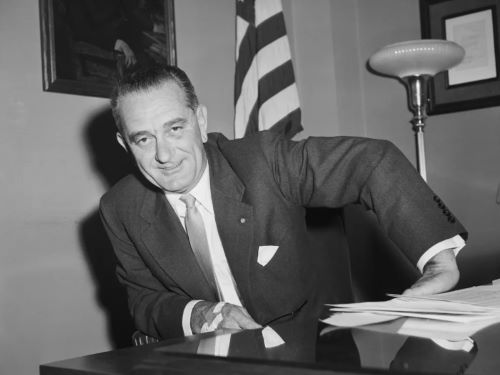
On August 7, 1957, Senate Majority Leader Lyndon B. Johnson voted yea on the first civil rights bill passed by Congress in 82 years. He was joined by 71 of his Senate colleagues, including 43 Republicans and 28 Democrats, 4 of them liberals from the South like Johnson himself. One month later, on September 9, President Dwight D. Eisenhower signed the Civil Rights Act of 1957 into law.
As majority leader, Johnson arguablydid more than anyone else to ensure the passage of a civil rights act in 1957. He cajoled skittish progressives, most of them Northerners, into compromising with the Democratic Party’s powerful Southern voting bloc. Then, over bourbon and cigars, he convinced the Old Guard Democratic Southerners that they ought to give a bit on civil rights while one of their own was in charge, as legislative action on race relations could not be postponed indefinitely.
Limited in its scope and effectiveness, particularly when compared with legislation passed in the 1960s, the 1957 bill walked a treacherous tightrope that “was going to disappoint both the opponents of civil rights and the proponents of civil rights,” says Bruce Schulman, a historian at Boston University. The future president’s efforts were “totally based in the calculation of what was achievable” rather than ideal.
READ ENTIRE ARTICLE AT SMITHSONIAN MAGAZINE
Social Safety Net
This Amazing Woman is the Forgotten Architect of the American Social Security System
You can thank her for your retirement benefits.
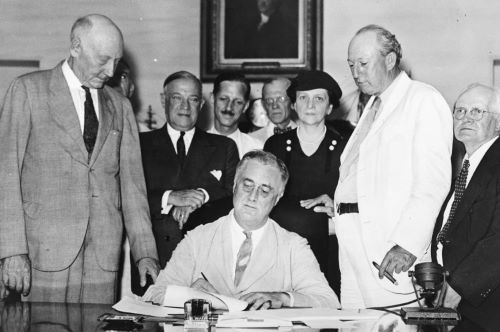
In the throes of the Great Depression, Armstrong put forth progressive hypotheses about the obligations of industrialized nations to the economic well-being of their citizens. This drew the attention of FDR, who in 1934 invited Armstrong to work as Chief of Staff for Social Security Planning, on the Committee on Economic Security (CES). Suddenly, she moved from advocating radical reform to writing actual legislation.
Prior to Roosevelt, U.S. presidents were expected to steer clear of Wall Street interests. President Herbert Hoover had formed a conservative belief in small government that would define his approach to Depression Era economics, which offered no immediate or major federal intervention. Instead, he called upon states to regulate minimum wage and private charities to help solve the nation’s poverty.
Meanwhile, conditions around the country worsened. By 1931, the unemployment rate hit 15.8 percent. Homeless families scavenged in makeshift shantytowns (sardonically known as Hoovervilles). Still, Hoover refused to involve the government by fixing prices or controlling currency, which he feared would lead to socialism. Instead, he emphasized aid through private volunteerism and charitable works. He asked employers not to cut wages. He suggested neighbors help each other. He believed the economy relied chiefly on morale, and that it would self-correct.
When it didn’t, the country elected FDR, who believed an aggressive federal intervention was needed. He surrounded himself with people like Armstrong, who had studied social insurance for years.
Armstrong was attuned to politics. According to Nancy Altman, author and president of Social Security Works, she was an “infighter” whose outspokenness convinced the CES to propose a federal program that addressed old age insurance. With the help of Labor Secretary Frances Perkins, the first woman appointed to the U.S. Cabinet, the Social Security Act of 1935 passed. “There were a lot of very strong women who surrounded Roosevelt at the time,” says Altman.
READ ENTIRE ARTICLE AT TIMELINE
Frances Perkins: Architect of the New Deal
She designed Social Security and public works programs that helped bring millions out of poverty. Her work has been largely forgotten.
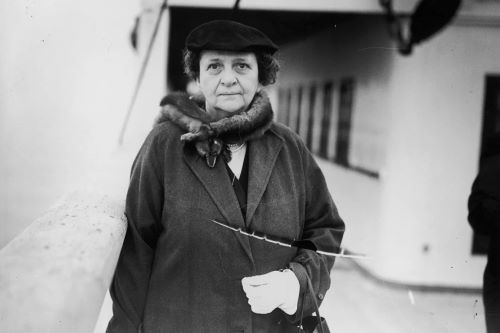
In the midst of the catastrophic crisis triggered by the coronavirus pandemic, more than 100 million Americans are accessing financial assistance and medical care. These vital services are available in part because of the efforts of a woman many have never heard of.
Frances Perkins was the first female presidential cabinet secretary and the central architect of the New Deal. She designed Social Security and public works programs that brought millions out of poverty. Her work resulted in the construction of hospitals, public schools, and related infrastructure. A social worker by training, Perkins also implemented workplace regulations that are standard to this day.
Despite these achievements, Perkins has been largely forgotten. The popular narrative of this tumultuous period has placed Franklin Delano Roosevelt at the center of the New Deal. Even now, in making a nostalgic appeal to the New Deal, Democratic presidential candidate Joe Biden has been portrayed in the media as a potential FDR, a framing also used with President Barack Obama.
Many leading female politicians have embraced Perkins: Senator Elizabeth Warren highlighted her accomplishments during a 2019 Washington Square Park speech; Hillary and Chelsea Clinton included her in The Book of Gutsy Women; and House Speaker Nancy Pelosi suggested Perkins’ likeness should grace the $10 bill.
READ ENTIRE ARTICLE AT JSTOR DAILY
The Republican Tax Bill Is a Poison Pill That Kills the New Deal
Today’s Republicans would have fit right into Herbert Hoover’s administration.
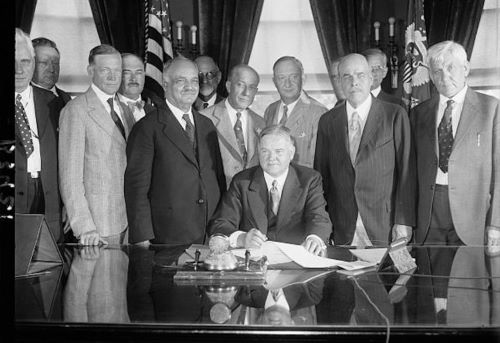
Shortly after President Trump took office, House Speaker Paul Ryan could feel just how close he was to finally achieving the goal he and his party colleagues had dreamed about for decades. With Republicans in uncontested power in Washington, he tweeted, they had a “once-in-a-lifetime opportunity to enact real comprehensive tax reform and get our economy moving.” Many Trump supporters thought reform meant relief for the “forgotten Americans” he talked about on the campaign trail. But Republicans had other plans, intending to take a wrecking ball to the system of American government that has been in place since 1933 and replace it with one based in their own ideology. If the “Tax Cuts and Jobs Act” becomes law, they will have succeeded.
It is hard to overstate the significance of this bill. It is a poison pill, killing the New Deal. The series of laws put in place by Franklin Delano Roosevelt and a Democratic Congress in the 1930s regulated business so employers could no longer abuse their workers or destroy the environment. It provided basic social welfare to support the elderly and infirm, and it developed infrastructure to guarantee everyone equal access to economic opportunity. Crucially, Democrats based their system on a distinctive ideology: The government must keep the economic playing field level for all Americans. As people at the bottom prospered, they would fuel economic growth for everyone.
This was indeed a “new deal for the American people,” as FDR put it. When he named it in 1932, government policy was based on the opposite ideology. Republicans who controlled the government in the 1920s insisted that national prosperity depended on government protection of the rich, who they believed would plow their capital back into the economy to provide jobs and higher wages for workers. When they took control of all branches of the federal government in 1921, they used their unchecked power to remake the government along the lines of their ideology. They slashed taxes and regulations and turned government over to businessmen, arguing that their policies would speed up the economy and bring the nation untold wealth.
In fact, the Republican policies did increase worker productivity by about 43 percent, but the profits went to business owners. So did the benefits of the tax cuts. By 1929, 5 percent of the population received one-third of the nation’s income. The structural weaknesses of this economy plunged the nation into the Great Depression. By the time FDR took office, 13 million people — 25 percent of the population — were out of work, the price of wheat had dropped from $1.05 to 39 cents a bushel, mothers went hungry so their children could eat, and people who had lost their homes lived in packing boxes in “Hoovervilles,” named after Herbert Hoover, the Republican president who oversaw the crash. Roosevelt’s call for a government responsive to the general welfare rather than the demands of the very wealthy won him the White House in a landslide, and the popularity of his New Deal committed the federal government to providing for the general welfare for the foreseeable future.
READ ENTIRE ARTICLE AT BILLMOYERS.COM
The Nation’s First Unemployment Check — $15 — and the Love Story that Led to It
During the Great Depression, the daughter of the first Jewish Supreme Court justice and the son of a prominent Christian theologian changed America.
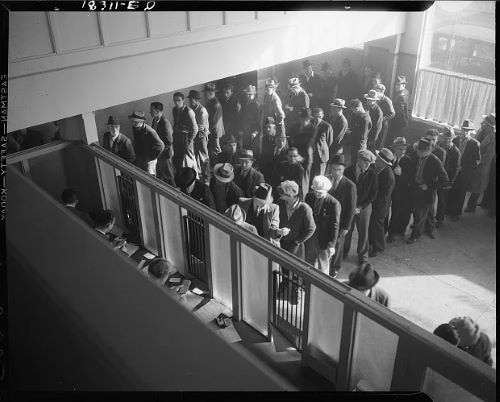
They first laid eyes on each other in torts class.
It was 1923, a period of prosperity before the Great Depression.
He was the son of Walter Rauschenbusch, a prominent theologian and key figure in the Social Gospel movement. She was the daughter of Louis Brandeis, the progressive Supreme Court justice and the most famous Jew in America. Each inherited their parents’ zeal for social justice.
At the University of Wisconsin Law School, these two idealists — Elizabeth Brandeis and Paul Raushenbush — noticed each other immediately. She was brainy and shy, her hair long and dark. He was handsome and outgoing. On hikes and canoe outings, they fell in love romantically and intellectually — a partnership instrumental in passing the nation’s first unemployment compensation law.
The story of how they did it is largelyforgotten, but the 22 million people who have applied for unemployment during the coronavirus pandemic — and, of course, the millions before them — have this unlikely couple to thank. The law they conceived of and helped pass in Wisconsin laid the foundation for unemployment insurance throughout the country.
READ ENTIRE ARTICLE AT THE WASHINGTON POST
Did Social Work Kill Civil Society?
A new book makes the case.
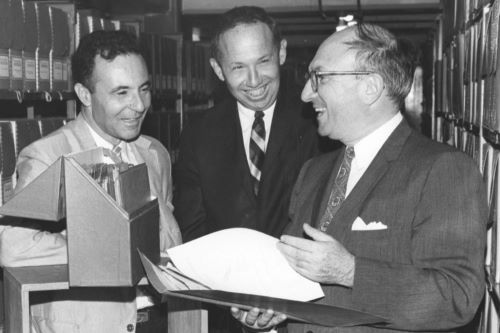
If civil society is dead — and evidence of its decay abounds, from the derelict exurban brownstones that were once home to orphanages and industrial schools to the ever-dwindling numbers of community organizations — Howard Husock’s question is one worth asking. In his new book Who Killed Civil Society? he explores the confluence of cultural, political, and economic developments that destroyed the “mediating institutions” that once imparted “middle-class values” to the poor and destitute.
It is a story told through anecdote, first through the eyes of Husock’s orphaned father, on whose behalf “a private organization called the Juvenile Aid Society, staffed in large part by volunteers, stepped in and provided a solid foundation for his life.” The Juvenile Aid Society “sought to shape his values — to inculcate the norms that are sometimes mocked as ‘bourgeois.’” These norms have been abandoned, in his eyes, to the great peril of the poor.
The book chronicles the evolution of social services from the late 19th century to the present, using emblematic figures — philanthropists, reformers, and ideologues — as vehicles to chart its development. This is Husock’s means of personalizing what is, in part, an impersonal plot: Whatever the role of individual social-service agents, it was the whirlwinds of legislative and cultural revolution that would destroy value formation and civil society in turn.
Husock presents Charles Loring Brace, a 19th-century philanthropist, as a model of voluntary charity’s best features. Brace created a series of programs under the Children’s Aid Society umbrella that, by 1890, included “twenty-one industrial schools, thirteen night schools for general education, four summer camps, a typing school, a print shop, and three reading rooms.” While Brace received small contributions from local governments, he was almost exclusively funded by donors who embraced his mission to the poor, which included promoting bourgeois norms: “The principal value of our Enterprise,” Brace wrote, “is that our influence is moral and in no respect coercive . . . [aspiring philanthropists will] soon see how superficial and comparatively useless all assistance or organization is which does not touch the habits of life and the inner forces which form character.” Brace’s imposition of norms on impoverished children and insistence upon thrift and virtue might, to the modern ear, sound like “moralizing.” To Husock, if propagating bourgeois norms counts as “moralizing,” then our institutions ought “not shrink from just such moralizing because . . . it can actually empower people.”
READ ENTIRE ARTICLE AT NATIONAL REVIEW
The Left is Pushing Democrats to Embrace Their Greatest President. It’s a Good Thing.
Democrats should proudly trumpet the New Deal — and extend it.
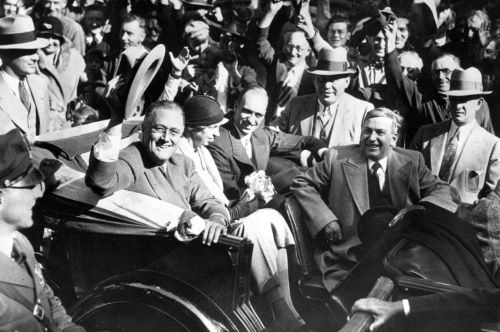
The New Deal is back.
Nearly a century after President Franklin D. Roosevelt began his effort to revive the American economy through government programs, Democrats are once again becoming fans of Roosevelt and his legacy. That should come as no surprise: The nation’s longest-serving leader, Roosevelt presided over the New Deal and waged the successful World War II fight against global fascism. His New Deal laid the groundwork for the economic boom that made the United States the envy of the world in the postwar decades, and it provided the impetus for the civil rights and Great Society reforms of the 1960s. Roosevelt helped forge a coalition that made the Democratic Party dominant for almost half a century and left a lasting legacy, including programs that remain strikingly popular today, such as Social Security.
Yet for the past half a century, leading Democrats have let Republicans dictate the terms of our politics, expressing surprising reluctance to celebrate Roosevelt or the New Deal.
Recently, however, both have returned to American politics with a vengeance. Newly elected Democratic Rep. Alexandria Ocasio-Cortez (N.Y.) and dozens of other representatives have proposed a “Green New Deal.” Calling for a return to the progressive system introduced during the New Deal and World War II years, Ocasio-Cortez is also promoting a 70 percent marginal tax rate for the highest earners, a proposal other members of her party and some liberal commentators have endorsed. The call for what Sen. Elizabeth Warren (Mass.) describes as a “Second New Deal” marks the reversal of decades of Democrats distancing themselves from Roosevelt and, if this new trend continues, promises to reinvigorate the party and its agenda.
The “New Deal order” lasted roughly from Roosevelt’s election in 1932 to Ronald Reagan’s ascendance in 1980. This era presents a paradox. On the one hand, many, including Donald Trump, look back on it as a golden age. Yet beginning in the 1970s, the forces that helped produce a broad middle class and relative income equality have been under assault — from both parties.
Conservatives had always been suspicious of the New Deal, with its corporate regulation, robust spending on public goods such as education and state support for an expanded labor movement. No surprises there. What changed is that as these programs came under critical scrutiny, many Democrats, rather than robustly defending Roosevelt’s legacy, piled on. In 1985, then-Sen. Al Gore described the “New Deal formula” not as a model to be emulated but as an out-of-date paradigm of overreliance on “centralized government solution[s]” to be avoided.
READ ENTIRE ARTICLE AT THE WASHINGTON POST
The Voluntarism Fantasy
Conservatives dream of returning to a world where private charity fulfilled all public needs. But that world never existed, and we’re better for it.
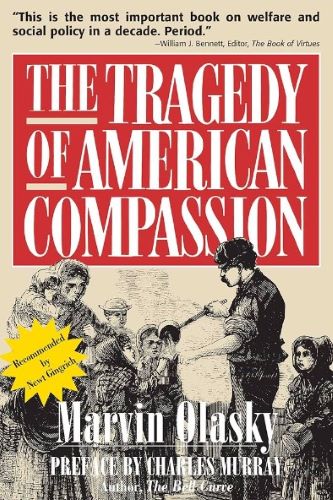
Ideology is as much about understanding the past as shaping the future. And conservatives tell themselves a story, a fairy tale really, about the past, about the way the world was and can be again under Republican policies. This story is about the way people were able to insure themselves against the risks inherent in modern life. Back before the Great Society, before the New Deal, and even before the Progressive Era, things were better. Before government took on the role of providing social insurance, individuals and private charity did everything needed to insure people against the hardships of life; given the chance, they could do it again.
This vision has always been implicit in the conservative ascendancy. It existed in the 1980s, when President Reagan announced, “The size of the federal budget is not an appropriate barometer of social conscience or charitable concern,” and called for voluntarism to fill in the yawning gaps in the social safety net. It was made explicit in the 1990s, notably through Marvin Olasky’s The Tragedy of American Compassion, a treatise hailed by the likes of Newt Gingrich and William Bennett, which argued that a purely private nineteenth-century system of charitable and voluntary organizations did a better job providing for the common good than the twentieth-century welfare state. This idea is also the basis of Paul Ryan’s budget, which seeks to devolve and shrink the federal government at a rapid pace, lest the safety net turn “into a hammock that lulls able-bodied people into lives of dependency and complacency, that drains them of their will and their incentive to make the most of their lives.” It’s what Utah Senator Mike Lee references when he says that the “alternative to big government is not small government” but instead “a voluntary civil society.” As conservatives face the possibility of a permanent Democratic majority fueled by changing demographics, they understand that time is running out on their cherished project to dismantle the federal welfare state.
But this conservative vision of social insurance is wrong. It’s incorrect as a matter of history; it ignores the complex interaction between public and private social insurance that has always existed in the United States. It completely misses why the old system collapsed and why a new one was put in its place. It fails to understand how the Great Recession displayed the welfare state at its most necessary and that a voluntary system would have failed under the same circumstances. Most importantly, it points us in the wrong direction. The last 30 years have seen effort after effort to try and push the policy agenda away from the state’s capabilities and toward private mechanisms for mitigating the risks we face in the world. This effort is exhausted, and future endeavors will require a greater, not lesser, role for the public.
Beyond the need to deflate the imaginary landscape of the contemporary right, there’s also a need for liberals to reform their project. Liberals need to reclaim the public. Liberals need to be able to articulate that the welfare state succeeded in exactly the ways that the private insurance system failed in the Great Depression. Patchy and spotty as it is, today’s welfare state backstopped the economy during the Great Recession, and is still capable of providing broad security for the American people.
READ ENTIRE ARTICLE AT DEMOCRACY JOURNAL
The Little Mayors of the Lower East Side
Getting to know the New York City street mayors of the turn of the century.
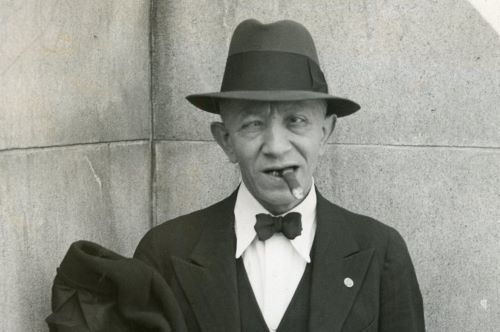
My ninety-seven-year-old father Julius recently amazed me by describing how, when he was hungry during the Great Depression, he would get an occasional free slice of salami from Izzy Pinkowitz, the “official” mayor of East Broadway, who happened to own the Hebrew National sausage factory on his Lower East Side block. How official? “Back then it was official,” he answered, after finishing his favorite old-fashioned cookie, the chocolate-covered Mallomar. “Look into it if you are so curious. The old street mayors of New York would make a good story.”
Father knows best. It is a good story.
New Yorkers are used to hearing some local power players called the “mayor” of their streets, but not all know the time and place where the idea was invented: during the Civil War, in the immigrant-heavy Lower East Side.
Although the Oxford English Dictionary cites some neighborhood “mayors” in England from the nineteenth century, the first credited use I’ve tracked down on the American continent was by an Irish American journalist named Charlie Lynch, writing on spec for the anti-elitist New York Sun. Lynch cleverly built up the eccentrics on his downtown beat to gain inches and dollars, and when, in 1864, he dubbed young saloonkeeper Pat Connolly “the Mayor of Poverty Hollow,” the nickname delighted the public as well as Connolly.
During the Civil War the streets bounded by Pitt, Grand, Cannon, and Rivington did form a hollow on the Lower East Side. At the foot of a hilly block of Grand Street was a site crowded with poor Irish workers from County Tyrone who had relocated there after the Great Famine. The gabby Connolly, whose pub was on the ground floor of his shanty at 245 Delancey Street, had cultivated connections with his regulars and local politicians. It was likely Lynch who later christened downtown marriage broker Max Hahn the mayor of Avenue C and bestowed mayor of Second Avenue on Simon Steingut, a wealthy Tammany Hall captain who had built up a real estate and insurance business from tenement roots and gave Christmas blankets to the poor.
The immigration density of the old Lower East Side allowed neighborhoods to feel like different cities, if not distinctive worlds. The spread of newspapers in local dialects or languages also fueled the popularity of “street mayors,” as well as the business benefits that these civic ciphers got from their honorary titles. Some of the local mayors lived conspicuously beyond their means; since they could deliver local votes by granting favors, they were often suspected of being paid off the books by those in power at Tammany Hall.
These mimeographed mayors might be easy to dismiss as Pickwickian characters, but the titles actually did increase respect for these already locally influential men. Street mayors were likable fixers who cut through red tape and might settle between fifteen and twenty neighborhood disputes a day. They served social and even political functions, reflecting in part the graft and inefficiency of elected politicians.
READ ENTIRE ARTICLE AT LAPHAM’S QUARTERLY
What Everyone Gets Wrong About LBJ’s Great Society
It wasn’t some radical left-wing pipedream. It was moderate; and it worked.
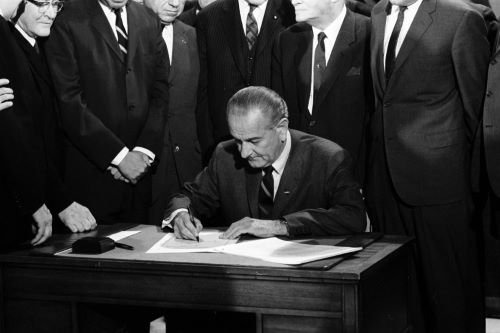
Since at least the early 1980s, Republicans have been committed to dismantling Lyndon Johnson’s Great Society—a collection of programs the 36th president vowed would lead to “an end to poverty and racial injustice.”
Twenty-one years later, in a scorching address delivered in 1983, President Ronald Reagan denounced the Great Society as a bundle of expensive and failed initiatives that contributed to, rather than alleviated, suffering. Johnson’s legacy reinforced the what Reagan called the “central political error of our time”: the flawed notion that “government and bureaucracy” were the “primary vehicle for social change.”
A Democratic Congress blocked Reagan in his attempts to unravel Johnson’s work, but no such obstacle encumbers President Donald Trump. Congressional Republicans control both chambers and are far more conservative in their views than they were in Reagan’s time. Many signature items of Johnson’s legacy—from civil and voting rights to environmental protections and aid to public schools—are today under assault. Indeed, there is no more a dogged advocate of overhauling the Great Society’s antipoverty programs than House Speaker Paul Ryan, who claims that their “top-down approach” “created and perpetuated a debilitating culture of dependency, wrecking families and communities.”
Yet for all Johnson’s grandiose rhetoric, the Great Society was more centrist—and is more critical to the nation’s social and economic fabric—than has been commonly understood. The presidential aides who conceived and implemented its component parts rejected policies that would enforce equality of income, wealth or condition. They did not broadly support quantitative measures like cash transfers or a guaranteed minimum income but, rather, believed that qualitative measures like education, workforce training, access to health care, food security and full political empowerment would ensure each American a level playing field and equal opportunity to share in the nation’s prosperity.
Governing in an age of unmatched prosperity, the architects of the Great Society were convinced that the means to a more just society was not cutting the pie into smaller slices so that everyone would enjoy an equal share, but baking a larger pie. The idea that the economy might someday stop growing, or that inequality would increase, rarely factored seriously into liberal thinking.
Fifty years later, it’s perfectly legitimate to ask whether Johnson’s vision is adequate in a country in which fewer workers enjoy employer pensions and health care, 31 percent of children live in single-parent families (up from 12 percent in 1960), household wages have long been stagnant, and inequality has reverted to levels we have not seen since the eve of the Great Depression. But it’s a myth to say the Great Society failed, just as it’s a myth to portray it as a radical left-wing, big-government project. And understanding those myths is the key to figuring out what to do now.
READ ENTIRE ARTICLE AT POLITICO MAGAZINE
Solving Homelessness Requires Getting the Problem Right
Decades of stigmatizing and trying to police the homeless have perpetuated the problem.
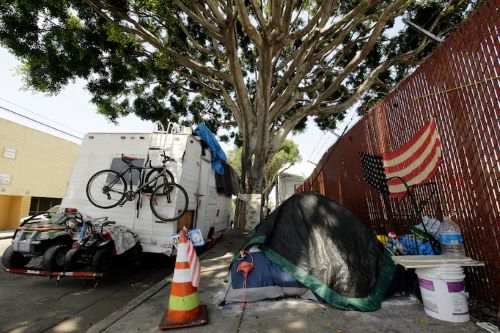
Last month, Judge David Carter ordered Los Angeles officials to find shelter for all homeless people in downtown L.A. by October 2021. This follows Mayor Eric Garcetti’s call for spending $1 billion to address the area’s homelessness crisis. These are unprecedented actions that speak to the significant and tragic state of homelessness in Los Angeles, but they reflect urban tensions that have deep roots. The long history of American “skid rows” suggests that solving this crisis requires understanding the true dimensions of the problem and the diverse needs of homeless people, something we have long failed to do.
In the late 19th century, transient workers uprooted by industrialization gathered in cities near job opportunities. The shabby districts they occupied came to be known as skid rows, a name they kept for more than 100 years. Skid rows were primarily home to single men and contained inexpensive lodging, restaurants and bars. Those men who couldn’t afford lodging received help from religious missions, which offered sermons, meals and overnight accommodations. Many police stations and later municipal shelters also offered a place to sleep for a night.
During the Great Depression, as formerly working-class people joined the homeless, crushing need outstripped existing systems of assistance and long bread lines wrapped along city sidewalks as encampments sprouted up everywhere possible, including New York City’s Central Park. President Franklin D. Roosevelt started the Federal Transient Program, a system of shelters designed to keep homeless individuals and families off the streets. This bold program acknowledged that homeless people often lacked the local residency required to access relief programs and funded assistance for localities to distribute.
READ ENTIRE ARTICLE AT THE WASHINGTON POST
If Biden Wants to Be Like F.D.R., He Needs the Left
Radical agitation helped bring Social Security and much of the New Deal into being.
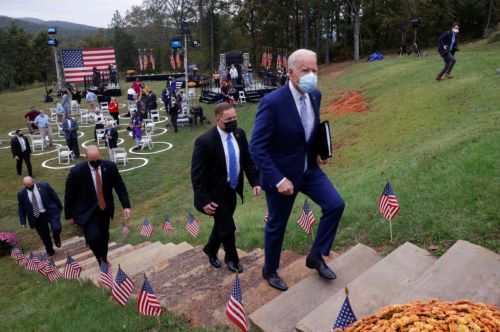
Not long before Election Day, Joe Biden traveled to Warm Springs, Ga., to deliver a speech on the healing of America.
This place, Warm Springs, is a reminder that though broken, each of us can be healed. That as a people and a country, we can overcome a devastating virus. That we can heal a suffering world. That yes, we can restore our soul and save our country.
The location was intentional. Warm Springs is where Franklin Delano Roosevelt went to rest and recover, beginning in 1924, after his polio diagnosis and subsequent paralysis in 1921. As president he made it, along with his home in Hyde Park, N.Y., a kind of winter White House. He died there in 1945, just a few months after taking the oath of office for a fourth time. The town remains a shrine to the 32nd president, an ideal stop for someone who hopes to channel Roosevelt’s ambition (and also saw electoral opportunity in the state).
We now know that Biden will be president, but he won’t have the votes for F.D.R.-size legislation. This doesn’t mean he’s dead in the water, but it does mean that Biden will have to marshal every resource and rely on every possible ally to win whatever victories he can. And he should know, as Roosevelt did, that this means grappling with the left — all of the left, including its most radical edges.
READ ENTIRE ARTICLE AT THE NEW YORK TIMES
Arts and Entertainment
Working-Class Artists Thrived in the New Deal Era
During the New Deal, mass left movements and government funding spawned a boomlet in working-class art. For once, art wasn’t just the province of the rich.
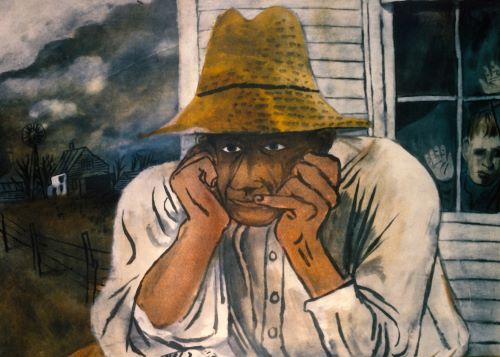
The last time New York City’s Metropolitan Museum of Art was prominent in socialist conversation was probably in 2021 when Alexandria Ocasio-Cortez attended the Met Gala, a lavish annual display of wealth and fashion, wearing a white dress with the words “Tax the Rich” emblazoned in red. Whatever you made of that intervention — protest? Act of complicity? — the Met deserves even more socialist attention now for an inspired show titled Art for the Millions: American Culture and Politics in the 1930s. (You can look at the entire exhibition here.)
The reasons that artists in the 1930s were so prolific, their work so political and so profoundly engaged with laborers and with left politics, are simple. There were mass left movements, including parties, influencing artists and the wider culture. As well, and as a result, President Franklin D. Roosevelt (FDR)’s administration offered significant government support for artists, which made it possible for many working-class and leftist artists to pursue creative lives full time.
The show at the Met is beautifully curated to emphasize the period’s left politics and focus on workers. Most of the paintings are in realist style (though some of the same artists did more abstract work before or after this period). The painting most prominently advertised in the show, for example, is Miner Joe (1942), by Elizabeth Olds, a stunning close-up of a miner with his helmet on. The exhibition also includes Ben Shahn’s photos of black cotton pickers, as well as lesser-known works like Curtain Factory (1936–39), by Riva Helfond, which depicts women workers and includes an unmistakable visual reference to Picasso’s Woman Ironing. Next to it is Elizabeth Olds’s Burlesque (1936), an homage to dancers as workers.
READ ENTIRE ARTICLE AT JACOBIN
This Land Is Your Land
The Popular Front and American culture.
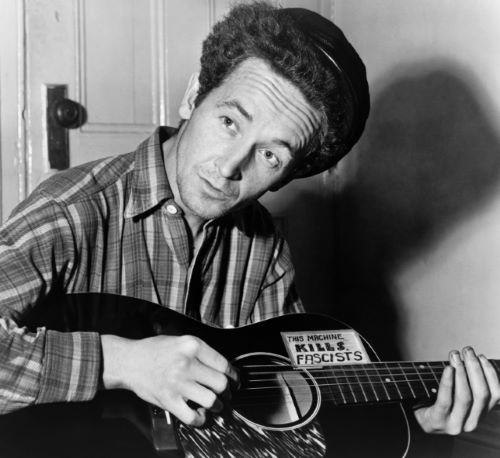
Consider the words and images of the Great Depression that, alongside speeches by President Franklin D. Roosevelt, remain icons more than eighty years after the long slump began. “Once I built a railroad, / Made it run / Made it race against time / Once I built a railroad / Now it’s done / Brother, can you spare a dime?” In Yip Harburg’s lyrics, set to a Russian-Jewish lullaby, a beggar talks back to the system that stole his job. The man seeking a handout is everyman—once a farmer and a combat veteran as well as a construction worker. Then there is Dorothea Lange’s Migrant Mother (whose name was Florence Owens Thompson). Framed by two shy children, she reflects while she suffers, hinting that poverty can ennoble, even strengthen one who bears no responsibility for her plight. In The Grapes of Wrath, John Steinbeck crafted an epic about such figures, documenting the same dialectic between oppression and fighting back. “We’re the people that live. Can’t nobody wipe us out,” asserts Ma Joad in the prizewinning film John Ford made from Steinbeck’s best-selling book. “Can’t nobody lick us. We’ll go on forever, Pa. We’re the people.”
All these works were created by individuals active in the culture of the Popular Front, a vigorously democratic and multiracial movement in the arts and daily life that was sponsored but not controlled by the Communist party. Harburg was a leading member of pro-Soviet groups in Hollywood and penned dozens of songs that satirized racist lawmakers and Cold Warriors, which helped earn him a blacklisting in 1950. But he kept the Oscar he had won a decade earlier for writing “Over the Rainbow” for The Wizard of Oz. In 1935, Lange left a fairly comfortable life as a portrait photographer to join other artists of the Farm Security Administration, most of whom were on the left fringe of New Deal opinion. Her pictures of farmworkers from all regions and races appeared in Life and other mainstream outlets. The photos, according to her biographer, Linda Gordon, “not only challenged an entire agricultural political economy, but tried also to illustrate the racial system in which they operated—a system it also reinforced.” Steinbeck, who occasionally wrote words to accompany Lange’s images, had worked closely with the Communist party-led union of agricultural and packing workers in its vain but valiant attempt to bring democracy to the fields of California. His wife, Carol Henning, was a party member. When the state’s agribusinessmen and favored lawmakers tried to get The Grapes of Wrath banned from public libraries, Communist periodicals helped organize an anticensorship campaign to stop them.
To understand the fortunes of American communism during its heyday in the 1930s and forties requires a healthy taste for irony. On the one hand, the apostles of Lenin and Stalin yoked themselves to one of the bloodiest, most repressive regimes in history and the first one whose dictatorial nature mocked its own vision of a world run by working people. Yet the Communist party had a striking influence on American culture, although seldom in its own name. The influence of Popular Front culture endured long after the party had been banished to the crumbling margins of American politics. The number of renowned writers, filmmakers, entertainers, and artists who had traveled with the Communists during its heyday was quite remarkable, given the party’s modest size and electoral inconsequence. Party members wrote “Ballad for Americans,” “Strange Fruit,” “This Land Is Your Land,” Native Son, The Little Foxes, and Mr. Smith Goes to Washington. Artists who, while not members, had spent many evenings in the party’s milieu, created Citizen Kane, Death of a Salesman, “Fanfare for the Common Man,” For Whom the Bell Tolls, Yertle the Turtle, Invisible Man, and wrote the screenplay for Casablanca. Novelists in or close to the party had nine books at or near the top of the best-seller list from 1929 to 1945.
That we still view the Depression largely through images created by such figures suggests that the Left was more influential working through aesthetics than organization. Radicals achieved their only lasting triumphs during the years of the 1930s and forties by advancing a new common sense about larger social and moral questions: Who were the people? How did they want the nation to change? What did a commitment to equal rights require? As a young, left-wing critic observed in 1942, “It was the depression of the mind that from the first gave significance to the depression of society, for the impact of the crisis on culture was far more violent than its transformation of the social order.”
READ ENTIRE ARTICLE AT NATIONAL ENDOWMENT FOR THE HUMANITIES
Looking Back to Lincoln
During the Great Depression, Americans found solace in history.
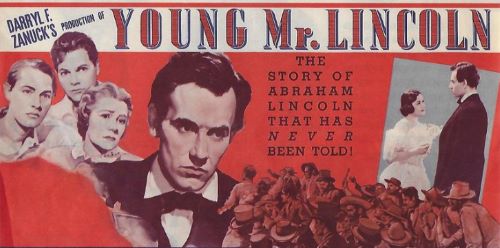
Abraham Lincoln and the Civil War are part of history. But as WNYC’s Sara Fishko tells us, that history came forward to provide inspiration and more through trying times in 20th century America.
The History of American Fear
An interview with horror historian David J. Skal.
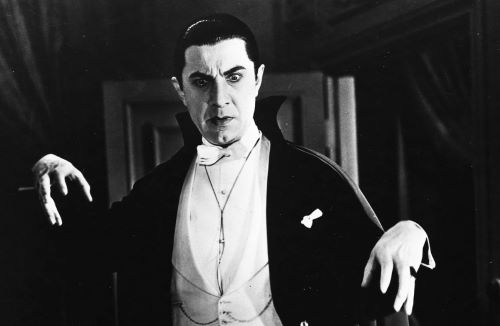
You’ve spent decades writing about horror and American history. What have you learned?
Horror movies provide a secret history of modern times. All the great social cataclysms and traumas of at least the 20th century seem to have put in motion, decade by decade, new patterns in the kinds of entertainment we use to scare ourselves. And I think what we’re doing is processing unpleasant information in such a way that we don’t have to look at it too directly. It’s not exactly catharsis; I invented the term “catharsis interruptus,” which maybe describes it better as a half-remedy, a temporary coping mechanism for dealing with the conundrums and challenges and traumas of modern life. Something that at least gets us through the night.
When do we first start to see horror films in America? What are these early films like?
In American silent cinema, there were often scary stories and terrifying characters, usually played by Lon Chaney, the famous “man of a thousand faces.” But they were always human beings, and if something seemed to be ghostly or supernatural, it had to be explained away as a criminal enterprise.
That wasn’t the case in Europe, where the early cinema embraced the outright fantastic from the very beginning — the trick films of Georges Méliès, for instance. And then there were the German expressionist classics like “The Cabinet of Dr. Caligari” and “Nosferatu” — which were not escapist entertainment, but rather self-conscious art films intended to embody metaphors about the Great War. In “Caligari,” you have this malignant authoritarian figure sending forth his sleepwalker to kill and be killed, just as untold numbers of soldiers had been in the Great War. And in the original promotion for “Nosferatu,” there was this idea that the vampire represented the cosmic vampire of war itself, which had drained the blood out of Europe.
The Living Newspaper Speaks
Scripted from front-page news, the Federal Theatre Project’s Living Newspaper plays were part entertainment, part protest, and entirely educational.
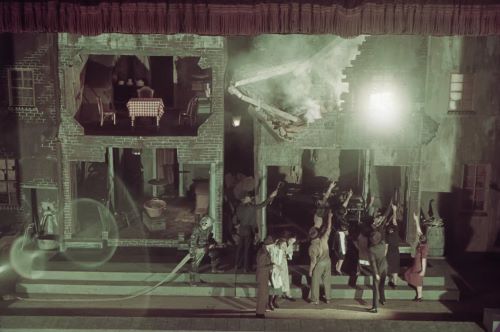
As unprecedented as the COVID-19 pandemic seems, 2020 wasn’t the first time American theater professionals found themselves in a difficult situation, without jobs or audiences due to Broadway closures. In the 1930s, when the Great Depression rather than a novel coronavirus pushed theater workers into dire straits, the government stepped in to provide a much-needed shot in the arm with the nation’s first publicly funded arts program.
Operated between 1935–1939, during Franklin Delano Roosevelt’s first presidential term, the Federal Theatre Project (FTP) was an effort by the government, within the larger context of New Deal social programs, to provide viable, salaried opportunities for out-of-work theater professionals. The Works Progress Administration selected Hallie Flanagan, a multi-talented author, playwright, director, and producer, to lead the program. Her stated mission was plain and ambitious: “The primary aim of the Federal Theatre Project,” she wrote, “is the reemployment of theatre workers now on public relief rolls: actors, directors, playwrights, designers, vaudeville artists, stage technicians, and other workers in the theatre field. The far reaching purpose is the establishment of theatres so vital to community life that they will continue to function after the program of this Federal Project is completed.”
Under Flanagan’s guidance, the FTP produced and performed classical theater as well as experimental productions in a network of regional venues across the nation, expanding access to theater for everyday Americans at a time when entertainment was welcome and needed. A majority of the shows were presented either free of charge or for token admission, the purpose of the program being to employ people rather than to generate ticket income.
READ ENTIRE ARTICLE AT JSTOR DAILY
Spotlighting Communism & Hollywood in the Papers of Sesame Street’s Mr. Hooper
The actor who played the loveable grocer found his way to Sesame Street after being blacklisted during the Red Scare.
One of the most recognizable figures of the first thirteen years (1969-1982) of PBS’s Sesame Street was Mr. Hooper the grocer, played by veteran actor Will Lee. He was one of the four original human characters on the show.
Before appearing in Sesame Street, Lee had a long career in theater and movies, although his career was interrupted during the 1950s because of being blacklisted during the “Red Scare” of that time. So, why would this innocuous grocer be blacklisted?
Let’s start from the beginning. In 1908, William Lubovsky was born in Brooklyn, the son of Jewish immigrants. His father, a bookbinder, lost his job due to economic changes. Will Lee came to adulthood during the Great Depression. He worked odd jobs in New York City and absorbed the intellectual atmosphere of Greenwich Village, an enclave of avant-garde culture where small presses, art galleries, and experimental theater thrived.
READ ENTIRE ARTICLE AT AMERICAN HERITAGE CENTER BLOG
The Muralist and Enumerator
How a census taker and an artist were participants to the grand project of displaying and explaining America to itself.
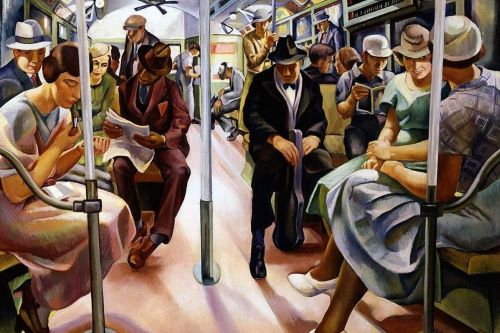
The records of the U.S. Census Bureau reside in Washington, D.C., in the National Archives building built in the depths of the Great Depression to provide a monumental home to federal records. Inside those acres of white marble visitors encountered the founding of the United States in murals and on parchment. Instead of “Washington Crossing the Delaware,” a martial celebration of the nation’s birth through grit and force, the exhibition hall presented a nation made on paper. While tourists today still line up on the Constitution Avenue steps to pay respects to the Bill of Rights or Declaration of Independence, genealogists and other researchers like me breeze through the Pennsylvania Ave entrance and (after some card swiping and paper shuffling) take our seats at grand wooden desks in a well-lit, stately reading room. Researchers call the facility, affectionately, NARA-1, distinguishing it from the much larger, but less grand –National Archives facility in College Park, MD.
From my favorite desk, I can peek out the windows and see the facade of the Smithsonian American Art Museum. (I suspect you heard about a couple portraits recently unveiled there.) When the day ends and I climb out from under the records I’ve requested—neck creaking and lower back aching from leaning, reaching, typing, photographing—I often walk a few blocks north to wander among the canvases.
READ ENTIRE ARTICLE AT CENSUS STORIES, USA
The Bloody Labor Crackdown Paramount Didn’t Want America to See
Executives feared their newsreel footage would “cause riots and mass hysteria.”
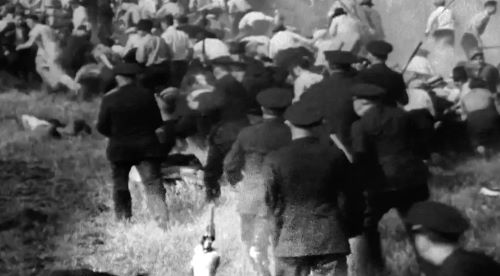
Even in this age of police bodycams and bystander videos, there are certain categories of footage that most media organizations won’t share with the public. We rarely see corpses, for instance, and never executions or graphic images from school shootings. This sanitizing censorship may be intended to prevent such horrors from being normalized or gleefully distributed on the internet. But it’s hard to imagine today’s news creators suppressing, as they did in 1937, footage from the deadly anti-labor crackdown that came to be known as the Memorial Day Massacre.
On May 30, 1937, Orlando Lippert, a veteran cameraman for a leading newsreel outlet, Paramount News, was assigned to cover a Memorial Day picnic in Southeast Chicago. But his assignment would turn out to be more than just a holiday puff piece. Workers at the local Republic Steel plant had been on strike for several days, seeking recognition for their new union and vying for adoption of the same landmark concessions recently won by their colleagues at US Steel, including an eight-hour day and time-and-a-half overtime pay.
The economic hardships of the Great Depression had eased only slightly during the preceding months, and labor organizing had caught fire in many sectors. A new tactic, “sit down strikes,” helped produce major wins for labor at General Motors and Ford in nearby Detroit. Local police, friendly with the Republic Steel bosses, had already clashed with some of the strikers that week, cracking heads. And so, to demonstrate their resolve, the Steel Workers Organizing Committee sought an impressive turnout of supporters on Memorial Day.
READ ENTIRE ARTICLE AT MOTHER JONES
The Late ’30s Deplatforming of Father Coughlin
Then as now, not many people were willing to raise their own voices to defend the speech of a vulgarian spewing hate over a mass medium.
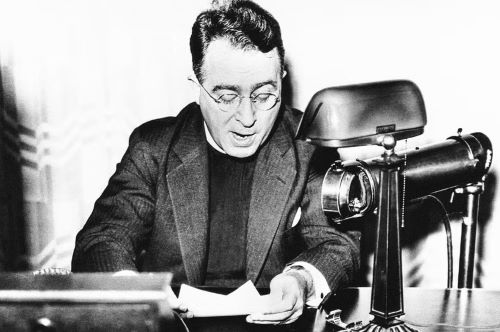
On Nov. 20, 1938, WMCA in New York had enough of Father Charles E. Coughlin’s anti-Semitic bile. After a supposed homily entitled “Persecution: Jewish and Christian,” in which he denounced Jews in language that might have been lifted from Der Stürmer, an announcer broke in to distance the station from Coughlin’s talk. “Unfortunately, Father Coughlin has uttered many misstatements of fact,” he informed listeners. Donald Flamm, the president of WMCA, later pledged “not to permit a repetition” of Coughlin’s inflammatory remarks, words that were “calculated to stir up religious and racial hatred and dissension in this country.”
The story of Coughlin, the demagogic radio priest who dominated American airwaves during the Great Depression, offers an intriguing analog-age precedent to the digital-age debates over the limits of free expression. Then as now, the serene pleasure of no longer having to listen to a noxious voice blare incessantly in the ear coexists with a queasy unease at the realization of how suddenly and imperiously the rulers of corporate media can switch off one’s microphone.
Coughlin was the longest-lived and loudest of the rabble-rousing orators who channeled the grievances of millions of economically desperate and culturally unmoored Americans in the 1930s. The lineup included Louisiana Sen. Huey Long, who wanted to make “every man a king,” or so he said; Long’s self-appointed successor, the unhinged hatemonger Gerald L. K. Smith; and the comparatively sane and lowkey Francis Townsend, who rose to prominence on a scheme for an old-age pension giveaway. Of those figures, only Coughlin’s fame is impossible to imagine without the amplification of radio, beamed out live, coast to coast, the new transmission belt for American culture. For the first time, a politician, an entertainer, or an advertiser could enthrall a nationwide audience at the same existential moment.
Making Theatre Dangerous Again
In segregated units set up under the Federal Theatre Project, African American artists took on work usually reserved for whites and wrote radical dramas.
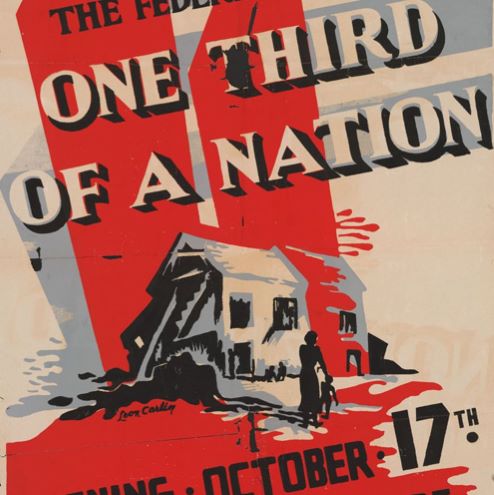
Between 1935 and 1939, the United States government paid out-of-work artists to write, act, and stage theatre as part of the Federal Theatre Project (FTP), a New Deal job relief program. In segregated “Negro Units” set up under the FTP, African American artists took on theatre work usually reserved for whites, staged black versions of “white” classics, and developed radical new dramas. In this fresh history of the FTP Negro Units, Kate Dossett examines what she calls the black performance community—a broad network of actors, dramatists, audiences, critics, and community activists—who made and remade black theatre manuscripts for the Negro Units and other theatre companies from New York to Seattle.
The anxiety that theatre be made “safe” has a history as old as the Republic itself. It was a particular concern in the 1930s, a decade with parallels to the 2010s, when global white supremacy and extrajudicial killings of minorities propelled strong men to power around the world and governments on both the left and the right looked to control cultural production. In the United States, unemployed theatre professionals were paid by the federal government to write, act and produce theatre for four years between 1935 and 1939 under a national programme called the Federal Theatre Project. It included seventeen, separate Negro Units where African American dramatists, actors and directors took on roles usually reserved for whites, staged black versions of ‘white’ classics, and produced radical dramas of their own. Plays by Theodore Ward, Abram Hill, Theodore Browne, Joe Staton and others centered black experiences and directly confronted white audiences.
The Federal Theatre Project reached an estimated twenty five million Americans, many of whom had never before seen a live theatre show. Its popular appeal, provocative new dramas and insistence on integrated audiences, at a time when segregated seating was commonplace in both Northern and Southern theatres, infuriated white politicians across the political spectrum. Critics feared that state-sponsored theatre fostered not only radical black dramas but real life interracial mixing: theatre was becoming unsafe. In Congress, Southern Democrats and Republicans lined up to denounce the Federal Theatre as “un-American” and “pro-Communist,” and in 1938 they set up a congressional committee to hold hearings on suspected un-American activity in government agencies.
READ ENTIRE ARTICLE AT UNC BLOG
The Commercial Rise of Country Music During the Great Depression
The Depression was the gravitational pull that created country stars and their nationwide universe of listeners.
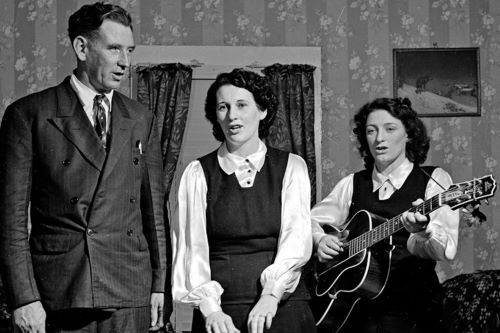
In July 1927, record executive Ralph Peer set up mobile recording equipment in the unused upper floors of a hat company in Bristol, Tennessee. For two weeks, musical acts from the surrounding Appalachian hills performed dozens of takes of “hillbilly music.” These sessions were the first time that Southern, white, rural music had been professionally recorded. The recordings are immortalized in the Library of Congress, and Bristol is acknowledged by Congressional resolution as the birthplace of country music. Johnny Cash called Peer’s trip to Bristol “the single most important event in country music.” But while the sessions may have been the Big Bang of country music, the Great Depression was the gravitational pull that created country stars and their nationwide universe of listeners.
Before Peer’s recording sessions, Appalachian music was confined to the people who were born and raised in the region. But in the 1920s, an economic crisis that foreshadowed the national crisis pushed farmers off their land and threw coal miners and millhands out of work. Unemployed and desperate, people moved to cities–to Atlanta and Nashville, but also to the industrial centers of Chicago, Cleveland, and Detroit, where one executive crowed that his new workers “were glad to get whatever wages were given to them.” Farmers, miners, and textile workers packed their pitiful things and took their families north. One thing they would not leave behind was their love of the music of their beloved mountains.
When the economic crisis hit the rest of the country, the Depression enabled country music to go national. Phonograph sales atrophied–sales in 1932 were less than one-tenth of those in 1929–and radio and jukeboxes became music’s new inexpensive platforms. By 1932, radios that had been $139 were selling for $47. Paying in installments, nearly 60% of American households had a radio by 1933. Radio was a good entertainment value at a time when people struggled to pay rent and put food on the table. It became indispensable. A Kentucky survey found that radio “exceeded telephone calls, news service, and circular letters as a means of influencing rural people.” At the same time, the out-migration from Appalachia prior to and during the Depression meant that there was an urban market for country music.
The first radio station to feature country artists regularly was Atlanta’s WSB, which began broadcasting in 1922. Fort Worth’s WBAP followed with the first Saturday night “barn dance,“ a live stage show that featured traditional Appalachian music. Nashville’s Grand Ole Opry, West Virginia’s Wheeling Jamboree and Des Moines’ Iowa Barn Dance Frolic followed quickly, as did similar shows from Tulsa to Minneapolis, Philadelphia to Los Angeles, Richmond to Cincinnati, and even to the Canadian province of Ontario.
Chicago’s WLS, owned by Sears, Roebuck & Co., then the “World’s Largest Store,” aired the local barn dance to its huge national audience to promote its catalog. Rural families responded. “This is an old-fashioned home,” one listener wrote in, “supper with us is done early on Saturday night–a big pan of popcorn and a dish of shiny red apples–a good fire and the radio dialed to WLS at 7 o’clock–we stay with you until you sign off.” In 1933, the National Barn Dance was picked up by NBC and carried nationwide, and country music went coast-to-coast.
READ ENTIRE ARTICLE AT WE’RE HISTORY
What ‘It’s a Wonderful Life’ Teaches Us about American History
The Christmas classic, released 75 years ago, conveys many messages beyond having faith in one another.
More than once every year, and not always around Christmas, I sit down to watch my all-time favorite film, Frank Capra’s 1946 classic It’s a Wonderful Life. The film tells the story of George Bailey, played by Jimmy Stewart, who encounters a crisis on Christmas Eve when his elderly uncle misplaces $8,000 from the shareholders of the family business, leading George to believe he is a failure—worth more dead than alive. A guardian angel, sent from the heavens to protect him, gives George a glimpse of what the world would be like without him. Persuaded of his value to his community, he breaks out of his suicidal depression, returns home to his family and realizes that the love and fellowship of others is what makes one’s life truly wonderful.
As millions of people will do this December, I tear up at the end when George’s friends, neighbors and family come together to replace the money and demonstrate to him that “no man is a failure who has friends.” As a graduate of a Jesuit education, I have always been moved by the theme of selflessness in the film and felt that George’s life of service matched the Jesuit motto of “Men for Others” that I grew up with.
Beyond the inspirational qualities and memorable moments that make the movie a beloved holiday staple, It’s a Wonderful Life can be explored and viewed in another way: as a presentation of history on the screen. In 2015, staff at the Smithsonian’s National Museum of American History started the History Film Forum to explore film as public history. Many Americans and people from all over the world learn history from movies; the discussions we’ve hosted among scholars, filmmakers and audiences explore that dynamic in valuable and meaningful ways. This year, the forum examined both narrative and documentary films ranging from Questlove’s remarkableSummer of Soul on the 1969 Harlem Cultural Festival to The Courier with Benedict Cumberbatch, which looks at the thrilling tale of a Cold War-era spy. Every year, films such as these are explicitly intended to present historical stories and impress upon viewers a little-known narrative of the past. But other films that don’t have that educational intention nevertheless end up edifying (or miseducating) their viewers about history, particularly when watched decades after their release. In fact, as my colleague, the museum’s entertainment curator Ryan Lintelman, said in our recent discussion on It’s a Wonderful Life, “Some of the movies that are seen by the most people around the world probably have had the most impact even though they’re sometimes not directly dealing with weighty political issues.”
At the beginning of the film, after pleas on behalf of George reach the heavens, two angelic figures converse on how to respond. The angels, Joseph and Franklin, who appear as clusters of light in space, bring in an apprentice named Clarence, a clockmaker in life, who hasn’t yet earned his wings by offering help to a human. Though Clarence is eager to save George as he struggles with depression and suicidal thoughts, Franklin instructs Clarence to sit down and tells him, “If you’re going to help a man you want to know something about him, don’t you?” As Clarence gets a background lesson on George’s life, beginning with his brother’s fall through the ice in 1919 through the end of World War II, the audience gets Frank Capra’s version of small-town American history.
READ ENTIRE ARTICLE AT SMITHSONIAN MAGAZINE
“A Trap Had Been Set for These People”
A companion to a new PBS film, “The Memorial Day Massacre,” the first oral history exploring the murder of 10 workers in Chicago.
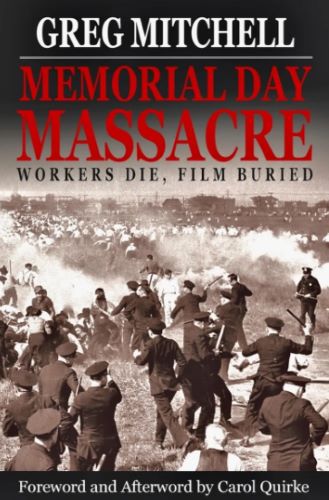
As I have posted here previously, my new film for PBS (and second for them since last autumn), Memorial Day Massacre: Workers Die, Film Buried, premiered over KCET in L.A. last weekend and is now rolling out around the country. But, crucially, it is also now available for everyone everywhere to view (at 27 minutes) for no charge via the film’s main site, which includes background and praise from numerous notables, or very easily via PBS.org and PBS apps. It’s produced by Lyn Goldfarb and narrated by Josh Charles.
There’s also a companion book with the same title, just published, the first oral history of the tragedy. The book (my 13th), in both paperback and as an e-book, features eyewitness accounts by numerous activists and the wounded, and compelling and unique reflections by the likes of Gore Vidal, Studs Terkel, Howard Zinn, Howard Fast, and Dorothy Day, even a cameo by Ayn Rand. Read more about the film and book including praise from notables here. My L.A. Times op-ed here.
In a nutshell: As the Depression continued in May of 1937, steel workers at massive plants in the Midwest and Pennsylvania sought recognition for their new union and basic concessions such as, gosh, the eight-hour day. Police in Chicago clubbed picketers near Republic Steel so union organizers called for a holiday picnic to build support on the wide prairie not far from the plant. The festive occasion drew a crowd of maybe 1500, including many women and children dressed in their Sunday best. The organizers then called for a ragged protest march to the plant.
A contingent of a couple of hundred police halted them halfway there. Soon, forty marchers would be shot, most of them in the back or side, and ten would be dead or dying. Another fifty, clubbed by the cops, suffered head wounds. It was all captured on film by a Paramount News cameraman, whose shocking footage would then be suppressed—until leaked to a famed reporter and then a crusading U.S. Senator screened it at a sensational D.C. hearing.
READ ENTIRE ARTICLE AT BETWEEN ROCK AND A HARD PLACE
The Contested Legacy of Atticus Finch
Lee’s beloved father figure was a talking point during the Kavanaugh hearings and is now coming to Broadway. Is he still a hero?
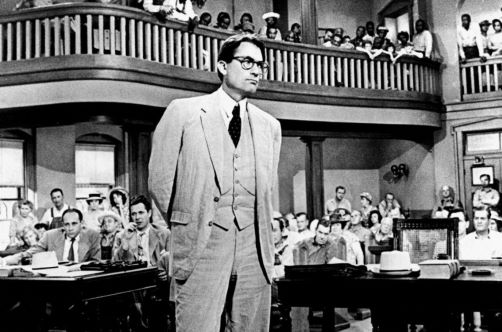
Fictional characters walk off the page all the time, generally as cautionary tales, like Pollyanna or Walter Mitty, but Atticus has inspired legions of lawyers, been memorialized with a public sculpture, had professional-achievement awards and a nonprofit organization named after him, and been invoked admiringly by Barack Obama, who quoted one of the character’s folksy fatherisms in his farewell address as President: “You never really understand a person until you consider things from his point of view, until you climb into his skin and walk around in it.”
Like any legal precedent, though, Atticus has faced challenges and dissents, and lately his status as a hero has seemed perilously close to being overturned. Criticisms of his accommodationist racial politics, his classism, and his sexism went mainstream a few years ago, after the publication of an earlier novel by Lee, “Go Set a Watchman,” which gave us an older Atticus, and a less admirable one: a grownup Scout came home to Alabama from New York City to find that, in his dotage, her beloved father was opposing the work of the National Association for the Advancement of Colored People and attending meetings of a white-supremacist group.
With plenty of actual white men falling from their pedestals, it has seemed, ever since, that Atticus might do so, too. No longer a model of courage and decency even in his fictional daughter’s eyes, he turned out to be a man very much of his time—and, perhaps even worse, of ours, as old prejudices resurge, hate crimes proliferate, and arguments rage about the merits of maintaining civility in the face of bigotry. In October, the Republican senator John Cornyn invoked a talking point that had emerged among conservative commentators, calling the fight to appoint Brett Kavanaugh to the Supreme Court “our Atticus Finch moment.” In doing so, Cornyn ignored the racist post-Reconstruction context of the allegation against Tom Robinson, the persuasiveness of Christine Blasey Ford’s testimony against Kavanaugh, and the fact that all the nominee stood to lose was a job promotion, not his life.
Atticus was suddenly on all the wrong sides, fighting for all the wrong causes. It’s hard to imagine a less auspicious moment to try to bring the character back to life—and yet, for the first time ever, Lee’s beloved father figure is on Broadway, in a new theatrical adaptation of “To Kill a Mockingbird.” It’s not clear, though, whether Atticus is enjoying a revival or taking his final bow.
READ ENTIRE ARTICLE AT THE NEW YORKER
Disney Animators Strike During WWII Changed the Company — and Hollywood
The 1941 strike, following the spectacular success of “Snow White,” stunned Walt Disney and rattled his now-storied company.
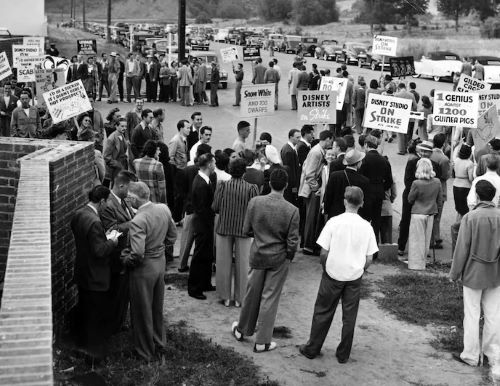
“Snow White and 700 Dwarfs,” one sign on the picket line read, a reference to the hundreds of low-paid animators who helped create Disney’s 1937 box office megahit. “Are we mice or men?” asked another.
Starting at 6 a.m. on May 28, 1941, lines were being drawn outside the gates of Walt Disney Studios between those picketing at “Camp Cartoonist” and their colleagues choosing to work. Shouts of “scab” and “fink” rained down on those who passed through the gantlet. When Walt Disney himself drove through one day, Art Babbitt — the strike leader who had been one of his most prominent animators — shouted that Disney “ought to be ashamed.” The two almost came to blows.
The Disney animators strike, launched eight decades before Hollywood’s ongoing writers and actors strikes, stunned Walt Disney, stoked his fear of communism and rattled his now-storied company.
READ ENTIRE ARTICLE AT THE WASHINGTON POST
Legacy and Lessons: Economy
Milton Friedman, the Prizefighter
The economist’s lifelong pugilism wasn’t in spite of his success—it may have been the key to it.
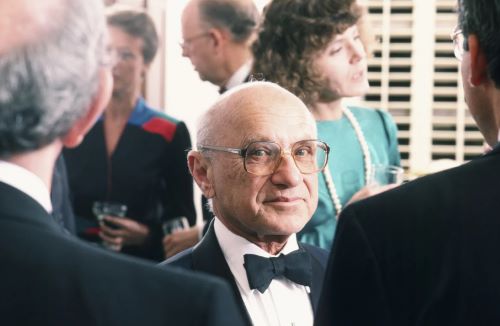
Friedman’s doomsaying was easy to caricature in the relatively prosperous mid-century. In 1966, Solow, the rival economist, memorably cracked, “Everything reminds Milton of the money supply. Well, everything reminds me of sex, but I keep it out of the paper.” Friedman pushed on. In 1968, he published another influential paper arguing that all government attempts to lower unemployment below the natural rate would lead to inflation. That happened to be right around the time that L.B.J.’s welfare expansion intersected with a civilian tax cut and increased military spending in Vietnam. Inflation skyrocketed. Suddenly, the whole country looked like a “natural experiment” for Friedman’s theories. The economy crashed, and the Presidency changed hands to Richard Nixon, who had been a Friedman acolyte since his wilderness years after the Dwight D. Eisenhower Vice-Presidency.
People started looking to Friedman for answers. In 1969, he was on the cover of Time, prophet-like, under the banner “Will There Be a Recession?” After the 1973 oil crisis, Friedman seemed like the only economist who could explain the devastating stagflation that rocked the U.S. and U.K. In 1980, the election of Ronald Reagan in the U.S. and Margaret Thatcher in the U.K., both hugely sympathetic to Friedman, ushered in a decade in which his ideas truly became, as Burns writes, conventional wisdom.
But, throughout this decade mirabilis, Friedman maintained his remarkable tendency to look a gift horse in the mouth. In October, 1979, amid soaring inflation, Paul Volcker, the new chairman of the Fed, announced that the board would stop controlling interest rates—a seemingly direct response to Friedman’s August Newsweek column, which argued that Volcker should do exactly that. Volcker’s whole tenure was Friedman-inflected; in April, 1980, he said, of Fed policy, that “people of monetarist persuasion will believe it more than others.” The resulting “Volcker shock” sent unemployment soaring, but the Fed stuck it out “through foul weather and fair,” and the economy dramatically recovered in 1984, just in time for Reagan’s reëlection. What’s more, unemployment rates eventually went down, which seemed to prove another key Friedman contention—that there didn’t have to be a trade-off between unemployment and inflation. It seemed like monetarism’s finest hour.
READ ENTIRE ARTICLE AT THE NEW YORKER
Why the Philosophers Libertarians Love Always Come Out Worse for Wear
Adam Smith and Friedrich Hayek have been through the wringer.
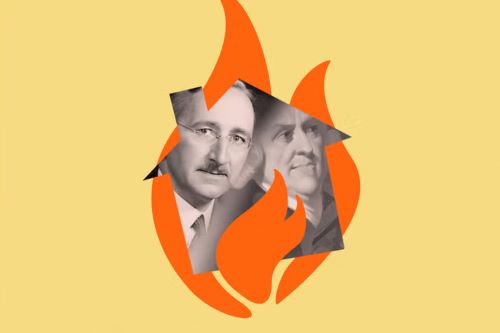
Like most history doctoral students, I needed money to cover basic expenses. Because of that circumstance, and because my dissertation’s argument that the U.S. shouldn’t nationalize Christianity sounds good to people who oppose governmental “interference,” I became affiliated with a libertarian pocket of American conservatism, the Mercatus Center at George Mason University, from 2018 to 2020—first as a research assistant and visiting dissertation fellow, and then as an Adam Smith fellow. Named for a libertarian favorite, the Adam Smith Fellowship required attendance at four separate four-day gatherings, each featuring free-flowing wine, lavish meals, and mandatory hotel stays. During this time, I talked to many, many academically minded libertarians.
The relationship between governance and the market is the “it’s complicated” of modern economic history. Most Mercatus participants blamed societal problems on government intervention itself, turning their faith instead toward the free market. As a fellow, I once met an economist who blamed the Great Depression on Theodore Roosevelt’s activist presidency from 1901 to 1909, not (as is conventional) the laissez faire 1920s. I, like most people, believe instead that the government should help people in need. These fellowships did not change my mind.
But our contradictory political and economic beliefs weren’t the primary point of divergence between me and the other people I spoke with during this time. Rather, what isolated me most from the libertarians I met was our approach to history. The Mercatus libertarians idolize their favorite political-economic philosophers, including Smith, Frédéric Bastiat, Friedrich Hayek, Ludwig von Mises, James Buchanan (the economist, not the president), and Vincent and Elinor Ostrom. They name fellowships after them, decorate their walls with their portraits, and even present fellows with T-shirts featuring the thinkers’ faces. As an academic and political movement, they organize around key figures without considering a central tenet of historical scholarship: change over time. Most libertarians overlook how evolving perceptions of ideas shape how we read these beloved big names. I know the last two sentences might seem like I’m picking interdisciplinary nits. But as time went on, I became convinced these methodological blind spots explain quite a bit about contemporary libertarian thinking.
Two recent books take on some of the Mercatus Center’s favorite political-economic philosophers, proving, I think, my point. Burning Down the House: How Libertarian Philosophy Was Corrupted by Delusion and Greed, by legal scholar Andrew Koppelman, claims that American libertarians have distorted Hayek’s ideals. Adam Smith’s America: How a Scottish Philosopher Became an Icon of American Capitalism, by political scientist Glory Liu, shows how Americans have perceived Adam Smith and his ideas over time. Both aim to follow best practices in historical thought, such as change over time and the provision of tons and tons of context.
How We All Got in Debt
Consumer debt shapes American lives so thoroughly that it seems eternal and immortal, but it’s actually relatively new to the financial world.

Student loans continue to burden adults decades after they’ve left school, and credit card debt haunts many Americans. On the flip side, many of us make leveraged investments in our homes, taking out mortgages to buy houses that we expect to appreciate in value. In other words, debt structures American lives in myriad ways. But, as historian Louis Hyman writes, this is a relatively new thing.
In the nineteenth century, Hyman points out, if an individual needed credit, they turned to friends, loan sharks, or local merchants. For corner grocers and country stores, these loans were money-losing propositions with no interest charged. Any institution with a lot of money lent it not to consumers but to businesses.
This changed with the rise of the automobile. In the 1920s, finance companies emerged as middlemen, borrowing from banks and lending to car dealerships, which could then extend financing plans to individual buyers.
“For the first time, money from the core of capitalism, the consumer banks, was invested, albeit indirectly, in consumer debt,” Hyman writes. “What began with automobiles spread to vacuum cleaners, furniture, radios, and nearly every kind of durable good desired in the great boom of the 1920s.”
And then the economy crashed. Fearful of the financial devastation of the Great Depression, banks declined to invest either in industry or in consumer lending. Would-be consumers were left without the money to buy much of anything, particularly homes. In 1934, the federal government responded by creating the Federal Housing Administration, its own go-between for connecting banks with home buyers and guaranteeing the mortgage loans they made. The Federal National Mortgage Association, better known as Fannie Mae, was created four years later. Fannie Mae helped create a national market, allowing large financial institutions to buy mortgage debt from local banks.
READ ENTIRE ARTICLE AT JSTOR DAILY
Paul Samuelson Brought Mathematical Economics to the Masses
Paul Samuelson’s mathematical brilliance changed economics, but it was his popular touch that made him a household name.

For 30 to 40 years after the end of the Second World War, Paul Samuelson was one of the best-known economists of all time. His name would have been familiar not just to other economists and students but to readers of The New York Times, The Washington Post and, above all, Newsweek, where he had a regular column for 15 years. In parts of the world, Samuelson’s fame even eclipsed that of John Maynard Keynes, who had been a major public figure as well as an economist.
And yet there is a paradox at the heart of Samuelson’s work. His reputation was based on his mathematical economics – abstract theories that would mean nothing to non-economists. At one point, some of his teachers even thought that he might be unemployable because they doubted whether he could teach ‘normal’ economics students; that is, people who knew less mathematics than he did. However, within a decade of obtaining his doctorate in 1941, Samuelson published an introductory economics textbook that became canonical in part for its success in presenting the subject in an accessible way, quite unlike the dry tomes of his predecessors in both content and appearance.
Samuelson’s Economics: An Introductory Analysis (1948) has gone through 19 editions and been translated into 41 languages. The first 11 editions sold more than 3 million copies. The book uses hardly any mathematics and is full of data about American households, firms, labour unions and government activities. How did an economist whose early reputation derived from his rarefied mathematical skills grow into one of the discipline’s great communicators?
The answer is to be found in the years just before and during the Second World War. At that time, Samuelson, mentored by Alvin Hansen (a professor of economics at Harvard University), began to think about how government spending could be used to make sure that there was never another Great Depression. To understand why the question gripped Samuelson, it is necessary to know a little about who he was, and how he became an economist.
Selling Keynesianism
Today, we can learn a lot from the popularizing efforts that led to that consensus that Keynesianism leads to and long-lasting economic success.
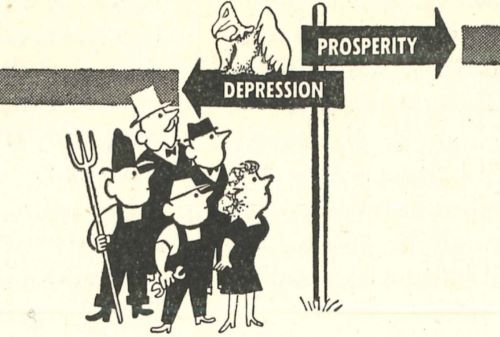
“Let’s bring our editorial microscope into focus on a very significant phenomenon,” the video begins. “The middle-income consumer.”
As a middle-aged white man comes into view, pushing a wheelbarrow full of recent purchases, the voiceover chronicles his recent exploits. “He has fed new demands into the production apparatus of industry, accounting for the housing boom, appliance sales, the rush for prepared foods.” Altogether, we hear, “the zoom in the American market after the war, the unprecedented volume of goods of all kinds, gobbled up by an insatiable tide of buyers, was largely the work of this middle-income man.”
After decades of praise heaped on “job creators,” viewers today may find it disorienting to see the consumer—and a middle-income one at that—cast as the hero of the economy, instead of the investor or the entrepreneur. Yet Fortune, which produced the video in 1956, was hardly an outlier. In the mid-twentieth century, advertising, popular press, and television bombarded Americans with the message that national prosperity depended on their personal spending. As LIFE proclaimed in 1947, “Family Status Must Improve: It Should Buy More For Itself to Better the Living of Others.” Bride likewise told its readers that when they bought new appliances, “you are helping to build greater security for the industries of this country.”
This messaging was not simply an invention of clever marketers; it had behind it the full force of the best-regarded economic theory of the time, the one elaborated in John Maynard Keynes’s The General Theory of Employment, Interest and Money (1936). The key to full employment and economic growth, many at the time believed, was high levels of aggregate demand. But high demand required mass consumption, which in turn required an equitable distribution of purchasing power. By ensuring sufficient income for less well-off consumers, the government could continually expand the markets for businesses and boost profits as well as wages. Conversely, Keynes’s theory implied, growing income inequality would lead to lower demand and slower economic growth.
READ ENTIRE ARTICLE AT BOSTON REVIEW
The End of Friedmanomics
The famed economist’s theories were embraced by Beltway power brokers in both parties. Finally, a Democratic president is turning the page on a legacy of ruin.
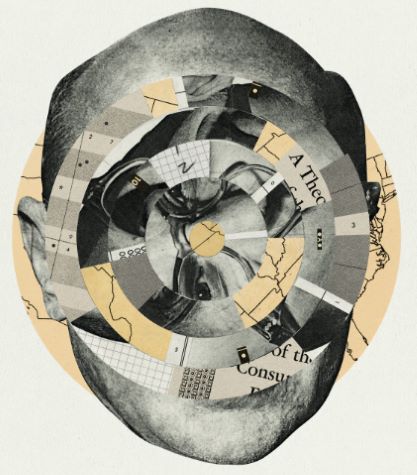
When he arrived in South Africa on March 20, 1976, Milton Friedman was a bona fide celebrity. He had been invited by the University of Cape Town to deliver a series of lectures on economic policy, but his itinerary was jammed with interviews, fetes, and gaudy extravagances fit for a senator or Hollywood royalty. Newspaper reporters harangued him, the crowded pre-cable TV spectrum reserved room for his insights, and he spent so much of the ensuing three weeks being whirlwinded by the local elite that he barely carved out time to enjoy the wildlife.
A 42-page travelogue recorded by Friedman recounts the experience. Milton and his wife, Rose, slept late after their arrival, savoring an afternoon walk along the glittering Sea Point Promenade in the shadow of Lion’s Head mountain before dinner with the chairmen of a burgeoning fashion chain and a prominent investment house. Two newspaper interviews the next day were followed by an evening at the Dutch country estate of tobacco magnate Anton Rupert. Cocktails at the U.S. Embassy, lunch with the chairman of Mobil Oil South Africa, and a black-tie dinner with the head of the De Beers diamond monopoly would ensue.
After two decades on the intellectual front lines of American politics, Friedman was a bestselling author and no stranger to fine living. But he was astonished by both “the extraordinary affluence of the White community” and the “extraordinary inequality of wealth” in South Africa. Friedman was not a man to scold opulence, and yet he found the tension permeating apartheid South Africa palpable in both taxicabs and hotel ballrooms. The “hardboiled attitudes” of Mobil chairman Bill Beck and his friends were difficult for him to endure. The “complete segregation” of the population was “striking.”
All of which makes a contemporary reading of Friedman’s Cape Town lectures a harrowing experience. His first speech was an unremitting diatribe against political democracy—an explicit rejection of, in Friedman’s words, “one person, one vote,” delivered to a nation in which more than half of the population was disenfranchised by race. Voting, Friedman declared, was inescapably corrupt, a distorted “market” in which “special interests” inevitably dictated the course of public life. Most voters were “ill-informed.” Voting was a “highly weighted” process that created the illusion of social cooperation that whitewashed a reality of “coercion and force.” True democracy, Friedman insisted, was to be found not through the franchise, but the free market, where consumers could express their preferences with their unencumbered wallets. South Africa, he warned, should avoid the example of the United States, which since 1929 had allowed political democracy to steadily encroach on the domain of the “economic market,” resulting in “a drastic restriction in economic, personal, and political freedom.”
READ ENTIRE ARTICLE AT THE NEW REPUBLIC
FDR’s New Deal Worked. We Need Another One.
Claims that the programs adopted in the 1930s lengthened the Great Depression don’t hold up.
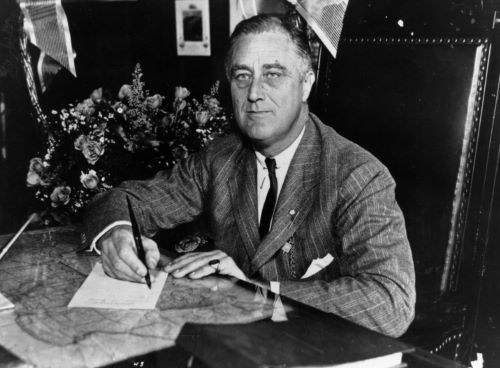
The U.S. is now either in or on the verge of an economic depression. In February, more than 80% of Americans between the ages of 25 and 54 had a job; in April, that number was less than 70%, and it probably will fall even more.
And there are plenty of reasons to believe that this situation will not quickly resolve itself once the threat of the coronavirus pandemic has passed. This will be the worst economic deprivation that Americans have suffered since the 1930s. Already, the number of mothers with young children who say their families can’t afford enough food has risen almost sevenfold.
Many people reason that if the U.S. is in another depression, it’s time for another New Deal. Presumptive Democratic presidential nominee Joe Biden seems to be thinking along these lines, planning a series of bold programs to address both the short-term economic crisis and longer-term weaknesses in the system — just as President Franklin Delano Roosevelt did almost 90 years ago. If Biden is elected and manages to follow through (and that’s a big if), the U.S. could see not just a faster recovery, but progress on issues such as climate change and inequality.
READ ENTIRE ARTICLE AT BLOOMBERG
I’m a Depression Historian. The GOP Tax Bill Is Straight Out of 1929.
Republicans are again sprinting toward an economic cliff.
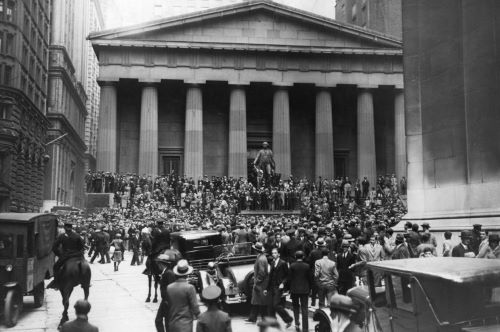
“There are two ideas of government,” William Jennings Bryan declared in his 1896 “Cross of Gold” speech. “There are those who believe that if you will only legislate to make the well-to-do prosperous their prosperity will leak through on those below. The Democratic idea, however, has been that if you legislate to make the masses prosperous their prosperity will find its way up through every class which rests upon them.”
That was more than three decades before the collapse of the economy in 1929. The crash followed a decade of Republican control of the federal government during which trickle-down policies, including massive tax cuts for the rich, produced the greatest concentration of income in the accounts of the richest 0.01 percent at any time between World War I and 2007 (when trickle-down economics, tax cuts for the hyper-rich, and deregulation again resulted in another economic collapse).
Yet the plain fact that the trickle-down approach has never worked leaves Republicans unfazed. The GOP has been singing from the Market-is-God hymnal for well over a century, telling us that deregulation, tax cuts for the rich, and the concentration of ever more wealth in the bloated accounts of the richest people will result in prosperity for the rest of us. The party is now trying to pass a scam that throws a few crumbs to the middle class (temporarily — millions of middle-class Americans will soon see a tax hike if the bill is enacted) while heaping benefits on the super-rich, multiplying the national debt and endangering the American economy.
READ ENTIRE ARTICLE AT THE WASHINGTON POST
What Would the Socialist Who Created the Hedge Fund Think of the GameStop Mess?
When Alfred Winslow Jones created the hedge fund in 1949, the key to its approach was short sales, a practice the GameStop mess returned to public infamy.

Widespread glee broke out recently when a few hedge-funders seemingly got roasted over their own fire pit by a raucous rabble of day traders. That simplistic popular narrative of GameStop will probably die hard because anti-elitist schadenfreude over hedge-funders’ misfortunes may prove too satisfying for some to relinquish.
Animosity toward hedge fund managers has grown since the 2008 financial collapse. At best, they tend to show up on front pages for enriching themselves and their exclusive clientele amid devastating economic calamities. At worst, they seem to have caused those calamities.
This would have frustrated Alfred Winslow Jones, the fascinating, little-known figure widely credited with creating the hedge fund in 1949. Jones, who for much of his life considered himself a socialist, envisioned the hedge fund as a potential market stabilizer, with commensurate benefits for everyone.
READ ENTIRE ARTICLE AT LOS ANGELES TIMES
Inside Every Foreigner
A review of Robert Dallek’s book, “Franklin D. Roosevelt: A Political Life.”
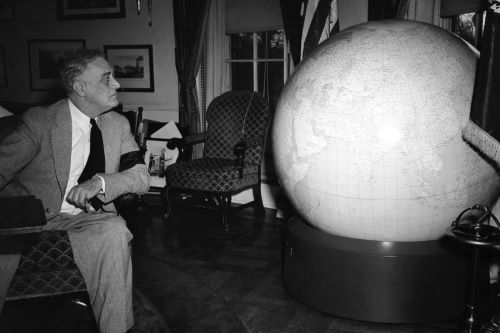
Robert Dallek is troubled by the absence of leadership in contemporary American politics, and his biography of FDR is meant to show us what the real thing looks like. ‘In this time of demoralisation,’ he writes, ‘it seems well to remind Americans that the system has been capable of generating candidates for high office whose commitment to the national interest exceeded their flaws and ambitions.’ Yet he doesn’t answer the questions he raises here: how does ‘the system’ (rather than the accidents of history) generate leaders? How do leaders define the national interest? How do citizens distinguish leadership from demagoguery? Dallek shies away from the ambiguities and resorts to conventional wisdom. His list of leaders includes Harry Truman and John Kennedy – two presidents who risked war by exacerbating tensions with the Soviet Union. Dallek views FDR from the perspective of a mid-century liberal who has apparently made his peace with the warfare state.
As Dallek sees him, FDR, like his cousin Theodore Roosevelt, was an ‘instinctively brilliant politician’ who consulted opinion polls but ‘principally relied on his feel for the public mood’. Descendants of the New York Anglo-Dutch elite, both men got along fine with ordinary voters despite their sense of their own superiority. But Franklin in particular possessed what Dallek calls a ‘capacity to charm people he wished to befriend whatever his real feelings about them’ – a combination of geniality and duplicity that served him well both in private and in public.
He courted his future bride, Eleanor Hall Roosevelt (Theodore’s niece), in secret, intending to present his possessive and suspicious mother with a fait accompli – an engagement. This portended his MO in politics: ‘Never let the left hand know what the right is doing.’ As editor of the Harvard Crimson, he established a reputation for what a classmate called ‘frictionless command’. Theodore’s command was rarely frictionless.
Yet Teddy, the Republican Roosevelt, exercised a profound influence on his Democratic cousin. When FDR was at Groton, ‘Cousin Theodore’ came to visit, and scored a big hit with the students, who embraced Teddy’s strenuous life as the ‘model’, in Dallek’s words, ‘for how every schoolboy should behave’. It was no accident that FDR’s favourite charity was the Boy Scouts. Like Teddy, the young FDR pursued an ideal of virility through vigorous action, and as an aspiring politician styled himself ‘an aristocrat at odds with the bosses’ as well as an enemy of those who cared only for money.
READ ENTIRE ARTICLE AT LONDON REVIEW OF BOOKS
The Day That Richard Nixon Changed U.S. Economic Policy Forever
Fifty years ago, in response to rising inflation, he rejected several long-standing practices. His Keynesian turn holds lessons for today’s economy.
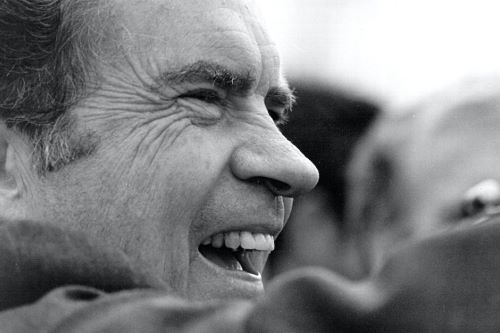
August 15, 1971, was a fateful day in the history of American economic policy: President Richard Nixon imposed far-ranging wage and price controls on the U.S. economy, abolished the fixed exchange rate system that had been in place since 1945, and took other significant actions to deal with inflation, which had become the economy’s overarching problem. In many ways, we are still dealing with the consequences of those actions.
From 1945 until 1971, the economy of the Western world was governed by a system established at a conference in Bretton Woods, New Hampshire, where the victorious powers from World War II (minus the Soviet Union) created rules and institutions designed, above all, to prevent a repeat of the Great Depression. Two principles in particular governed the system. First, there would be widespread free trade (further ensured by the Marshall Plan and the Organization for European Economic Cooperation, now known as the Organization for Economic Cooperation and Development). That is because the Smoot-Hawley Tariff and subsequent beggar-thy-neighbor policies were viewed as a root cause of the depression.
Second, the world monetary system was based on fixed exchange rates to prevent devaluations from being a substitute for protectionist trade policies. (When a currency falls in value, imports become more expensive and exports become cheaper in terms of other currencies.) Major nations fixed their currencies to the dollar, and the dollar was fixed to gold at $35 per ounce to provide an anchor for the system. The International Monetary Fund was established to manage this system and deal with fluctuations in currency values resulting from balance of payments problems.
One of the keys to maintaining this system was capital controls. Major nations did not permit the free flow of capital internationally because it could easily destabilize exchange rates. Businesses and individuals had to get permission to import or export capital, and access to foreign exchange by domestic investors or domestic currency by foreign investors was controlled by the central bank. As a consequence, investors were denied the opportunity to seek higher returns in other countries and were forced to invest domestically.
READ ENTIRE ARTICLE AT THE NEW REPUBLIC
The History of the United States as the History of Capitalism
What gets lost when we view the American past as primarily a story about capitalism?
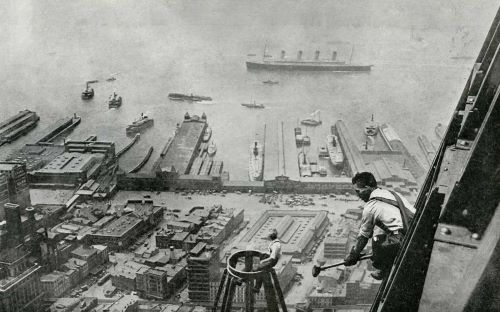
Jonathan Levy’s Ages of Capitalism, one of the first large-scale and synthetic works to pull together much of the new interest and interpretive orientation of this history-of-capitalism field, thereby fills an important intellectual need. It is an ambitious and impressive book, a cut above much of the recent literature not only in its scale but in its determination to construct a historical arc based on clearly articulated concepts. It may also share much more with the older, “consensus” view than Levy or the many other scholars who embrace his perspectives would care to think.
Unlike many who have been writing on the history of American capitalism, Levy explains how capitalism should be defined and identifies its stages of development and geographical variations. Also unlike many of his peers, Levy is not just offering an “economic” history: His book is a study of changing political economies and the attendant cultural manifestations (save for religion). Some of the best pages in the first half of Ages of Capitalism are, in fact, devoted to literature, social thought, and popular culture, to the ways in which Americans grappled with the challenges that capitalist relations and values presented and the ways in which capitalism reshaped the contours of everyday life. Levy has a grasp of economic theory that should satisfy even skeptical readers from the field of economics, together with a rich historical perspective that economists generally lack if not dismiss.
Current scholarly avoidances notwithstanding, capitalism has been understood in a variety of ways: as a form of labor exploitation and surplus extraction; as the privatization of property and the expanding circulation of commodities; as a large and increasingly interconnected web of production and exchange; and as all of these put together in multiple dimensions. Immanuel Wallerstein and, more recently, Sven Beckert have insisted on understanding capitalism as a world system with complex and differentiated parts. Levy does not engage with these interpretations; perhaps for the benefit of general readers, he simply lays out his own. Capitalism, Levy writes, is “capital.” Lest anyone imagine that this is just a tautology, he explains that capital is not a thing but a “process” in which a legal asset is imbued with a pecuniary value in view of its capacity to yield future gain. This is not just the profit motive, which Levy acknowledges has existed from time immemorial; instead, it is a historically specific form of investment in which money, credit, and finance are the crucial components, and the empowerment of capital’s owners (i.e., the capitalists) has been the result.
READ ENTIRE ARTICLE AT THE NATION
Greenbacks, Chits, and Scrip
Alternative currencies flourish in desperate times and situations.
In the late 1950s a group of weary parents in Washington, D.C., came together to solve a vexing problem: how could they score a night out on the town?
Their solution was the Capitol Hill Babysitting Cooperative, whose members would trade child-tending duties. The idea was a hit, but as the co-op’s ranks grew, the group needed a better way to track who was owed what. The parents eventually landed on a scrip system. One piece of scrip provided 30 minutes of babysitting services for a family. When that family took its turn to babysit, it would receive scrip.
Unfortunately, some families started hoarding their scrip. As movement of scrip slowed down, there were fewer transactions, which only made the hoarding problem grow worse—a classic liquidity crisis. The result was an economic downturn in the babysitting economy—people stopped going out on dates. To fix the problem the group issued more scrip, more than this mini-economy could handle, thus setting off an inflationary crisis in which babysitters were hard to find.
In 1977 former co-op members Joan and Richard Sweeney, the latter a U.S. Treasury official, published a witty commentary casting the babysitters’ yo-yoing economy as an allegory for the inflationary jolts the country was experiencing at the time.
Columnist Paul Krugman was struck by the Sweeneys’ article and has used the co-op’s example repeatedly to console readers during times of economic heartburn. “Its story tells you more about what economic slumps are and why they happen than you will get from reading . . . a year’s worth of Wall Street Journal editorials,” Krugman declared in 1998.
READ ENTIRE ARTICLE AT DISTILLATIONS MAGAZINE
The Dawn of Austerity
An interview with the author of “The Capital Order: How Economists Invented Austerity and Paved the Way to Fascism.”
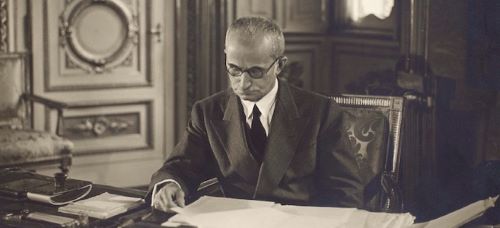
In The Capital Order: How Economists Invented Austerity and Paved the Way to Fascism, Clara E. Mattei brings us back to the dawn of modern austerity politics, just after the First World War. In both liberal Great Britain and fascist Italy, she argues, austerity imposed steep costs in the short term but in the long term proved beneficial to capital. By forcing the working class to rely on the private labor market for survival, austerity ensured the survival of the wage relationship at a moment of anti-capitalist upheaval.
In our current moment, as policymakers are once again entertaining monetary tightening as a means to impose necessary hardship and discipline on working people, The Capital Order is a potent reminder of the cruel rationality of austerity: maintaining stable class relations is worth the price of the economic pain austerity causes.
READ ENTIRE ARTICLE AT DISSENT
At the Altar of the Fed
Celebrating the Federal Reserve as a cockpit for economic steering conceals the reality of where power lies today.
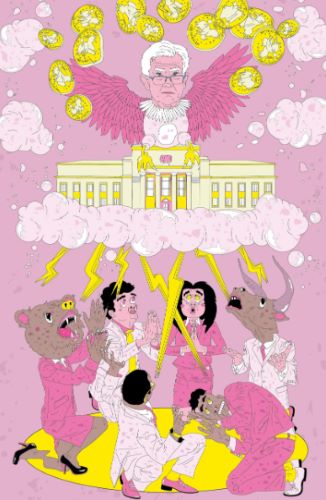
Our world spins on the expedient use of credit—short-term, long-term, hedged, and parlayed. While none of us can know the future, our financial decisions must adhere to some semblance of a plan, and in the United States the market in credit is what we use to order those commitments. Backing it are not only the banks but the Federal Reserve System—the central bank of the United States.
Variously regarded over the decades as the domain of dispassionate economic experts or of rapacious financier-bankers, the Fed has gradually come to acquire a sacred aura of national authority. Three times in living memory it has emerged to exercise an apparently sovereign power over the course of economic and political events: first, with the “Volcker Shock” from 1979 to 1983, in which the Fed’s then-chairman Paul Volcker pushed aggressively for the prolonged recession that ended the last era of persistently high inflation; then, during the 2008 financial crisis, which saw zero percent interest rates and the global refinancing operation of the North Atlantic banking system; and most recently during the financial panic at the onset of the Covid-19 pandemic, when the Fed again assumed its role as a guardian of world liquidity and solvency.
Shaped by this history, the long-divided faiths of American economic opinion today preach worship of a single church. Two recent books of vastly different substance reveal the current consensus about the Fed’s centrality. In The Federal Reserve: A New History, Robert Hetzel, for four decades a staff economist at the Federal Reserve Bank of Richmond and today a visiting scholar at the Federal Reserve Bank of Chicago, tracks fluctuating interest rates and the accompanying changes in economic thought and central bank policy to make the case that the Fed was the common “causal factor” in “each recession and each inflation” over the last century—and will be for those to come. Hetzel is a conservative monetarist in the Milton Friedman tradition. By contrast, Jeanna Smialek, who writes about the Fed for the New York Times, is canny enough to tell us that “people who claim to have it all figured out are oversimplifying.” Yet the title of Limitless: The Federal Reserve Takes on a New Age of Crisis, her pop history and insider-ish narration of the central bank’s dramatic moves during the height of the pandemic, shows that Smialek shares the premise that the Fed is a center of world-creating power.
The two books demonstrate the different ways in which devout Fed worship is part of elite desire to assign responsibility for the economy to powers above elected government. Nowhere is this more evident today than in what passes for public thinking about the challenge of inflation. Since the spring of 2021, when prices began their ascent, the Fed has naturally beckoned popular allegiance to its default leadership in the nation’s anti-inflation program. As President Joe Biden put it last May, his plan to fight rising prices “starts with a simple proposition: respect the Fed and respect the Fed’s independence.” Such paeans assume a kind of omnipotence which is seldom questioned in “respectable” circles. What kind of national response to inflation, which often comes with full employment, could even exist outside of Fed decision-making? If we are thinking about the future, it is a problem we must honestly consider. Unfortunately, as these two books show, a serious consideration of alternatives to central bank unilateralism—once a vital part of American economic life—is not to be found among our professional Fed watchers today.
READ ENTIRE ARTICLE AT THE BAFFLER
The Crash of ’87, From the Wall Street Players Who Lived It
An oral history of the biggest one-day stock market drop in history.
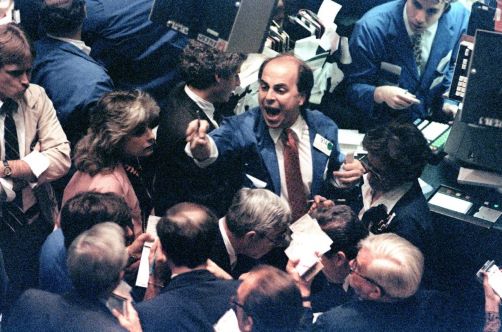
Black Monday, as the day became known, is part of financial history’s fossil record, a divide between old and new markets. It was the first significant instance of computer-driven trading run amok. The nascent equity options market saw assumptions based on the Black-Scholes model overturned and replaced by a more complex world of volatility skews. And Federal Reserve Chairman Alan Greenspan, just two months on the job, got to glimpse a market panic and sell his first “Greenspan Put” under the U.S. equity market.
To mark Black Monday’s 30th anniversary, Bloomberg Markets asked players throughout the marketplace to reflect on the day and its lasting impact. While everyone remembers the 31.25 percent decline in IBM, the real Black Monday story is less about the carnage in equities than what happened elsewhere—in options, futures, and fixed income. There’s also the story of Tuesday, with all its trading and never fully explained (until now!) rally. Most of the people willing to share their memories count themselves as winners who seized the moment as an opportunity not only to make money, but also to insert themselves in the new financial order—Paul Tudor Jones, Stanley Druckenmiller, Nassim Nicholas Taleb. Their story, and the story of Black Monday, is the birth story of modern financial markets—a wild ride of shock, angst, and, for some, glory.
READ ENTIRE ARTICLE AT BLOOMBERG
Legacy and Lessons: Labor
Labor Rising
Is the working class experiencing a new CIO moment?
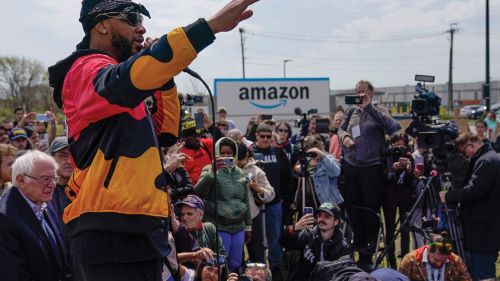
On August 4, hundreds of Amazon warehouse workers in Tilbury, Essex, England, organized their own wildcat strike. Angry at a paltry raise offer—thirty-five pence (forty-seven cents) an hour, when the U.K. inflation rate is currently more than 10 percent—the workers, most of whom are not union members, sat down in one of the canteens at the warehouse, demanding to speak to a supervisor.
“When we got there, all of our managers, area managers, HR, and loss prevention officers were looking at us all,” one of the workers wrote in Notes from Below. “None of them had a clue about what to do with a large group of angry workers.” The strike rolled over the night shift and into the next day, and spread to eleven different Amazon facilities.
While occurring at a warehouse, rather than a factory, the strike raised echoes of the famous Flint sit-down strike of 1936-1937, in Michigan, which led to a historic victory for the United Auto Workers (UAW) at General Motors. It was new tactics like the sit-down strike, tailored for the massive factories of that period, that made the new Congress of Industrial Organizations (CIO) and its member unions, like the UAW, successful, and contributed to the meteoric rise of union power in the 1930s.
Today, organized labor is weakened around the world, particularly in the United States, where less than 12 percent of workers have a union. Unions have struggled to keep up with the changes in production practices, fighting rearguard actions against deindustrialization, and often neglecting the service industry entirely. Public-sector unions have become the backbone of the labor movement, with teachers’ unions being the brightest spot in recent years.
Like GM was, Amazon is the iconic employer of our period of capitalism, one that has been notoriously hard for unions to penetrate. But the rapid rise this year of private-sector, service, and logistics-work unions, most notably the Amazon Labor Union and the Starbucks Workers United campaign, has created a sense of momentum that has many observers looking back to the early days of the CIO for inspiration. What would it take to have a new CIO moment—a wave of organizing that brings millions of new workers into the labor movement, changing the balance of power between employers and the working class and reversing the spiraling inequality of the past few decades?
READ ENTIRE ARTICLE AT THE PROGRESSIVE MAGAZINE
“Ethical Consumption” Used to Mean Something More Than Feeling Smug about Your Purchases
A century ago, it was once motivated by the goal of economic reorganization.
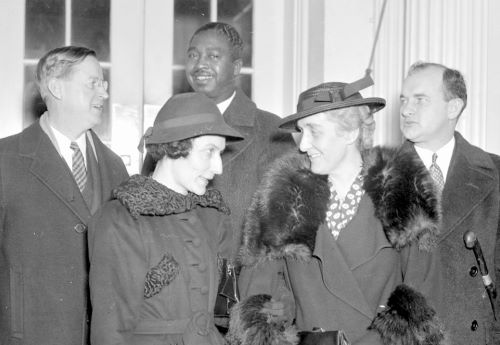
The term “ethical consumerism” is, today, largely associated with individual efforts to make more conscientious choices about what products and services to buy. We might try to buy from companies that market themselves as environmentally friendly or avoid brands that we know are engaged in egregious labor abuses.
These efforts are obviously well-intentioned. But while they may have some minimal impact in pushing individual companies toward less destructive practices for public relations purposes, they do almost nothing to address the systemic problems of climate change, sweatshop labor, and the like. They allow consumers to feel better about their purchases, but efforts at shopping ethically are usually disconnected from any broader vision of social change — and from larger movements that could bring about that sort of change.
It wasn’t always this way. In the United States beginning in the Progressive Era, a movement composed largely of middle- and upper-middle-class women organized under the banner of “ethical consumption” to demand labor protections and minimum-wage laws. Their efforts initially focused on eliminating child labor and addressing the plight of low-wage women workers. But by the New Deal era, voluntary-membership consumers’ groups were fighting for protections for all workers, including collective bargaining rights.
In the 1930s, leaders of groups like the National Consumers’ League (NCL) and the League of Women Shoppers (LWS) — many of whom were social democrats, socialists, or Communists — saw these fights as part of a larger effort to curb the power of big business and empower ordinary people, as both workers and consumers, by raising their “purchasing power.” This was necessary to prevent the kind of egregious inequality that made the Great Depression possible, consumer activists thought, and to thereby strengthen American democracy.
READ ENTIRE ARTICLE AT JACOBIN
The 1933 Conference That Helped Forge Civil Rights Unionism
The radical approach employed by black leftists at the Amenia conference set the stage for the civil rights unionism that would help topple Jim Crow.
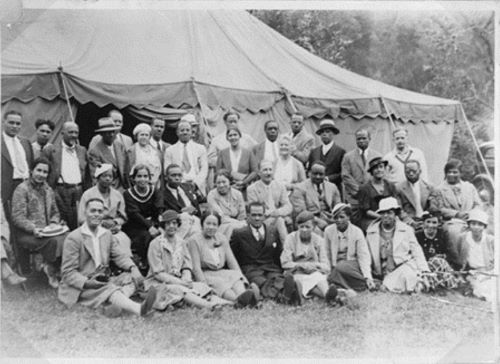
Ninety years ago this month, the National Association for the Advancement of Colored People (NAACP) hosted the 1933 Amenia Conference. Called as the NAACP neared its twenty-fifth anniversary, the group convened about thirty “coming leaders of Negro thought,” in the words of the invitation, to assess the state of the civil rights struggle.
That summer, the nation was mired in the fourth year of the Great Depression. The incoming Democratic administration of Franklin D. Roosevelt had promised a New Deal in response to the economic calamity. NAACP membership was falling. The radical left — particularly the Communist Party, then leading the defense of the nine “Scottsboro boys” falsely accused of raping two white women — was challenging the NAACP’s relevance as the nation’s leading civil rights organization.
NAACP leaders grappled with how to respond. Joel Spingarn and W. E. B. Du Bois, founding editor of the NAACP’s monthly magazine the Crisis, favored hosting a small conference at Troutbeck, Spingarn’s home in Amenia, New York, about ninety miles north of New York City in the Hudson River Valley.
The plan was to gather at Troutbeck for a few days, with large canvas tents and folding cots for sleeping accommodation. Guests were welcome to walk the grounds, enjoy the gardens and swimming hole, and to play some tennis, if they felt game. But mainly they would talk. Spingarn and Du Bois hoped that their discussion would help the NAACP chart a course through the challenges of the Depression era.
They proposed to meet with a selection of the younger generation of black intellectuals and activists. After reaching out to contacts across the United States for suggestions, they sent invitations to a few dozen black women and men between, roughly, twenty and forty years old.
The more radical among them envisioned a mass-oriented approach aligned with the burgeoning labor movement, a departure from the traditional emphasis on racial uplift.
READ ENTIRE ARTICLE AT JACOBIN
Labor Union Activism Is on the Rise, Recalling the Great Depression
Spurred by the pandemic, new groups of workers are pushing to form unions in activism not seen since the 1930s.
Spurred by the pandemic, new groups of workers are pushing to form unions in activism not seen since the 1930s.
With the economic pain of the pandemic, new groups of American workers are pushing to form labor unions at restaurants, stores and warehouses. Experts tell us that this is the biggest surge of activism since the 1930s. At the height of the Great Depression, with as many as 13 million Americans out of work, President Franklin Roosevelt pushed New Deal reforms through Congress, including the 1935 National Labor Relations Act, which guaranteed private sector workers the right to form unions. After a landmark strike at General Motors in 1936, union membership soared, and within two years, nearly two million Americans had staged strikes over working conditions at textile and steel factories.
Michigan Democrats Can Reignite Their State’s Vaunted Labor Tradition
A historic victory in the midterm elections will let Democrats repeal the state’s right-to-work laws and return to its labor roots.
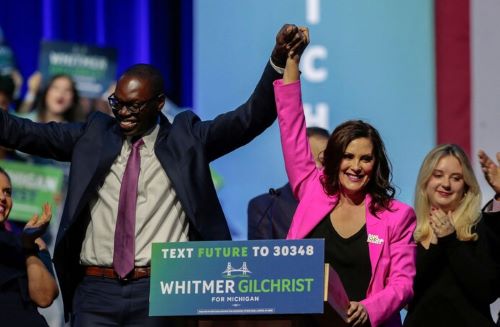
One of the brightest spots on a surprisingly good election night for Democrats came in Michigan. There, they swept the statewide offices on the ballot, captured control of both houses of the state legislature for the first time since 1983 and passed multiple liberal referendums, including one adding protection for reproductive rights to the state constitution.
Barring some change during the next two years, it will be the first time since 1937-1939 that Democrats have had complete control of the legislative process in Michigan for a full term. Reporting indicates that Democrats plan to use this newfound power to repeal the state’s right-to-work laws. That would be a fitting move for a state that was often closely associated with unionism, labor rights and the New Deal. The right-to-work laws epitomize how Michigan — and the United States — shifted away from New Deal labor politics in the second half of the 20th century. Returning to a focus on economic and labor justice in the former hotbed of unionism may help jump-start a return to New Deal labor policies and begin to address our current economic inequalities and struggles.
When Franklin D. Roosevelt won Michigan in 1932, it was the first time the state had ever chosen a Democrat for president. Roosevelt’s ascendancy in Michigan perfectly epitomized the new political coalition he put together outside the South: voters of all races in Detroit and White working-class voters in small and medium-size industrial towns that exemplified the Midwest.
READ ENTIRE ARTICLE AT THE WASHINGTON POST
The Necessary Radicalism of Bernie Sanders
His plan to enhance workplace democracy puts the strike back where it belongs: at the center of political power.
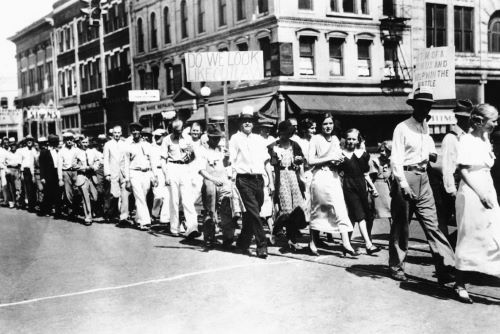
You may have missed it, but late last month, Bernie Sanders’s presidential campaign released the senator’s proposal for revitalizing the American labor movement. If passed into law, his Workplace Democracy Plan would end “at will” employment (employers could no longer dismiss employees for any reason without warning), institute industrywide “sectional” bargaining (versus organizing at individual companies) and curtail “right to work” laws.
Those measures alone would give unions a little room to breathe in an otherwise anti-labor atmosphere. More than half of Americans have a favorable view of unions, but in 2018 only 10.5 percent of workers were unionized. And nearly three years into his presidency, Donald Trump has been unabashedly hostile toward labor, even after selling himself as a tribune of the “forgotten man.”
But the most important parts of Sanders’s plan have to do with striking and other powerful levers. He would give federal employees the right to strike and ban the permanent replacement of any striking workers. He would also end the prohibition on secondary boycotts, which keeps workers from pressuring “neutral” employers — like suppliers and other service providers — in the course of an action against their “primary” employer. This prohibition closes an important avenue for collaboration among workers. Lifting the restriction would open new paths for collective action.
READ ENTIRE ARTICLE AT THE NEW YORK TIMES
Hard Times
The radical art of the Depression years.
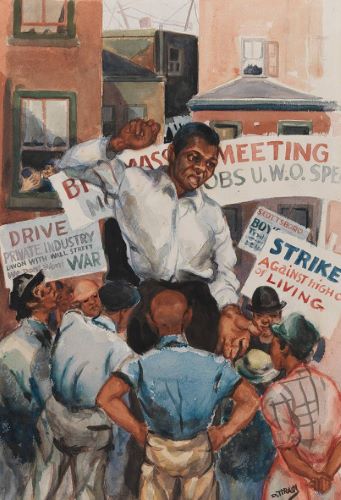
By including Black artists and images of Black workers, “Art for the Millions” challenges other dominant narratives of the Depression, the New Deal, and the art of this period. One such representation appears in a painting by Ben Shahn, an artist who created some of the era’s most arresting imagery.
Though he was happy to describe his work as propaganda, Shahn’s paintings were rarely straightforward. In the painting on view at the Met, the artist depicts a ruddy-complexioned man with his gaze lifted to the horizon. In the distance, scaffolding rises, reflected in the lenses of his welding goggles. Next to him, another welder, who is Black, looks into the middle distance with a furrowed brow. Shahn created this painting in 1943 while working in the graphics division of the CIO’s political action committee—established that year as the first PAC in American history. Reproduced as a poster, the work circulated among union members with the caption “For full employment after the war REGISTER—VOTE.” On its face, this painting presents a vision of racial solidarity within and beyond the workforce, suggesting the power that American workers could wield at the ballot box regardless of their background. Yet there is something more ambiguous at work: Its Black subject occupies an uneasy space in the composition, to the left of the white worker, squeezed into the corner and strangely cropped. I can’t help but feel that he is an afterthought, although compellingly rendered and despite the artist’s own anti-racist bona fides: Shahn was a member of the Committee for the Negro in the Arts, a diverse organization dedicated to the fight against discrimination in theater, the visual arts, music, and beyond.
The Black figure’s marginalization captures a deeper tension of the era: the exclusion of Black Americans from the post–World War II promise. Although Franklin Roosevelt’s 1944 State of the Union address would propose a Second Bill of Rights guaranteeing Americans the right to “a decent home” and “a useful and remunerative job,” state and local authorities enforced segregationist measures that denied Black Americans these advantages. Likewise, returning Black GIs found it difficult to enroll in colleges and gain meaningful employment. Meanwhile, discriminatory federal housing policy and redlining kept Black families from purchasing homes in new suburban developments. However unintentionally, Shahn’s painting recalls this history and reminds us of the unevenness with which the era’s supposedly universal assistance programs were applied.
READ ENTIRE ARTICLE AT THE NATION
The 1929 Loray Mill Strike Was a Landmark Working-Class Struggle in the US South
Murdered during the 1929 Loray Mill strike, Ella May Wiggins became a working-class martyr—and a symbol of labor’s fight to democratize the anti-union South.
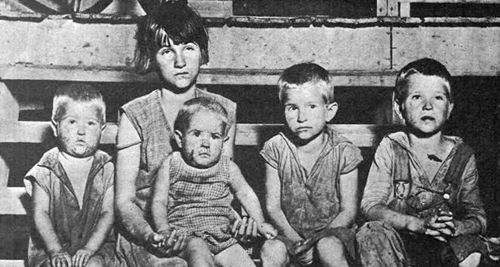
crowd gathered in the rain at the cemetery on the outskirts of Bessemer City, North Carolina, their feet covered in the red clay mud common in the Piedmont region of the Carolinas. A young millworker named Katy Barnett broke out into song:
We leave our home in the morning,
We kiss our children goodbye,
While we slave for the bosses,
Our children scream and cry.
And when we draw our money,
Our grocery bills to pay,
Not a cent to spend for clothing,
Not a cent to lay away. . . .
Now listen to me, workers,
Both women and men,
We are sure to win our union,
If all would enter in.
I hope this will be a warning,
I hope you will understand,
And help us win our victory,
And lend to us a hand.
It is for our little children,
That seem to us so dear,
But for us nor them, dear workers,
The bosses do not care.
But understand, all workers,
Our union they do fear,
Let’s stand together, workers,
And have a union here.
Most of the mourners were likely familiar with the ballad, known as “Mill Mother’s Lament,” but it held new meaning on this rainy September day. The song’s writer, Ella May Wiggins, lay in the primitive casket below as her children, mostly too young to understand what was going on, innocently placed flowers upon it.
READ ENTIRE ARTICLE AT JACOBIN
The Lessons of the Great Depression
In the 1930s, Americans responded to economic calamity by creating a richer and more equitable society. We can do it again.
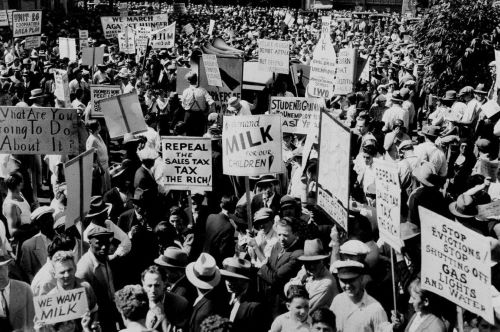
Faced with a crisis of enormous proportion, Roosevelt reinvented how the nation did much of its business, most notably by involving the federal government in areas of American life that previously had belonged to cities, counties, or states—if to any governing authority at all. The New Deal succeeded in implementing policies at the federal level that had been percolating for years in reform circles, or that had been partly implemented by the most progressive states.
To ameliorate the immediate crisis, the federal government funded relief, jobs, and infrastructure. In the longer term, it established a new normal that included a national retirement system, unemployment insurance, disability benefits, minimum wages and maximum hours, public housing, mortgage protection, electrification of rural America, and the right of industrial labor to bargain collectively through unions.
These programs were rife with limitations. Social Security and unemployment insurance were tied to jobs, rather than citizenship; federal backing for mortgages redlined neighborhoods considered too nonwhite or immigrant; whole categories of workers were exempted from Social Security and fair-labor standards, such as those doing domestic and agricultural labor; and many necessities for a decent life, such as paid sick days and health coverage, were left to the discretion of employers or the bargaining brawn of unions. Yet flaws and all, the New Deal constructed a social safety net that undergirded a long period of growth and prosperity.
But if we want to use the New Deal as a model for creating opportunity out of catastrophe, we will need to understand more than just its policies and programs. Building a new and improved United States, post-coronavirus, will require understanding how Roosevelt and his associates, labor leaders and activists, and ordinary Americans combined their efforts during the bleakness of crisis to build a better future. We need to know not just what they did, but how they pulled it off.
The New Deal was experimental and incremental—not ideological. Roosevelt and his advisers were far from the clairvoyant visionaries of legend. They never had a master plan. Rather, in the administration’s first 100 days, they implemented a flurry of laws and regulations. If those programs worked, they remained. If they didn’t, they were dropped, to be replaced by others.
READ ENTIRE ARTICLE AT THE ATLANTIC
Remnants of the New Deal Order
We can only understand the left’s present dilemmas by seeing them in light of the conflicted legacy of the New Deal.
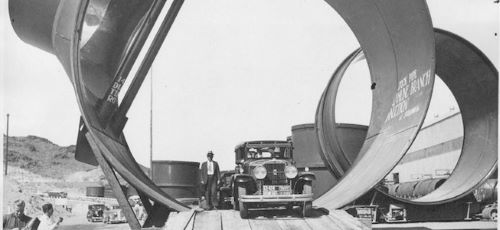
For a long time, our master narrative of U.S. history in the twentieth century has been centered on the rise and fall of the New Deal order: from Roosevelt to Reagan, Keynes to Friedman, General Motors to Walmart. The story is usually one of declension. The flourishing of liberalism, labor unions, and social awareness in the mid-twentieth century ends with the resurgence of laissez-faire at its conclusion. More recent historians have been sharply critical of this narrative, highlighting phenomena that cut across the normal divide: exploring the bipartisan history of the carceral state, the “straight state,” the public-private partnerships that defined the New Deal just as much as neoliberalism, the ways that precarity defined economic life for many (especially African Americans) even at the height of postwar prosperity.
What’s striking is that some of the most perceptive contributions to both interpretations have come from the same person: the historian Steve Fraser, who has staked out a central place in scholarship while conducting most of his career outside of academia. (He holds a PhD but chose to work for many years as a book editor rather than getting a regular teaching job.) Fraser’s work, like that of the late Alan Brinkley, who also wrote for an audience well beyond the university, has been defined by its concern with the limits of New Deal liberalism—its falling off from earlier radical and reform traditions in U.S. politics, the frustrations it embodied, and the ways it fueled the rise of the right. But unlike Brinkley, and many other political historians who may be critical of liberalism but who write from within its framework, Fraser has always sought to approach capitalism in the United States from the perspective of those at the bottom of the social order. His intellectual commitments have reflected a much deeper pessimism about liberalism’s prospects, even as he helped to enshrine the narrative of its “rise and fall” as the key story of the twentieth century.
A new collection of Fraser’s essays, Mongrel Firebugs and Men of Property: Capitalism and Class Conflict in American History, brings together many of his most notable responses to lingering questions about our recent history. What is the legacy of the New Deal? What are the points of similarity and of disconnection between the Gilded Age of the late nineteenth century and our current era of inequality? And is there a way to salvage hope about the future from the remnants of the postwar liberal era?
READ ENTIRE ARTICLE AT DISSENT MAGAZINE
Cameras for Class Struggle
How the radical documentarians of the Workers’ Film and Photo League put their art in the service of social movements.
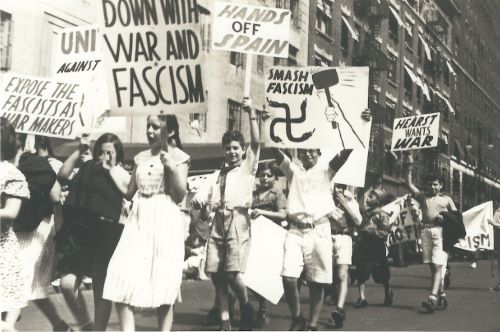
In 1930, Wilhelm Münzenberg—a German Communist Party activist and millionaire media mogul—sent an envoy to New York to set up an office for his pro-Soviet publishing empire. Münzenberg’s most successful newspaper, the weekly Arbeiter-Illustrierte-Zeitung (Worker’s Illustrated Newspaper, or AIZ), had a circulation of around four hundred thousand at the time and a readership of nearly one million. AIZ resembled the other illustrated weeklies that dominated newsstands in the first half of the twentieth century, insofar as it relayed the news visually, pairing eye-catching photo essays with short texts in a bid to make current events engaging for everyman. But where commercial publications like the French pictorial magazine Vu mixed international current events with gossip and fluff, AIZ took a more rigorous approach to the only story its editors felt mattered: the struggle of the proletariat against the bourgeoisie.
In order to tell that story, however, the magazine needed photographers on the front lines of the class war, and the existing photo agencies in the US weren’t getting the shots it needed. When Münzenberg’s delegates arrived in Manhattan, they rented a loft near Union Square and began recruiting photographers for a news association that would circulate images to sympathetic magazines and tabloids around the world, not just to AIZ, but also US outlets like Fortune, the Daily Worker, and Labor Defender.
The group’s formation coincided with a boom in labor organizing and leftist populism, brought on by the misery of the Great Depression and the harrowing exploitation of farm and factory workers at the hands of fat cat industrialists. In the course of the 1930s, nearly 50,000 Mexican and Filipino agricultural workers—often led by organizers from the Communist Party USA—joined successive waves of strikes against the lethal working conditions and meager pay rates of California farms. In the streets of Minneapolis, union teamsters armed with metal pipes defended their general strike in open combat with cops and hired thugs, culminating in the “Bloody Friday” of August 1934, when police officers shot sixty-seven protesters. That same year in San Francisco, striking dockworkers paralyzed waterfront industry for four days, winning union recognition in ports up and down the West Coast.
READ ENTIRE ARTICLE AT ART IN AMERICA
How to Tell the History of the Democrats
What connection does the party of Thomas Jefferson and Andrew Jackson have to the party of Barack Obama and Kamala Harris?

Democrats belong to the oldest mass political party in the world. But what connection does the party of Thomas Jefferson and Andrew Jackson have to the party of Barack Obama and Kamala Harris? Michael Kazin explores this question in his latest book, What It Took to Win. We spoke about the party’s evolving ambitions, its relationship with the left, and the historical origins of the predicaments facing Democrats—and the rest of us—today.
Timothy Shenk: Let’s start with a question that I couldn’t help thinking about while I was reading: do Democrats today even want to know about their own history? They used to be very proudly the party of Jefferson and Jackson, and now they very much are not.
Michael Kazin: Well, they don’t hold Jefferson-Jackson fundraising dinners anymore. I think they do believe that they’re the party of working people—or at least that they should be. I think that’s true across the spectrum; it’s true for both Joe Manchin and AOC. They feel like their claim to power is, “We represent the great majority of people.”
Shenk: With that in mind, it seems like there are two hinge moments in the making of the modern Democratic Party. One takes place in the 1930s, when Democrats became the party of organized labor; the other takes place in the 1960s, when they became the party of civil rights.
Kazin: Don’t forget about the 1890s. Before then, Democrats wanted a weak federal state, partly because the Southern wing didn’t want the federal government to do anything about slavery and, later, Jim Crow. But in the 1890s, the farmer-labor movement of the Gilded Age really made an impression on the Democrats as a whole. Part of that is because the Democratic machines signed up immigrants, who came in in large numbers and needed a lot from the government because they were not getting more than a small wage from their employers. William Jennings Bryan’s campaigns, especially the first one in 1896, moved the party at least rhetorically toward favoring a stronger federal state in order to help small farmers and workers—albeit only white ones. It was the height of the party’s anti-monopoly history.
READ ENTIRE ARTICLE AT DISSENT MAGAZINE
Welcome to Operation Dixie, the Most Ambitious Unionization Attempt in the U.S.
Southern segregation, racism and a militarized police meant the plan was destined to fail.
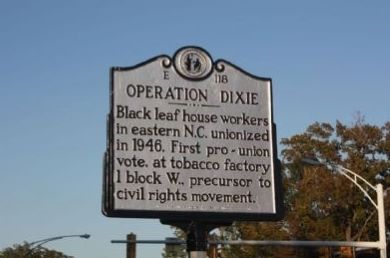
In the hot late summer of 1946, Winston-Salem’s tobacco stemmers took to the picket line. They were mostly black women, all of them poor. They held signs with photographs of the lean-to houses they lived in, underscored with the words “Would you like to live here?” Another picket sign read, “Fat back: 75¢. Our Labor: 50¢. We can’t make ends meet.”
The tobacco company bosses were nowhere in sight, but the strikers knew they had them quaking in their boots. The telltale sign was the police officers hovering nearby, batons in hand, waiting for the slightest disruption so they could descend.
The American labor movement finished the 1930s on a high note. In the Roaring Twenties, an era characterized by rapid wealth accumulation and steep economic inequality, waning membership and unsuccessful organizing drives painted a bleak picture for unions. But labor’s luck began to change during the Great Depression, when working people, fed up with the greed and excesses of American elites, showed renewed interest in organizing their workplaces.
In 1934, three huge and successful strikes happened nearly simultaneously in San Francisco, Minneapolis, and Toledo. The next year, workers got another boost: Roosevelt’s National Labor Relations Act required businesses to recognize and bargain with unions in their midst, so long as those unions followed a set of rules to establish legitimacy. Union membership grew, and as the 1940s approached, there was good reason for optimism.
But corporations don’t roll over easily. In response to the upsurge in union activity, business owners began seeking greener pastures and relocating their factories to places with fewer unions — that way, they could keep benefits threadbare, wages low, costs down, and profits high. In the early 1940s, unions started to face a major problem: businesses in the union-heavy North and Midwest were simply leaving for the largely unorganized South.
Many unions responded to the migration of industry by softening their stance and attempting to show employers they could play nice. But the newly formed Congress of Industrial Organizations (CIO) had a different idea. Maybe the answer to the problem wasn’t to appease the bosses but to organize the South. They called this plan Operation Dixie.
Fragile Juggernaut
Introducing a project on US labor history, exploring what we can learn from 1930s-1950s industrial struggles.
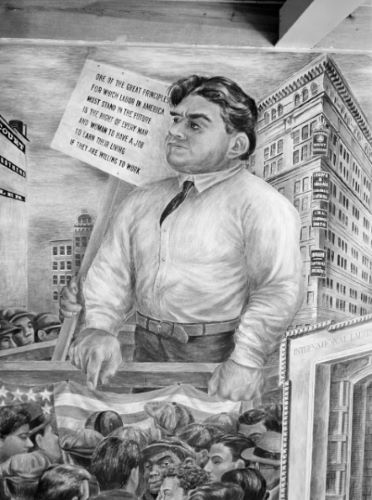
After decades of defeat, workers are on the move again. Many of those interested today in a revived labor movement know that unions once exercised real sway over the national economy and politics in the US. And the distant memory of how the labor movement was built holds great symbolic power: as thousands of union organizers have asked in meetings, how did they do it in the 1930s? The United Auto Workers named and conceptualized their recent, triumphant “Stand-Up Strike” in explicit homage to their union’s breakthrough sitdown strikes of 1936–1937. Beyond the ranks of organized labor, politicians from every tendency speak reverently of a vague midcentury idyll in which (to quote Joe Biden) “unions built the middle class”—specifically in manufacturing, “the sector that built the middle class.”
But in the age of hedge funds and Amazon drones, few interested in labor’s cause are familiar with the facts of how workers actually organized themselves in the era of manufacturing and landline telephones (that’s if you were lucky; in 1936, two American households out of three had no phone at home). Even fewer recognize just how much disruption, and internal struggle within the existing labor hierarchy, it took to organize this power—or the transgressions involved.
That history is the subject of a new project—a podcast series and newsletter under the title of Fragile Juggernaut, produced in conjunction with Haymarket Books—that explores the history of the Congress of Industrial Organizations, or the CIO. At a moment when interest in the possibilities of unions is once again on the minds of the young and in the pages of the news media, it is time to debate the legacy of the national union federation that challenged the labor movement to transform itself into a behemoth capable of shaking the halls of Washington and Wall Street. How and why have US workers related their workplace organization to their political strategy? How have the factors of race, ethnicity, skill, gender, nationality, and religion contributed to workers’ division and their unity? When economic inequality and racism have grown into violence, what role have unions played in relation to the causes of disorder? How have workers reconciled their broadly shared need for collective action on a mass scale—the discipline and bureaucracy required for collective bargaining—with their varying levels of militancy and solidarity across the workforce? How have activist groups contributed to, or undermined, the broader project of working-class organization? What has shaped the relation of union leadership to rank and file in American labor history?
One Parallel for the Coronavirus Crisis? The Great Depression
“The idea that the federal government would be providing emergency relief and emergency work was extraordinary,” one sociologist said. “And people liked it.”
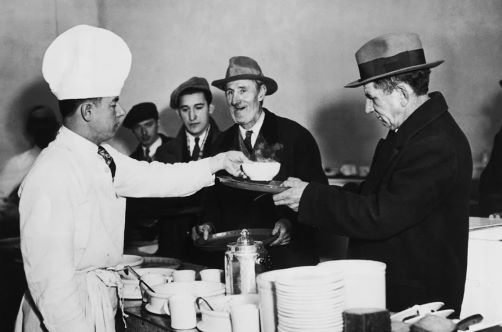
Today’s soaring unemployment, small business failures, and uncertainty about the future are like nothing most of us have seen in our lifetimes. If there’s any useful historical parallel, it might be the Great Depression.
Like the coronavirus-driven economic crash, the Depression devastated a nation where things were already awful for a lot of people. In the 1920s, business owners pretty much did whatever they wanted. The rich got obscenely richer. Progressive, pro-worker policies had little place in national politics. The crisis changed everything. By the end of the 1930s, the country’s unions were stronger than they’d ever been and Congress had passed huge, unprecedented economic policies. The notion that the federal government didn’t have a central place in securing middle-class wellbeing was relegated to the political fringes. But how, exactly did that transformation happen? How did the economic suffering of the 1930s birth a new political and economic era?
“People often look at the Great Depression [and think], ‘Oh, it’s obvious that shattered everything and something new had to happen,’” Elisabeth Clemens, a sociologist at the University of Chicago who studies social movements, told me over the phone. “That overlooks all the work that had to be done to convince people that there actually was a crisis.”
In a 2015 paper for Social Science History, Clemens noted that many regular people were suffering depression-like conditions well before the stock market crash of 1929. Drought devastated small farmers. Urban workers faced frequent bouts of unemployment with inadequate help from municipal relief agencies and private charity. After the crash, it wasn’t at all obvious how much worse things would get—or how much the wealthy and powerful should care. Unemployment didn’t hit its high point, 24.9 percent, until 1933. Clemens writes that President Herbert Hoover responded to the crisis with the tools at his disposal—largely rallying private and local response efforts—and that it was not immediately clear that it wouldn’t be enough.
READ ENTIRE ARTICLE AT JSTOR DAILY
How Government Helped Create the “Traditional” Family
Since the mid-nineteenth century, many labor regulations in the US have been crafted with the express purpose of strengthening the male-breadwinner family.
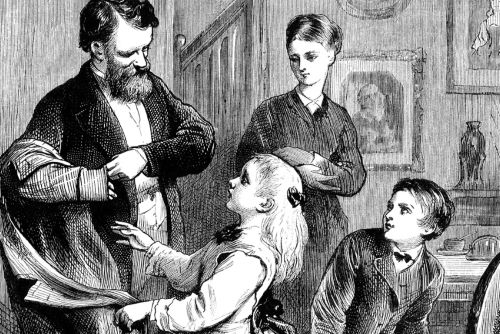
It’s a fundamental tenet of American law that marriage is a private arena that should be kept outside government control. But, legal scholar Arianne Renan Barzilay writes, from a certain angle that’s not really how it works. For more than a century, employment laws have been designed to create a certain model of husband-wife relations.
Barzilay begins her story in the 1840s, a time when most men and women lived and worked on farms so the question of who “goes to work” and who stays home was not yet broadly relevant. However, even then, she writes, American women were becoming increasingly critical of the idea that marriage should be a hierarchical relationship with the husband having control over his wife and children.
Over the decades that followed, some women sued for control over separate property, the right to divorce, and custody over their children. By the late nineteenth and early twentieth century, rising numbers of college-educated women were forgoing marriage, choosing professional work instead. Some commenters fretted that the family as an institution could dissolve.
Meanwhile, increasing numbers of young women were going to work in factories and freely interacting with men in public spaces. Some low-paid women workers received gifts from men they dated or occasionally engaged in some types of sex work—a fact that drew intense concern of many social reformers.
READ ENTIRE ARTICLE AT JSTOR DAILY
The Five-Day Workweek is Dead
It’s time for something better.

The five-day workweek is so entrenched in American life that everything, from vacation packages to wedding prices to novelty signs, is built around it. When you live it every Monday through Friday, year in and year out, it can be hard to imagine any other way.
But there’s nothing inevitable about working eight hours a day, five days a week (or more). This schedule only became a part of American labor law in the 1930s, after decades of striking by labor activists who were tired of working the 14-hour days demanded by some employers. Indeed, one of the biggest goals of the American labor movement beginning in the 19th century was “an attempt to gain time back,” Erik Loomis, a history professor at the University of Rhode Island, told Vox.
Now, there’s a growing conversation about how American workers can take back more of their time. The trauma and disruption of the last three years have prompted a lot of Americans to reevaluate their relationships to work, whether it’s restaurant servers tired of risking their safety for poverty-level wages or office workers quitting rather than giving up remote work. And part of that reevaluation is about the workweek, which many say is due for a reboot. After more than 60 British companies tested a four-day workweek for six months and 90 percent of the companies decided to continue the experiment, even US policymakers such as Bernie Sanders are calling for the change in American work culture.
Over the past few decades, work for many salaried employees has ballooned far beyond 40 hours a week, thanks to a combination of weakened labor laws and technology that allows bosses to reach workers at any time of the day or night. At the same time, low-wage and hourly workers are frequently subject to unpredictable schedules that can change at a moment’s notice, and may not give them enough hours of paid work to live on. Today’s work schedules, with their combination of “overwork and then no work,” in many ways mirror the conditions that preceded the reforms of the 1930s, Loomis said.
Why Did White Workers Leave the Democratic Party?
Historian Judith Stein debunks liberal myths about racism, the New Deal, and why the Democrats moved right.
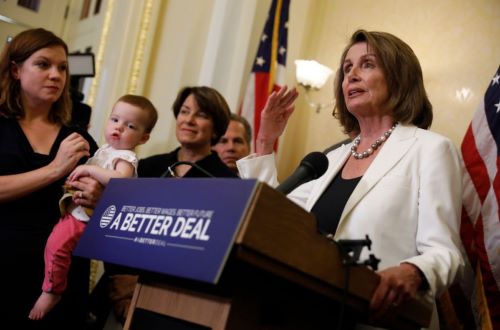
Bernie Sanders makes liberals say the darndest things.
The senator from Vermont spent the better part of 2016 pitching his “socialism” as a continuation of the best in the American reform tradition. And that meant embracing by name the domestic achievements of Franklin Roosevelt and Lyndon Johnson.
Suddenly, however, some liberal pundits weren’t so sure about those legacies. The stubborn old socialist was looking back on the past through rose-colored lenses, they said. And hearing him champion the populist economic reforms of the good old days was enough to make them rethink the foundations of the Democratic Party’s most impressive legislative accomplishment: the New Deal.
Why would elite liberals become so ambivalent about the reforms that, with one brief interruption, helped hand their favored party control of Congress for sixty years? The same set of policies they long touted as the kind of “responsible” and “pragmatic” reforms that radicals could learn from?
The answer: racism. Only white supremacy, these chastened liberals argued, marshaling the work of some recent historians, made both the New Deal and the golden age of organized labor possible.
READ ENTIRE ARTICLE AT JACOBIN
The 1936 Sit-Down Strike That Shook the Auto Industry
Over 136,000 GM workers participated in the strike in Flint, Michigan that became known as ‘the strike heard round the world.’
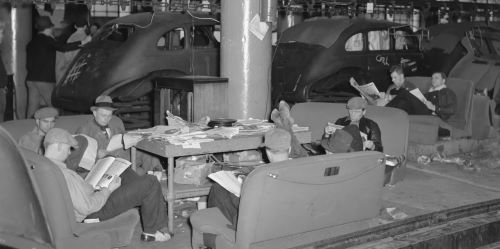
The General Motors body plant in Flint, Michigan was usually a thankless place, filled with loud sounds and the feverish, dangerous work of turning metal into auto bodies. But in January 1937, the sounds of whistling and conversation filled the air. Instead of toiling over dangerous machinery, workers gambled, wrestled and played ping-pong on the usually busy factory floor. “We made a ball out of it,” recalled Earl Hubbard, a GM worker, in an oral history.
The workers weren’t on vacation: They were on strike. Over 44 days in 1936 and 1937, members of the fledgling United Auto Workers union managed to bring an auto behemoth to its knees in a sit-down strike that became one of the most decisive victories in American labor history. Exhausted by the industry’s dangerous demands and sharpened by the Great Depression, over 100,000 auto workers changed labor history without picketing their plant. Instead of walking out, they simply sat down and refused to leave.
Historically, striking workers had risked their lives on the picket lines. Though unions often formed in response to dangerous working conditions, going on strike exposed workers to the danger of physical violence from hired thugs or police that served as companies’ strong-arms. Unions had long struggled to create unions across industries. Instead, craft unions that organized workers across specialties were the norm.
The automobile industry had long discouraged unions. Workers knew they could lose their jobs for trying to organize, and faced corporate spies who reported any pro-union activity back to management. According to historian Timothy P. Lynch, General Motors invested $1 million in surveillance between 1933 and 1936. For many auto workers, unions simply weren’t worth risking their jobs—pay was relatively good, and when workers were laid off they were often rehired at higher rates once a company’s profits rose.
The Square Deal
Some people called it “Welfare Capitalism.” George F. Johnson called it “The Square Deal.”
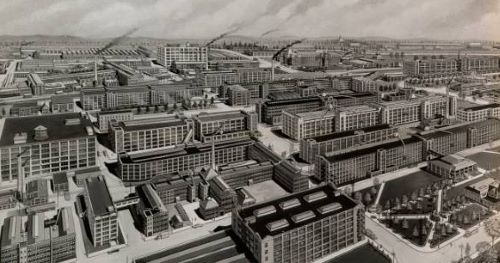
100 years ago, George F. Johnson ran the biggest shoe factory in the world. The Endicott-Johnson Corporation in upstate New York produced 52 million pairs of shoes a year.
But Johnson wasn’t only known for his shoes. Johnson had an unusual theory at the time, about how workers should be treated. He was the first in the shoe business to introduce an eight hour work day. He built libraries, parks, even hospitals and offered his workers free medical care. Every baby born to an employee got a bank book with a $10 deposit – and a pair of shoes.
Some people called it “welfare capitalism.” Johnson had a different name for it. Today on the podcast: The Square Deal.
Collected and curated by Bunk History

